LG Electronics USA SP320 Multi-Band CDMA/GSM/EDGE/UMTS/LTE Phone with Bluetooth and WLAN User Manual
LG Electronics MobileComm USA, Inc. Multi-Band CDMA/GSM/EDGE/UMTS/LTE Phone with Bluetooth and WLAN Users Manual
Users Manual

LG-SP320
User Guide

TOC i
Table of Contents
Getting Started .............................................................................................................................................. 1
Introduction ........................................................................................................................................... 2
About the User Guide ................................................................................................................... 2
Access Instructions on the Phone ................................................................................................ 2
Launch the Quick Help.......................................................................................................... 2
Access Help .......................................................................................................................... 2
Get Support from Sprint Zone ............................................................................................... 3
Feature Highlights ......................................................................................................................... 3
Wide-Angle Cameras ............................................................................................................ 3
FullVision .............................................................................................................................. 3
Water and Dust Resistant Properties ................................................................................... 4
Set Up Your Phone ............................................................................................................................... 6
Parts and Functions ...................................................................................................................... 6
Battery Use ................................................................................................................................... 7
Charge the Battery ................................................................................................................ 8
Nano SIM Card ............................................................................................................................. 9
microSD Card.............................................................................................................................. 10
Insert microSD Card ........................................................................................................... 10
Unmount and Remove the microSD Card .......................................................................... 10
Format microSD Card ......................................................................................................... 11
Turn Your Phone On and Off ...................................................................................................... 11
Use the Touchscreen .................................................................................................................. 12
Activate Your Phone ................................................................................................................... 13
Complete the Setup Screens ...................................................................................................... 13
Basic Operations ................................................................................................................................. 15
Basics .......................................................................................................................................... 15
Home Screen ...................................................................................................................... 15
Phone Settings Menu.......................................................................................................... 15
Portrait and Landscape Screen Orientation ....................................................................... 16
Capture Screenshots .......................................................................................................... 16
Applications ................................................................................................................................. 16
Launch Applications ............................................................................................................ 16
Preinstalled Apps ................................................................................................................ 16
TOC ii
Fingerprint Recognition ............................................................................................................... 18
Precautions for Fingerprint Recognition ............................................................................. 19
Registering Fingerprints ...................................................................................................... 19
Managing Fingerprints ........................................................................................................ 20
Unlocking the Screen with a Fingerprint ............................................................................. 20
Multi-tasking Feature .................................................................................................................. 20
Multi-Window ...................................................................................................................... 20
Overview Screen ................................................................................................................. 20
Phone Number ............................................................................................................................ 21
Airplane Mode ............................................................................................................................. 21
Enter Text .................................................................................................................................... 21
QWERTY Keyboard ............................................................................................................ 22
Phone Keyboard ................................................................................................................. 23
Tips for Editing Text ............................................................................................................ 24
Google Account .......................................................................................................................... 25
Create a Google Account ................................................................................................... 25
Create an Exchange Account ............................................................................................. 26
Sign into Your Google Account ........................................................................................... 27
Factory Reset Protection .................................................................................................... 27
Google Play Store ....................................................................................................................... 28
Find and Install an App ....................................................................................................... 28
Request a Refund for a Paid App ....................................................................................... 29
Update an App .................................................................................................................... 29
Uninstall an App .................................................................................................................. 30
Get Help with Google Play .................................................................................................. 30
Lock and Unlock Your Screen .................................................................................................... 30
Update Your Phone .................................................................................................................... 31
Update Your Phone Software ............................................................................................. 31
Update Your Profile ............................................................................................................. 33
Update Your PRL ................................................................................................................ 33
Your Phone's Home Screen ................................................................................................................ 34
Home Screen Basics .................................................................................................................. 34
Status Bar and Notification Panel ............................................................................................... 35
Status Bar ........................................................................................................................... 35
Notification Panel ................................................................................................................ 37
TOC iii
Customize the Home Screen ...................................................................................................... 37
Change the Wallpaper ........................................................................................................ 37
Add Widgets to the Home Screen ...................................................................................... 38
Add Folders to the Home Screen ....................................................................................... 38
Making Connections .................................................................................................................................... 40
Phone Calls and Voicemail ................................................................................................................. 41
Place and Answer Calls .............................................................................................................. 41
Call Using the Phone Dialer ................................................................................................ 41
Call Emergency Numbers ................................................................................................... 42
Answer Phone Calls ............................................................................................................ 42
In-Call Screen Layout and Operations................................................................................ 43
Place a Call from Contacts ................................................................................................. 44
Call from Call Logs .............................................................................................................. 44
Voicemail ..................................................................................................................................... 45
Voicemail Setup .................................................................................................................. 45
Visual Voicemail Setup ....................................................................................................... 45
Review Visual Voicemail ..................................................................................................... 46
Visual Voicemail Options .................................................................................................... 46
Configure Visual Voicemail Settings ................................................................................... 47
Optional Calling Services ............................................................................................................ 48
Wi-Fi Calling ........................................................................................................................ 48
Caller ID Blocking ............................................................................................................... 49
Call Waiting ......................................................................................................................... 49
Conference Calling ............................................................................................................. 50
Call Forwarding ................................................................................................................... 50
Call Settings Menu ...................................................................................................................... 51
Contacts .............................................................................................................................................. 54
Add Contacts............................................................................................................................... 54
View Contacts ............................................................................................................................. 55
Contacts Screen Layout .............................................................................................................. 55
Edit Contacts ............................................................................................................................... 56
Delete Contacts .......................................................................................................................... 56
Share Contacts ........................................................................................................................... 57
Import Contacts ........................................................................................................................... 57
Back Up Contacts ....................................................................................................................... 57
TOC iv
Messaging ........................................................................................................................................... 58
Messenger .................................................................................................................................. 58
Send a Text Message ......................................................................................................... 58
Send a Multimedia Message (MMS) ................................................................................... 58
Save and Resume a Draft Message ................................................................................... 59
New Messages Notification ................................................................................................ 60
Manage Message Conversations ....................................................................................... 60
Text and MMS Options ....................................................................................................... 61
Gmail ........................................................................................................................................... 62
Create and Send Gmail ...................................................................................................... 63
Open Gmail Messages ....................................................................................................... 63
Use Gmail Labels ................................................................................................................ 64
Archive Gmail Threads ....................................................................................................... 64
Mute Gmail Threads ........................................................................................................... 65
Delete Gmail Threads ......................................................................................................... 65
Search Gmail Messages ..................................................................................................... 65
Report Spam Gmail ............................................................................................................ 65
Add Another Google (Gmail) Account ................................................................................ 66
Switch between Gmail Accounts ........................................................................................ 66
Gmail Settings ..................................................................................................................... 66
Email ........................................................................................................................................... 67
Set Up Email Account ......................................................................................................... 67
Add Email Account .............................................................................................................. 67
Add Exchange ActiveSync Accounts .................................................................................. 68
Create and Send Email ....................................................................................................... 69
Open Email Messages ........................................................................................................ 69
Delete Email Account.......................................................................................................... 70
Manage Your Email Inbox .................................................................................................. 70
Microsoft Exchange Email Features ................................................................................... 71
Internet and Social Networking ........................................................................................................... 73
Data Services General Information (4G LTE and 3G Networks) ................................................ 73
4G LTE ................................................................................................................................ 73
Data Connection Status and Indicators .............................................................................. 74
Chrome Browser ......................................................................................................................... 74
Use the Browser ................................................................................................................. 74
TOC v
Add a Bookmark ................................................................................................................. 74
View Browser History .......................................................................................................... 75
Open New Browser Tabs .................................................................................................... 75
Browser Settings ................................................................................................................. 75
Facebook .................................................................................................................................... 76
Twitter ......................................................................................................................................... 76
Duo .............................................................................................................................................. 77
Global Services ................................................................................................................................... 78
Activate Sprint Worldwide Service on Your Account .................................................................. 78
Your Phone’s SIM Card for International GSM Roaming ........................................................... 78
Enable Global Roaming Mode .................................................................................................... 79
Set the Communications Method for Global Use ........................................................................ 79
Select a Carrier ........................................................................................................................... 79
Make and Receive Worldwide Calls ........................................................................................... 80
Sprint International Voicemail Service ........................................................................................ 80
Set Up Your Voicemail Access Number for International Use............................................ 81
Access Your Voicemail Internationally ................................................................................ 81
International Data Roaming ........................................................................................................ 82
Contact Sprint for Assistance with International Service ............................................................ 83
Connectivity ......................................................................................................................................... 85
Wi-Fi ............................................................................................................................................ 85
Turn Wi-Fi On and Connect to a Wireless Network ............................................................ 85
Wi-Fi Settings ...................................................................................................................... 85
Disconnect Wi-Fi ................................................................................................................. 86
Wi-Fi Direct ......................................................................................................................... 86
Bluetooth ..................................................................................................................................... 87
Enable the Bluetooth Feature ............................................................................................. 87
Pair Bluetooth Devices........................................................................................................ 88
Connect to a Paired Bluetooth Device ................................................................................ 88
Send Information Using Bluetooth ...................................................................................... 89
Receive Information via Bluetooth ...................................................................................... 89
Hotspot ........................................................................................................................................ 90
Tethering ..................................................................................................................................... 90
Transfer Files Between Your Phone and a Computer ................................................................ 91
Content Sharing .......................................................................................................................... 92
TOC vi
Playing Content ................................................................................................................... 92
Sending or Receiving Files ................................................................................................. 92
Using Nearby Devices ........................................................................................................ 93
Apps and Entertainment .............................................................................................................................. 94
Camera and Video .............................................................................................................................. 95
Camera Overview ....................................................................................................................... 95
Take Pictures and Record Videos .............................................................................................. 95
Take Pictures ...................................................................................................................... 96
Record Videos .................................................................................................................... 98
Zoom In or Out .................................................................................................................... 98
Take Various Shots ............................................................................................................. 98
Take Specialty Shots ........................................................................................................ 101
View Pictures and Videos Using Gallery .................................................................................. 103
Edit Pictures .............................................................................................................................. 105
Edit Videos ................................................................................................................................ 106
Share Pictures and Videos ....................................................................................................... 107
Send Pictures or Videos by Email .................................................................................... 107
Send a Picture or Video by Multimedia Message ............................................................. 108
Send Pictures or Videos Using Bluetooth ......................................................................... 108
Share Pictures or Videos via Additional Apps or Social Media ........................................ 109
Share Videos on YouTube ................................................................................................ 109
Camera Settings ....................................................................................................................... 110
Switch Cameras ................................................................................................................ 110
Set Camera Functions ...................................................................................................... 110
Productivity ........................................................................................................................................ 111
Calendar .................................................................................................................................... 111
Add an Event to the Calendar ........................................................................................... 111
View Calendar Events....................................................................................................... 112
Sync Calendars ................................................................................................................. 112
Synchronize an Microsoft Exchange Calendar ................................................................. 112
Navigation Apps ........................................................................................................................ 113
Google Maps ..................................................................................................................... 113
Scout ................................................................................................................................. 113
Google Search .......................................................................................................................... 114
Use Google Search ........................................................................................................... 114
TOC vii
Use Google Voice Search ................................................................................................ 115
Calculator .................................................................................................................................. 115
Clock ......................................................................................................................................... 115
Set Alarms ........................................................................................................................ 115
Additional Clock Features ................................................................................................. 116
Capture+ ................................................................................................................................... 117
QuickMemo+ ............................................................................................................................. 118
File Manager ............................................................................................................................. 119
LG Mobile Switch ...................................................................................................................... 119
HD Audio Recorder ................................................................................................................... 119
Studio Mode ...................................................................................................................... 120
Entertainment and Activities ............................................................................................................. 121
Music ......................................................................................................................................... 121
Music Player ..................................................................................................................... 121
Sprint Music Plus ...................................................................................................................... 122
Back Up Your Downloaded Music Files............................................................................ 123
YouTube .................................................................................................................................... 124
Sprint Zone................................................................................................................................ 124
NASCAR MOBILE .................................................................................................................... 125
LG Health .................................................................................................................................. 125
Settings ..................................................................................................................................................... 127
Networks Settings ............................................................................................................................. 128
Basic Settings ........................................................................................................................... 128
Airplane Mode ........................................................................................................................... 129
Wi-Fi Calling .............................................................................................................................. 129
Wi-Fi Settings ............................................................................................................................ 129
Bluetooth Settings ..................................................................................................................... 129
Mobile Data Settings ................................................................................................................. 129
Call Settings .............................................................................................................................. 130
Share & Connect Settings ......................................................................................................... 130
Tethering Settings ..................................................................................................................... 132
More .......................................................................................................................................... 132
Roaming Settings ...................................................................................................................... 133
Virtual Private Networks (VPN) ................................................................................................. 135
Prepare Your Phone for VPN Connection ........................................................................ 135
TOC viii
Set Up Secure Credential Storage ................................................................................... 135
Add a VPN Connection ..................................................................................................... 135
Connect to or Disconnect From a VPN............................................................................. 136
Sound Settings .................................................................................................................................. 137
Sound Profile............................................................................................................................. 138
Volume ...................................................................................................................................... 138
Ringtone .................................................................................................................................... 138
Ringtone ID ............................................................................................................................... 139
Vibration Strength ..................................................................................................................... 139
Sound with Vibration ................................................................................................................. 139
Vibrate Type .............................................................................................................................. 139
Do Not Disturb .......................................................................................................................... 140
Lock Screen .............................................................................................................................. 140
Apps .......................................................................................................................................... 140
More .......................................................................................................................................... 140
Display Settings ................................................................................................................................ 142
Home Screen ............................................................................................................................ 143
Lock Screen .............................................................................................................................. 145
Theme ....................................................................................................................................... 147
Home Touch Buttons ................................................................................................................ 148
Font Type .................................................................................................................................. 148
Font Size ................................................................................................................................... 148
Bold Text ................................................................................................................................... 148
App Scaling ............................................................................................................................... 149
Display Size .............................................................................................................................. 149
Comfort View............................................................................................................................. 149
Brightness ................................................................................................................................. 149
Always-on Display ..................................................................................................................... 149
Auto-Rotate Screen .................................................................................................................. 150
Screen Timeout ......................................................................................................................... 150
More Settings ............................................................................................................................ 150
General Settings ............................................................................................................................... 152
Language & Keyboard .............................................................................................................. 153
Location ..................................................................................................................................... 154
Accounts & Sync ....................................................................................................................... 154
TOC ix
Cloud ......................................................................................................................................... 154
Accessibility............................................................................................................................... 155
Shortcut Keys ............................................................................................................................ 157
Google Services ........................................................................................................................ 157
Fingerprints & Security .............................................................................................................. 157
Smart Settings .......................................................................................................................... 158
Date & Time .............................................................................................................................. 159
Storage ...................................................................................................................................... 159
Battery & Power Saving ............................................................................................................ 159
Memory ..................................................................................................................................... 159
Smart Cleaning ......................................................................................................................... 159
System Updates ........................................................................................................................ 160
Apps .......................................................................................................................................... 160
Tap & Pay ................................................................................................................................. 160
Backup & Reset ........................................................................................................................ 160
Factory Data Reset ........................................................................................................... 161
About Phone ............................................................................................................................. 162
Getting Help .............................................................................................................................................. 164
For Assistance .................................................................................................................................. 165
Troubleshooting ........................................................................................................................ 165
Sprint Account Information and Help ........................................................................................ 166
Sprint Account Passwords ................................................................................................ 166
Manage Your Account ...................................................................................................... 167
Sprint Support Services .................................................................................................... 167
Anti-Theft Guide ........................................................................................................................ 168
Copyright Information ................................................................................................................ 169
Index .......................................................................................................................................................... 170

1
Getting Started
The following set of topics will introduce you to your phone, help you get set up with service, provide an
overview of the phone screen, and get you started with basic phone operations.

Introduction 2
Introduction
The following topics describe the basics of using this guide and your new phone.
About the User Guide
Thank you for purchasing your new LG SP320. The following topics explain how best to use this guide to
get the most out of your phone.
Before Using Your Phone
Read the Important Information booklet that was packaged with your phone thoroughly for proper usage.
Accessible services may be limited by subscription contract conditions.
Descriptions in the User Guide
Note that most descriptions in this guide are based on your phone's setup at the time of purchase. Unless
otherwise noted, instructions begin from the phone's home screen, which is displayed by tapping the
Home key . Some operation descriptions may be simplified.
Screenshots and Key Labels
Screenshots in the user guide may appear differently on your phone. Key labels in the user guide are
simplified for description purposes and differ from your phone's display.
Other Notations
In the user guide, the phone may be referred to either as "phone," "device," or "handset." A microSD™ or
microSDXC™ card is referred to as an "SD Card" or a "memory card."
Access Instructions on the Phone
These topics will help you find help on your new phone.
Launch the Quick Help
Use the Quick Help to get help about the device usage.
■ Tap > Quick Help .
Access Help
Use each app’s Help menu to learn about the app.
■ In each app, tap > Help to access help.

Introduction 3
Get Support from Sprint Zone
In addition to your phone’s built-in Help menu, you can also access support for your phone and service
through the preloaded Sprint Zone app.
1. Tap > Sprint Zone .
2. Tap an option on the main screen or tap Menu and select from a full list of options.
Note: Sprint Zone categories and options are subject to change. Check back frequently for new content
and updates.
Feature Highlights
The LG SP320 has the following key features.
Wide-Angle Cameras
Capture photos with a wider background using both the rear and front wide-angle lenses—for more
inclusive scenic shots or to get all your friends in.
1. Tap > Camera .
2. Access either the rear or front camera.
3. Tap to switch to Wide Angle.
On the front camera viewfinder, tap to switch to Wide Angle.
Note: See Camera Overview for more details about Camera.
Front Camera
Rear Camera
FullVision
The enhanced screen ratio allows you to take full advantage of your apps, providing an easy, one-handed
user experience and useful information at a glance.
On the Email, Calendar and Music app, rotate the screen horizontally to view in an optimized side-by-side
view.
Note: Not all applications feature this side-by-side view.

Introduction 4
Water and Dust Resistant Properties
This product is water and dust resistant in compliance with the Ingress Protection rating IP68.
Your product has undergone testing in a controlled environment and is proven to be water and dust
resistant in certain circumstances (meets the requirements of classification IP68 as described by the
international standard IEC 60529 - Degrees of Protection provided by Enclosures [IP Code]; test
conditions: 15-35ºC/59-95ºF, 86-106kPa, 1.5 meters, for 30 minutes).
Note: Do not expose the device in conditions that are different from the test conditions. Results may vary
in actual use.
Warning: Despite a rating of IP68, your device is not impervious to conditions not tested in LG’s
controlled environment. Please note that any damages that occur due to such causes changes the color
of the LDI (Liquid Damage Indicator). If the color of LDI located inside the product changes, the product is
to be considered ineligible for any free-of-charge repair services provided under the product's limited
warranty. Avoid exposing the product to environments with excessive dust or moisture. Do not use the
product in the following environments:
● Do not immerse the product in any liquid chemicals (soap, etc.) other than water.
● Do not immerse the product in salt water, including seawater.
● Do not immerse the product in a hot spring.
● Do not swim with this product.
● Do not place the product directly on sand (such as at a beach) or mud.
● Do not immerse your product in water deeper than approximately 1.5 meters. Do not
immerse your product in water for longer than 30 minutes.
If your product becomes wet, be sure to wipe the microphone, speaker, and stereo jack with a dry cloth
before use.
● Should your product or your hands become wet, dry them before handling the product.
● Do not use the product in places where it may be sprayed with high pressure water (e.g. near a
faucet or shower head) or submerge it in water for extended periods of time, as the product is not
designed to withstand high water pressure.
● This product is not resistant to shock. Do not drop the product or subject it to shock. Doing so
might damage or deform the main unit, causing water leakage.
● The product’s water and dust resistant features may be damaged by dropping or receiving an
impact.
● If the product gets wet, use a clean, soft cloth to dry it thoroughly.
Introduction 5
● The touch screen and other features may not work properly if the device is used while wet.
● Your product is water resistant only when the SIM/Memory card tray is properly inserted into the
product.
● Do not open or close the SIM/Memory card tray while the product is wet or immersed in water.
Exposing the open tray to water or moisture may damage the product.
● The SIM/Memory card tray contains rubber packing to help prevent dust, water, or moisture from
entering the product. Do not damage the rubber packing as this may allow dust, water, or
moisture to enter your product and cause damage.
Warning: Failure to follow the provided instructions may invalidate your device’s limited warranty.
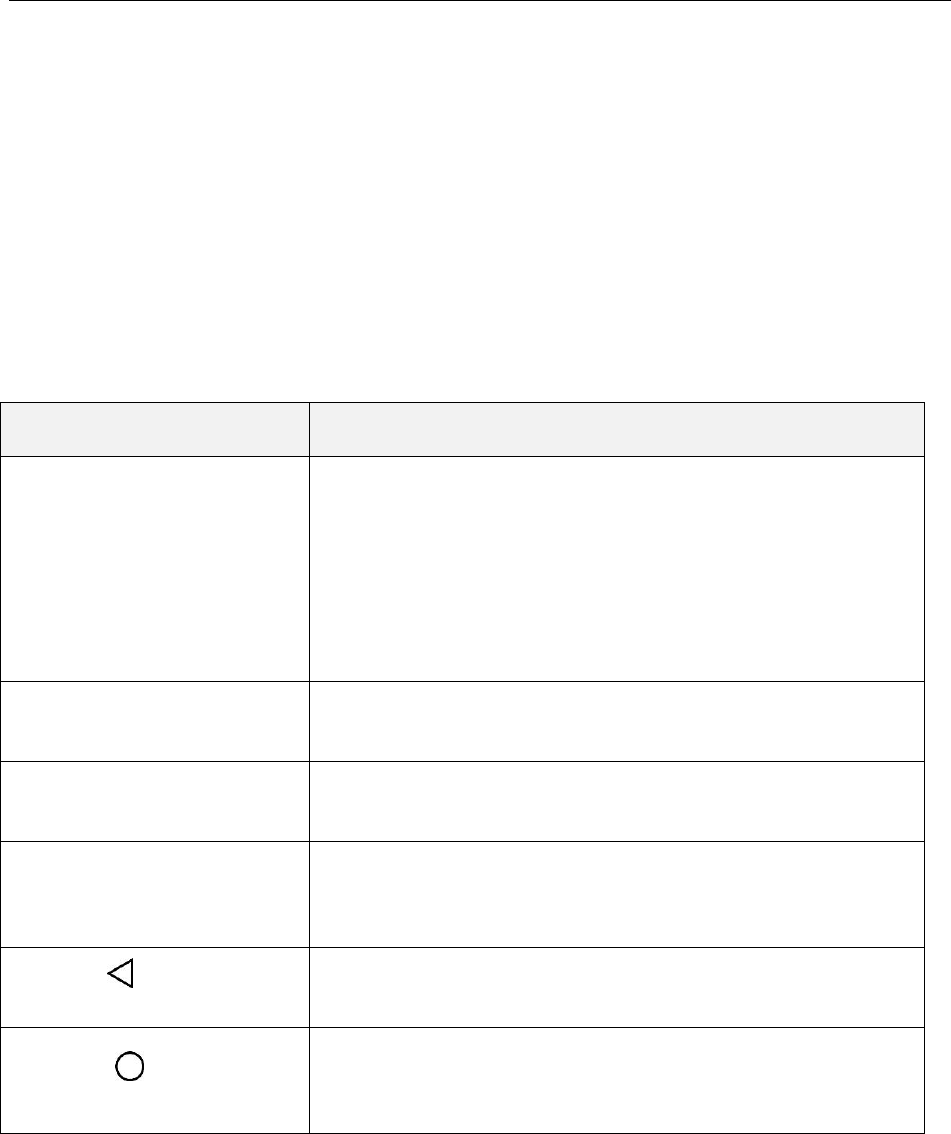
Set Up Your Phone 6
Set Up Your Phone
The following topics give you all the information you need to set up your phone and wireless service for
the first time.
Parts and Functions
These topics illustrate your phone’s primary parts and key functions.
Note: Your phone's screens and apps layouts are subject to change. This user guide uses sample
images only.
Phone Layout
The following illustration outlines your phone’s primary external features and buttons.
Part
Description
Proximity/Ambient Light
Sensor
Senses proximity towards other objects (such as your head) so
that touch commands are not accidentally activated during a call.
Note: Please be careful not to cover the sensors with a protective
film, pouch, or a protective case not authorized by LG.
The ambient light sensor analyzes the ambient light intensity when
the auto-brightness control mode is turned on.
Front Camera Lens
Allows you to take pictures and videos of yourself. Also lets you
participate in video chats.
Volume Keys
Allows you to adjust the ringer and media volumes, or to adjust the
in-call volume during a call.
Touchscreen
Displays all the information needed to operate your phone, such
as the applications, call status, the Contacts list, the date and time,
and the signal and battery strength.
Back Key
Returns to the previous screen. It also closes pop-up display items
such as menus and dialog boxes.
Home Key
Returns to the home screen. If you're already viewing one of
extension canvases, it opens the central home screen. Touch and
hold to access Google Assistant.

Set Up Your Phone 7
Overview Key
Allows you to access recently-used apps. While using an app,
touch and hold to use two apps at the same time with the Multi-
Window feature.
Nano-SIM/Memory Card Tray
Holds the Nano-SIM card and a memory card.
3.5mm Headset Jack
Allows you to plug in a headset for convenient, hands-free
conversations.
Earpiece
Lets you hear the caller and automated prompts.
Microphone
Transmits your voice for phone calls or records your voice or
ambient sounds for voice recordings and videos.
Rear Camera Lens
(Wide-angle)
Lets you take pictures and record videos in a wide angle.
Rear Camera Lens (Standard)
Lets you take pictures and record videos.
Power/Lock Key with
Fingerprint Sensor
Locks the screen. Press and hold to open the phone options menu
for the following options: Power off, Power off and restart, and
Turn on/off Airplane mode.
Turn on the fingerprint recognition feature to simplify the process
of unlocking the screen. See Fingerprint Recognition for details.
Speaker
Lets you hear the different ringers and sounds. The speaker also
lets you hear the caller’s voice in speakerphone mode.
Charger/Accessory Port
Allows you to connect the phone charger or an optional USB
cable.
Flash
Helps you take pictures and video in dim lighting.
CAUTION! Inserting an accessory into the incorrect jack may damage the phone.
Battery Use
The following topics explain how to charge your phone’s battery.
Warning: This device has a non-removable battery. Do not attempt to remove the back cover.
Warning: Do not charge while the device or charging cable is wet or contains moisture. This can cause
fire, electric shock, injury or damage to device.

Set Up Your Phone 8
Charge the Battery
Your phone is equipped with a Li-Ion battery. It allows you to recharge your battery before it is fully
drained. The battery provides up to 28 hours of continuous digital talk time.
You can charge your phone’s battery using either the included the fast charge adapter or via a USB
connection with your computer.
Charge Using the Fast Charge Adapter
1. Plug the USB cable into the charger/accessory port at the bottom of your phone.
2. Plug the other end of the USB cable into the fast charge adapter.
3. Plug the fast charge adapter into an electrical outlet.
The battery status icon is changed to charging when charging starts. The light goes off
when the battery is fully charged. Fully charging a battery may take up to four hours.
4. After charging, disconnect the phone from the charger.
Unplug the fast charge adapter from the outlet, and remove the USB cable from the phone
and the adapter.
Note: Always unplug the charger from the wall socket after the phone is fully charged to save
unnecessary power consumption of the charger.
Note: Do not use third party chargers with your device as they may not support fast charging and may
cause damage to your device.
Charge Using a PC Connection
Before using a PC connection to charge your phone, ensure that the computer is turned on. Depending
on the type of connection, your phone’s battery may not charge.
1. Insert the small end of the USB cable into the charger/accessory port at the bottom of your phone.
2. Insert the large end of the USB cable into an external USB port on your computer.
3. After charging, remove the USB cable from both the phone and the computer.
Warning: Make sure to use the USB cable provided; do not use third party USB cables or chargers with
your device. The LG limited warranty does not cover the use of third party accessories.
Warning: Failure to follow the instructions in this guide and improper use may damage the device.
Warning: Using the device when it is charging may cause electric shock. To use the device, stop
charging it.
Set Up Your Phone 9
Nano SIM Card
The Nano SIM card is an IC (Integrated Circuit) card containing phone number and other customer
information. Your phone’s SIM card is preinstalled and should only be accessed if directed by a customer
service representative.
Handling the Nano SIM Card
Keep the following in mind when handling a Nano SIM card.
● You are responsible for any damage caused by inserting the SIM card in another-brand IC card
reader, etc. Sprint is not responsible in such a case.
● Always keep the IC chip clean.
● Wipe clean with a dry, soft cloth.
● Avoid applying labels. May damage the Nano SIM card.
● See instructions included with the Nano SIM card for handling.
● The Nano SIM card is the property of Sprint.
● The Nano SIM card is replaceable (at cost) in case of loss/damage.
● Return the Nano SIM card to Sprint when cancelling your subscription.
● Returned Nano SIM cards are recycled for environmental purposes.
● Note that Nano SIM card specifications and performance may change without notice.
● It is recommended that you keep a separate copy of information that is stored on the Nano SIM
card. Sprint is not responsible for damages from stored information that is lost.
● Always follow emergency procedures to suspend service if your Nano SIM card or phone (Nano
SIM card inserted) is lost/stolen. For details, contact Customer Service.
● Always power off the phone before inserting/removing a Nano SIM card.
Insert a Nano SIM Card
Follow these instructions to insert a Nano SIM card. Remember to power off your phone before inserting
a Nano SIM card.
Note: Your phone’s SIM card is preinstalled. These instructions are for reference only.
1. Gently insert the ejection pin into the hole on the card tray and then pull out the ejected tray.
2. Place the Nano SIM card into the correct section of the tray.

Set Up Your Phone 10
Place gently with gold IC chip facing downward.
3. Insert the card tray back into the slot.
Note: Always use a genuine Nano-SIM card supplied by the service provider.
microSD Card
Your phone supports the use of an optional microSD card (not included) to expand its storage capacity. It
supports cards up to 2TB. Some cards may not operate properly with your phone.
microSD card Cautions
Data: Information stored on the microSD card can become lost or changed accidently or as a result of
damage. It is recommended that you keep a separate copy of important data. Sprint is not
responsible for damages from data that is lost or changed.
Reading/Writing Data: Never power off while reading or writing data.
Battery Level: A low battery charge may prevent reading/writing to a microSD card.
Handling microSD card: Use/store microSD cards away from the reach of infants. May cause
choking if swallowed.
Insert microSD Card
Follow these steps to insert an optional microSD card (not included). Make sure to power your phone off
before inserting or removing a microSD card.
1. Gently insert the ejection pin into the hole on the card tray and then pull out the ejected tray.
2. Place the memory card into the correct section of the tray, with the arrows oriented correctly.
When inserting the SIM card, make sure that the metallic contacts face down.
3. Insert the card tray back into the slot.
Unmount and Remove the microSD Card
Follow these instructions to unmount and remove a microSD card. Always unmount the microSD card
before removing it from your phone, and always power the phone off before inserting or removing a
microSD card.
1. Tap > Settings > General tab.
2. Tap Storage.
3. Tap .
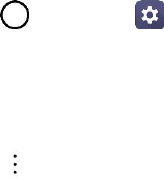
Set Up Your Phone 11
The status of the SD card changes from Ejecting to Ejected. The card is now unmounted.
4. Press and hold the Power/Lock key and then tap Power Off > POWER OFF to turn off your
phone.
5. Gently insert the ejection pin into the hole on the card tray and then pull out the ejected tray.
6. Take the microSD card out of the tray to remove it.
Format microSD Card
When you insert an optional microSD card for the first time, it is recommended that you format it on your
phone.
Note: Formatting an SD card permanently erases all data stored on the card. It is recommended you back
up any card contents to your computer before formatting the SD card.
1. Tap > Settings > General tab.
2. Tap Storage.
3. Tap SD card.
4. Tap > Storage settings.
5. Tap Format > FORMAT.
All data on the microSD card is erased, and the card is formatted for use on your phone.
Turn Your Phone On and Off
The instructions below explain how to turn your phone on and off.
Turn Your Phone On
■ Press and hold the Power/Lock key.
Your phone will power on. Depending on the settings, you may see the lock screen.
See Lock and Unlock Your Screen and Select Screen Lock for information about using the
screen lock.
The first time you turn the phone on, you will see the setup screens. See Complete the Setup
Screens for details.
If your phone is not yet activated, see Activate Your Phone for more information.

Set Up Your Phone 12
Turn Your Phone Off
1. Press and hold the Power/Lock key to open the phone options menu.
2. Tap Power off to turn the phone off.
3. Tap POWER OFF to confirm.
Your phone will power off.
Your screen remains blank while your phone is off (unless the battery is charging).
Tip: The KnockON feature allows you to double-tap the screen to easily turn it on or off.
Use the Touchscreen
Your phone’s touchscreen lets you control actions through a variety of touch gestures.
Tap
When you want to type using the onscreen keyboard, select items onscreen such as application and
settings icons, or press onscreen buttons by simply tapping or touching them with your finger.
Touch and Hold
To open the available options for an item (for example, a contact or link in a Web page), touch and hold
the item.
Swipe or Slide
To swipe or slide means to quickly drag your finger vertically or horizontally across the screen.
Drag
To drag, touch and hold your finger with some pressure before you start to move your finger. While
dragging, do not release your finger until you have reached the target position.
Flick
Flicking the screen is similar to swiping, except that you need to swipe your finger in light, quick strokes.
This finger gesture is always in a vertical direction, such as when flicking the contacts or message list.
Rotate
For most screens, you can automatically change the screen orientation from portrait to landscape by
turning the phone sideways. When entering text, you can turn the phone sideways to bring up a bigger
keyboard. See Touchscreen Keyboards for more details.
Note: The Auto-rotate switch needs to be selected for the screen orientation to automatically change. Tap
> Settings > Display tab > Auto-rotate screen.

Set Up Your Phone 13
Tip: You can also access the screen rotation setting from the notification panel. Drag the status bar down
and tap / (Rotation) to select or deselect the option.
Pinch and Spread
“Pinch” the screen using your thumb and forefinger to zoom out or “spread” the screen to zoom in when
viewing a picture or a Web page. (Move fingers inward to zoom out and outward to zoom in.)
Activate Your Phone
Follow the instructions below to activate your phone if it has not already been activated. Depending on
your account or how and where you purchased your phone, it may be ready to use or you may need to
activate it on your Sprint account.
● If you purchased your phone at a Sprint Store, it should be activated and ready to use.
● If you received your phone in the mail, and it is for a new Sprint account or a new line of service,
it will activate automatically when you first turn it on.
● If you’re swapping phones for a number already on your Sprint account, go to sprint.com/activate
and follow the instructions.
To confirm activation, make a phone call. If your phone is still not activated, visit sprint.com/support for
assistance. If you do not have access to the Internet, call Sprint Customer Service at 1-888-211-4727
from another phone.
Tip: Do not press the Power/Lock key while the phone is being activated. Pressing the Power/Lock key
cancels the activation process.
Note: If you are having any difficulty with activation, visit sprint.com/support.
Complete the Setup Screens
The setup screens help you set up certain features and preferences on your phone. Once your phone has
been turned on, you will see a Welcome message. You can then complete the setup process.
Note: You may be able to complete the setup screens before your phone has been activated on your
account.
1. On the configuration screen, touch NEXT to get started.
2. Follow the onscreen instructions to complete each section. For each topic, you will have the
option to skip it and continue to the next screen.
Language Selection - Select a desired language.
Set internet connection - If prompted, follow the prompts to sign in to an available Wi-Fi®
network. For secured Wi-Fi networks, you will need to enter a password. See Wi-Fi for more
details.
Set Up Your Phone 14
Set up your LG-LS993 - You can choose to restore a backup or copy from a device or set up
as a new device.
Google Account - Sign in or set up a Google Account.
Google services - Read all of the information for the available Google Services and, if you
agree, tap NEXT. Otherwise, uncheck the options and tap NEXT.
• Help apps find your location - Helps apps determine location. This means sending
anonymous location to Google, even when no apps are running. Tap Learn more for
additional information.
• Improve location accuracy - Allows apps and services to scan for Wi-Fi networks even
when Wi-Fi is off.
• Help improve your Android experience - Allows your device to send diagnostic and
usage data to Google automatically. Tap Learn more for additional information.
Add your fingerprint - Prevent others from using this phone without your permission by
activating device protection features.
Legal documents - Read all of the information about legal documents.
• EULA (End-User License Agreement) - Read the End-User License Agreement and tap
the I agree check box if you agree to the terms.
• Low power location estimation - Read the Low power location estimation information
and tap the I agree check box if you agree to the terms.
3. Tap DONE. Your setup is now complete. Follow the onscreen instructions to learn about basic
touch menu navigation, view tutorials, or just get started.

Basic Operations 15
Basic Operations
The following topics outline basic features and operations of your phone.
Basics
The following topics offer an overview of your phone’s basic operations.
Home Screen
Most of your phone’s operations originate from the home screen.
■ From any screen, tap the Home key to display the home screen.
For information about using the home screen, see Home Screen Basics.
Select Options and Navigate Screens
Tap icons, onscreen keys, and other items to open or activate the assigned function.
■ Tap Back to return to the previous screen.
Menu Operations
You can display options menus using the menu key, any app-specific menu icon, or by tapping and
holding a screen area, depending on your current app.
■ Tap to view available settings and options.
Recent Applications
You can display a list of recently used applications using the Overview key.
■ Tap Overview to view a list of recently used applications.
Phone Settings Menu
You can customize your phone’s settings and options through the Settings menu.
■ Tap > Settings .
– or –
Drag the status bar down and tap > Settings .
For more information, see Settings.

Basic Operations 16
Portrait and Landscape Screen Orientation
The default orientation for your phone’s screen is portrait (vertical), but many apps will change to
landscape orientation (widescreen) when you rotate the phone sideways.
Note: Not all screens will adjust for landscape orientation.
Turn Screen Rotation On or Off
1. Pull down the status bar to display the quick settings menu.
2. Tap Rotation / to turn the option on or off.
You may need to scroll left or right to see the Screen rotation option.
Note: You can also set the rotation option from the main settings menu. Tap > Settings > Display
tab > Auto-rotate screen.
Capture Screenshots
You can use your phone’s power and volume keys to capture screenshots.
■ Press and hold the Power/Lock key and Volume Down key at the same time to capture a
screenshot of the current screen.
The current screenshot will be captured and stored in the Screenshots album in the phone’s
Gallery. Tap > Gallery .
Applications
The following topics describe how to access the applications (apps) list and launch apps on your phone.
Launch Applications
All installed apps can be accessed and launched from the home screen.
1. Tap .
2. Tap an app icon to launch the corresponding application.
The application opens.
Preinstalled Apps
The following table outlines the primary apps that have been preinstalled on your phone.
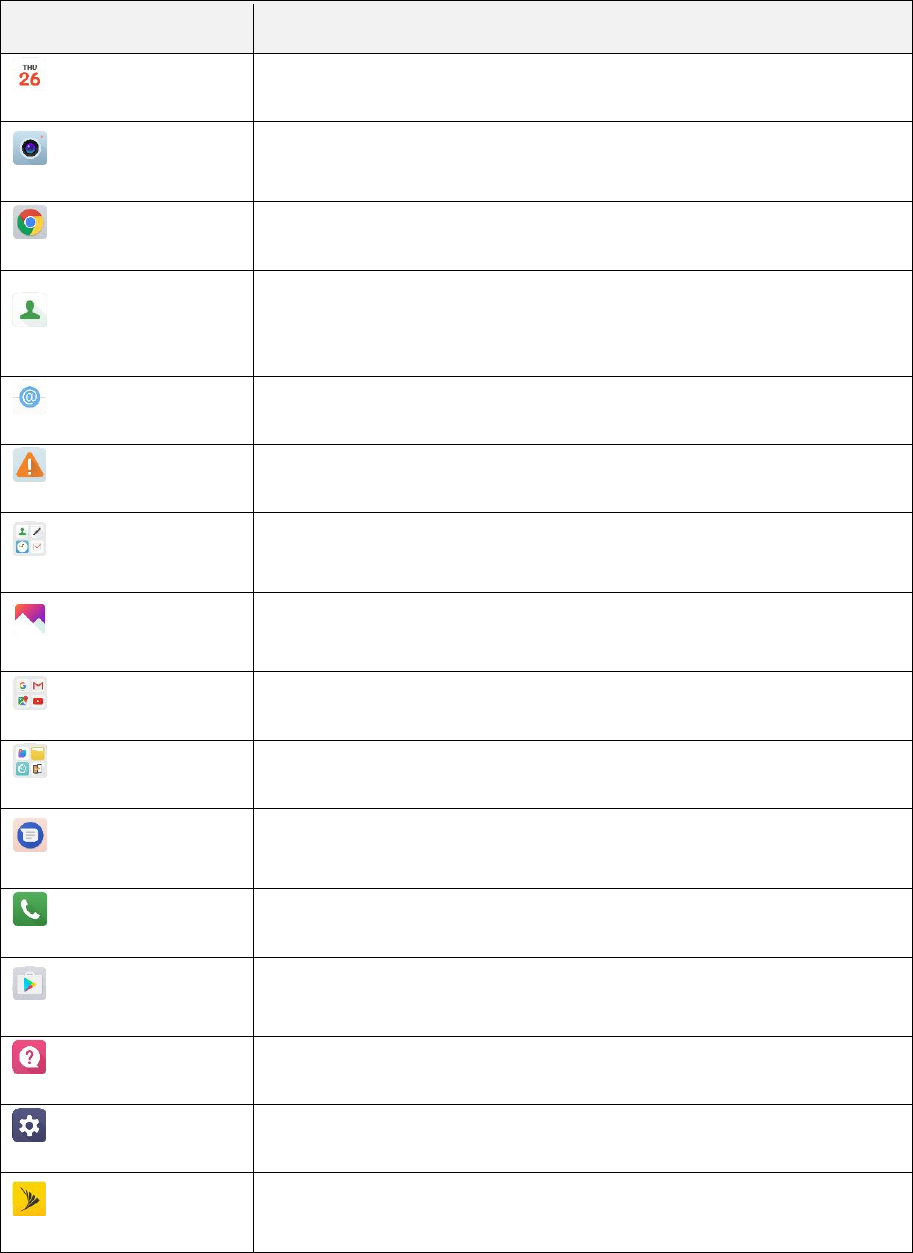
Basic Operations 17
App
Function/Service
Calendar
Launch the Calendar app. See Calendar.
Camera
Take pictures and record videos using the front and rear cameras. See
Camera Overview.
Chrome
Browse the Internet. See Chrome Browser.
Contacts
Displays the Contacts that can be synchronized with your phone from
either your Google or Outlook account. Contacts can only be synched
to a managed account. See Add Contacts.
Email
Launch the Email app. See Email.
Emergency Alert
Provides access to your emergency messages and its settings.
Essentials
Access essential apps such as Contacts, QuickMemo+, Clock, Tasks,
Music, Calculator, LG Health, and HD Audio Recorder.
Gallery
Displays a Gallery of camera images and video saved on your phone.
See View Pictures and Videos Using Gallery.
Google
Access the Google applications.
Management
Access power and storage space management apps.
Messenger
Provides access to your text and multimedia messages. See
Messenger.
Phone
Access the dial pad to make calls. See Call Using the Phone Dialer.
Play Store
Browse, search for, and download applications from the Google Play
Store app. See Google Play Store.
Quick Help
Allows you to view help information about the device and FAQ.
Settings
Access the phone’s settings menu. See Basic Settings.
Sprint Zone
Access your Sprint account, get device information and help, find
recommended apps, and more. See Sprint Zone.

Basic Operations 18
Square Camera
Launch Square Camera to take multiple photos or videos in the form of
a collage using the front and rear cameras. See Square Mode.
Voicemail
Use Visual Voicemail for a quick and easy way to access your
voicemail. Now you can find exactly the message you are looking for
without having to listen to every voicemail message first. See
Voicemail.
Fingerprint Recognition
You must register your fingerprint on your device first before using the fingerprint recognition function.
You can use the fingerprint recognition function in the following cases:
● To unlock the screen
● To view the locked content in the Gallery or QuickMemo+
● To confirm a purchase by signing in to an app or identifying yourself with your fingerprint
Note: Your fingerprint can be used by the device for user identification. Very similar fingerprints from
different users may be recognized by the fingerprint sensor as the same fingerprint. To enhance the
device security, set the screen lock to a pattern, PIN or password.

Basic Operations 19
Precautions for Fingerprint Recognition
Fingerprint recognition accuracy may decrease due to a number of reasons. To maximize the recognition
accuracy, check the following before using the device:
● The device’s Power/Lock key has a fingerprint sensor. Ensure that the Power/Lock key is not
damaged by a metallic object, such as coin or key.
● When water, dust or another foreign substance is on the Power/Lock key or your finger, the
fingerprint registration or recognition may not work. Clean and dry your finger before having the
fingerprint recognized.
● A fingerprint may not be recognized properly if the surface of your finger has a scar or is not
smooth due to being soaked in water.
● If you bend your finger or use the fingertip only, your fingerprint may not be recognized. Make
sure that your finger covers the entire surface of the Power/Lock key.
● Scan only one finger for each registration. Scanning more than one finger may affect fingerprint
registration and recognition.
● The device may generate static electricity if the surrounding air is dry. If the surrounding air is dry,
avoid scanning fingerprints, or touching a metallic object such as coin or key before scanning
fingerprints to remove static electricity.
Registering Fingerprints
You can register and save your fingerprint on the device to use fingerprint identification.
1. Tap > Settings > General tab > Fingerprints & security > Fingerprints.
Note: This feature is available when the secured lock is activated. Lock the device with Knock Code,
Pattern, PIN or Password. If the screen lock is not active, configure the lock screen by following the on-
screen instructions. See Select Screen Lock for details.
2. Locate the Power/Lock key on the back of the device and gently put your finger on it to register
the fingerprint.
Note: Gently press the Power/Lock key so that the sensor can recognize your fingerprint. If you press the
Power/Lock key with an excessive force, the screen lock function may start or the screen may be turned
off. Ensure that your fingertip covers the entire surface of the sensor of the Power/Lock key.
3. Follow the on-screen instructions.
Repeat scanning the fingerprint by moving your finger little by little until the fingerprint
registers.
4. When the fingerprint registration is done, tap OK.

Basic Operations 20
Tap ADD MORE to register another fingerprint. If you register only one fingerprint and the
corresponding finger is not in a good condition, the fingerprint recognition may not work well.
As the preventive measure against this kind of situation, register multiple fingerprints.
Managing Fingerprints
You can edit or delete registered fingerprints.
1. Tap > Settings > General tab > Fingerprints & security > Fingerprints.
2. Unlock according to the specified lock method.
3. From the fingerprint list, tap a fingerprint to rename it.
To delete it, tap .
Unlocking the Screen with a Fingerprint
You can unlock the screen or view the locked content by using your fingerprint.
Activate the desired function:
1. Tap > Settings > General tab > Fingerprints & security > Fingerprints.
2. Unlock according to the specified lock method.
3. On the fingerprint settings screen, activate the desired function:
Screen lock: Unlock the screen with a fingerprint.
Content lock: Unlock content with a fingerprint. To do this, make sure that the content lock is
set.
Multi-tasking Feature
You can use two apps at the same time by separating the screen into multiple windows.
Multi-Window
While using an app, touch and hold from the Home touch buttons, then select an app from the
recently-used apps list.
● You can use two apps at the same time.
● To stop the Multi-Window feature, touch and hold .
Note: The Multi-Window feature is not supported by some apps, including downloaded apps.
Overview Screen
The Overview screen provides a preview of your recently-used apps.

Basic Operations 21
To view the list of recently-used apps, tap on the Home touch buttons.
■ Touch and hold an app and drag it to the top of the screen to start the app with the Multi-Window
feature. You can also tap at the top of each app preview.
Phone Number
Follow the instructions below to display your phone’s wireless phone number.
1. Tap > Settings > General tab.
2. Tap About phone.
3. Tap Status.
You will see the number listed under My phone number.
Airplane Mode
Airplane mode turns off all functions that emit or receive signals, while leaving your phone on so you can
use apps that don’t require a signal or data.
To turn on airplane mode:
1. Press and hold the Power/Lock key to display the phone options menu.
2. Tap Turn on Airplane mode > TURN ON.
Your phone is now in airplane mode. You will see the airplane mode icon in the status bar.
Tip: You can also access airplane mode through the status bar menu. Drag the status bar down and tap
Airplane mode > TURN ON.
To turn off airplane mode:
1. Press and hold the Power/Lock key to display the phone options menu.
2. Tap Turn off Airplane mode.
Your phone’s wireless connection features are now restored.
Tip: You can also turn off airplane mode through the status bar menu. Drag the status bar down and tap
Airplane mode .
Enter Text
You can type on your phone using one of the available touchscreen keyboards or Google voice typing.
Basic Operations 22
Touchscreen Keyboards
Your phone offers you a choice of touchscreen keyboards for entering text. The keyboard appears
automatically onscreen when you tap a text entry field, and they can be used in either portrait or
landscape mode.
The methods available include:
● Google voice typing allows to use Google voice recognition to convert speech to text.
● LG Keyboard allows you to use a LG keyboard to enter text.
Note: Keyboard layouts and options may change depending on where you’re using them. For example, if
you’re entering text to do a Web search, a search icon may be available instead of an enter key.
To change the keyboard:
1. From any screen where you can enter text, tap the input field to reveal the keyboard.
2. Drag the status bar down and tap Change keyboard.
QWERTY Keyboard
You can enter text using the on-screen keyboard. The on-screen keyboard appears on the screen when
you tap an available text entry field.

Basic Operations 23
Phone Keyboard
When T9 is off, to enter text, tap the key labeled with the desired letter until it appears on the screen. For
example, tap once for “a”, twice for “b”, or three times for “c."

Basic Operations 24
Tips for Editing Text
Your phone gives you many options to make entering text easier, including copying, cutting, and pasting
text, using voice-to-text input, customizing the user dictionary, using predictive text, and more.
To cut/copy and paste:
1. Touch and hold a word to highlight it.
2. Drag the blue highlight markers to highlight the text you want.
– or –
To select all the text, tap > SELECT ALL in the context menu.
To cancel the selection, simply tap unselected text or empty area.
3. Tap CUT or COPY in the context menu.
4. Place the cursor on the location where you want to paste the text.
5. Touch and hold the text field and tap PASTE. The text that you pasted also remains in the
phone's memory (temporarily), so you can paste that same text in another location.
Move Cursor Using the Space Bar
Touch and hold the space bar and slide your finger to the left or right to move the cursor.

Basic Operations 25
Split Keyboard Using Gesture
The split keyboard feature allows you to use both hands to type while in landscape view. Each half of the
keyboard withdraws to the left and right of the screen. Place both thumbs on the keyboard and slide them
outwards in opposite directions.
To change the keyboard height:
1. Tap > Keyboard height and layout > Keyboard height.
2. Drag the blue bar to adjust the keyboard height.
To change the bottom row keys:
1. Tap > Settings > General tab > Language & keyboard > LG Keyboard > Keyboard
height and layout > QWERTY keyboard layout.
2. Drag to add or delete keys or change the order. To change to another character on the visible key,
tap the key and choose the desired character that you want displayed.
Note: This function does not support some languages.
Google Account
You will need a Google Account to access several phone features such as Gmail, Google Maps, Duo,
and the Google Play applications. Before you are able to access Google applications, you must enter
your account information. These applications sync between your phone and your online Google Account.
Google Account Cautions
Be sure not to forget your Google Account ID or password.
Create a Google Account
You must create and/or sign into a Google Account to use Gmail, DuoTM, Google CalendarTM, and other
Google Apps. Signing into a Google Account is also necessary to download applications from the Google
Play Store app to sync your data (if applicable) with the Google servers, and to take advantage of any
other available Google services on your phone.
If you don’t have a Google Account, you will be prompted to create one. If you have an enterprise account
through your company or other organization, your IT department may have special instructions on how to
sign into that account.
Create a Google Account Online
1. From a computer, or from your phone's Browser, navigate to www.google.com.

Basic Operations 26
2. On the main page, tap or click Sign in > Create an account.
3. Follow the on-screen prompts to create your free account.
4. Log into your provided email address, locate the email from Google, and respond to the new
email to both confirm and activate your new account.
Create a Google Account Using Your Phone
1. Tap > Settings > General tab > Accounts & sync > ADD ACCOUNT > Google.
2. Tap Google and then tap Or create a new account.
3. Follow the prompts to set up your account. Tap NEXT to proceed between steps, which may
include:
Enter your First name and Last name.
Enter a desired Username.
Enter and reenter a password.
Create a security question and answer, enter a secondary email address to help you recover
your password if you ever lose it.
On the Finish account screen, select your Web history and additional Google Play options.
Enter the letters from the Authenticating screen.
After your phone connects with the Google servers, select the items you would like to sync
with your phone and then tap Sync now.
4. Tap Finish setup.
You are signed in to your Google Account, and your phone will synchronize the selected items.
Note: When setting up a new Google Account, either on your phone or online, you will be prompted to
add a secondary email address. Enter a second Gmail address or any other email address from which
you currently send and receive email. This address is used to authenticate your account should you ever
encounter problems or forget your password. It is strongly encouraged for Android users so you can
regain access to Google services and purchases on your phone.
Create an Exchange Account
If you synchronize your phone with your Exchange account, you can read, manage, and send email in the
same easy way as with a Gmail Account.
1. Tap > Settings > General tab > Accounts & sync > ADD ACCOUNT > Microsoft
Exchange.
2. Enter the EMAIL ADDRESS and tap NEXT.
3. Enter the PASSWORD and then tap NEXT.

Basic Operations 27
4. Follow the onscreen prompts to configure options for the account.
5. Enter an account name and a display name and tap NEXT to complete setup.
Your corporate email account is set up and you will begin receiving email for the account.
Sign into Your Google Account
If you have a Google Account but have not yet signed in with your phone, follow these instructions to sign
in to your Google Account.
1. Tap > Settings > General tab > Accounts & sync > ADD ACCOUNT > Google.
2. Enter a Google Account and tap NEXT.
Note: If you do not already have a Google Account, tap Or create a new account and follow the on-
screen prompts to create your new account.
3. Enter your Password and tap NEXT.
4. Select if you want to back up your phone's apps, app data, settings, and Wi-Fi passwords and tap
NEXT.
5. Checkmark the entries you want to set up payment info (if necessary) and tap NEXT.
Your phone then communicates with the Google servers to confirm your information.
Factory Reset Protection
When you sign in to a Google Account on your device, Factory Reset Protection is turned on. Factory
Reset Protection (FRP) prevents other people from using your device if it is reset to factory settings
without your permission. For example, if your device is lost or stolen and a factory data reset is performed,
only someone with your Google Account username and password can use the device.
You will not be able to access the device after a factory data reset if you do not have your Google
Account username and password. For more information, see Factory Data Reset.
Caution: You should remove your Google Account before shipping your device to LG or any other
service provider for service and before resetting the device to factory settings.
Enable Factory Reset Protection
Adding a Google Account to your device automatically turns on the Factory Reset Protection (FRP)
security feature. No further action is necessary to turn on FRP.
Disable Factory Reset Protection
To disable FRP, remove all Google Accounts from the device.
1. Tap > Settings > General tab > Accounts & sync > Google.
2. Tap a Google Account.

Basic Operations 28
3. Tap > Remove account > REMOVE.
Google Play Store
Google Play™ is the place to go to find new Android apps, books, movies, and music for your phone.
Choose from a wide variety of free and paid content ranging from productivity apps and games to
bestselling books and blockbuster movies and music. When you find what you want, you can easily
download and install it on your phone.
To access the Google Play store app, you must first connect to the Internet using your phone’s Wi-Fi or
mobile data connection and sign in to your Google Account. See Sign into Your Google Account for
details.
Installing Applications
Many different kinds of applications can be installed on your phone from Google Play (provided by
Google Inc.). Sprint is not responsible in any way for user-installed applications (quality, reliability,
legality, fitness for a purpose, credibility, accuracy, etc.) or resulting malfunctions (viruses, etc.).
Important: Our policies often do not apply to third-party applications. Third-party applications may access
your personal information or require us to disclose your customer information to the third-party application
provider. To find out how a third-party application will collect, access, use, or disclose your personal
information, check the application provider’s policies, which can usually be found on their website. If you
aren’t comfortable with the third-party application’s policies, don’t use the application.
Find and Install an App
When you install apps from Google Play app and use them on your phone, they may require access to
your personal information (such as your location, contact data, and more) or access to certain functions
or settings of your phone. Download and install only apps that you trust.
1. Tap > Play Store .
2. Browse for an application. Once you have decided on one, tap it to view its details.
3. Read the application descriptions and comments.
4. Tap INSTALL (for free applications) or the price button (for paid applications).
Warning: Use caution with applications which request access to any personal data, functions, or
significant amounts of data usage times.
5. Check the progress of the current download by opening the Notifications Panel.
6. You will be notified when the item is downloaded and installed on your phone.
7. On the Play Store screen, tap > My apps & games, tap the installed application in the list,
and then tap OPEN.

Basic Operations 29
Purchasing Applications
Purchase apps at your own risk. Sprint is not responsible for any harm to you or third parties resulting
from the use of purchased applications.
Request a Refund for a Paid App
If you are not satisfied with an app, you can ask for a refund within 15 minutes of the purchase. Your
credit card is not charged and the app is uninstalled from your phone.
If you change your mind, you can install the app again, but you can’t request a refund a second time.
1. Tap > Play Store .
2. Tap > My apps & games.
3. Tap the app to uninstall for a refund.
The details screen for the app opens.
4. Tap Refund, and then tap Yes to confirm.
Your app is uninstalled and the charge is canceled.
Update an App
Depending on your settings, many apps will update automatically, or you can update apps directly from
the Play Store app.
Update an App Directly
1. Tap > Play Store .
2. Tap > My apps & games.
3. Tap the app you want to update, and then tap UPDATE > CONTINUE.
The app update is downloaded and installed.
Set Automatic App Updates
1. Tap > Play Store .
2. Tap > Settings.
3. Tap Auto-update apps and select an option.
The app is set to update automatically whenever an update becomes available (depending on
your settings).
Note: Automatic updates are unavailable for some apps.

Basic Operations 30
Uninstall an App
You can uninstall any app that you have downloaded and installed from Google Play.
1. Tap > Play Store .
2. Tap > My apps & games.
3. On the Installed screen, tap the app you want to uninstall, and then tap UNINSTALL > OK.
The app is uninstalled and removed from your phone.
Get Help with Google Play
The Google Play store app offers an online help option if you have questions or want to know more about
the app.
1. Tap > Play Store .
2. Tap > Help & feedback.
The Web browser will take you to the Google Play Help Web page, where you will find
comprehensive, categorized information about Google Play.
Lock and Unlock Your Screen
Your phone allows you to quickly turn the screen off when not in use and to turn it back on and unlock it
when you need it.
Turn the Screen Off When Not in Use
■ To quickly turn the screen off, press the Power/Lock key. Pressing the Power/Lock key again or
receiving an incoming call will turn on your phone screen and show the lock screen.
To save battery power, the phone automatically turns off the screen after a certain period of time when
you leave it idle. You will still be able to receive messages and calls while the phone’s screen is off.
Note: For information on how to adjust the time before the screen turns off, see Display Settings.
Turn the Screen On and Unlock It
1. To turn the screen on, press the Power/Lock key.
The lock screen appears.
2. Swipe your finger across the screen to unlock it.
The screen is unlocked.

Basic Operations 31
If you have set up a screen lock, you will be prompted to draw the pattern or enter the
password or PIN. See Select Screen Lock.
Unlock Your Screen Using the Knock Code Feature
The Knock Code feature allows you to create your own unlock code using a combination of knocks (or
taps) on the screen.
To activate the Knock Code feature:
1. Tap > Settings > Display tab.
2. Tap Lock screen.
3. Tap Select screen lock > Knock Code.
4. Use the 2x2 grid to create a sequence of knocks (or taps) to set your knock code.
To unlock the phone using Knock Code:
■ While the screen is off, tap the same sequence you established anywhere on the screen. The
home screen will be accessed directly.
Update Your Phone
From time to time, updates may become available for your phone. You can download and apply updates
through the Settings > General tab > System updates menu.
Software Update Cautions
During update: The phone cannot be used until the software update is complete. It may take time to
update your phone’s software.
Signal during update: Update your phone where signal reception is good, and do not change
location during the update process. Make sure the battery is adequately charged before beginning an
update. A weak signal or low battery during an update may cause the update to fail. An update failure
may disable the phone.
Other functions during update: Other phone functions cannot be used during a software update.
Update Your Phone Software
You can update your phone's software using the System Update option.
Before Updating Your Phone
Updating your phone may result in a loss of saved data depending on the condition of your phone
(malfunctioning, damaged, water seepage, etc.). You must back up all critical information before updating
your phone firmware.

Basic Operations 32
Back Up All Data Prior to Update
To back up your Gmail information:
1. Tap > Settings > General tab > Accounts & sync.
2. Tap the Auto-sync data option to enable the feature.
If the Auto-sync option is on, email, Calendar and Contacts automatically synchronize
whenever a change is made.
If the Auto-sync option is off, tap the sync icon within the account field to reveal the account’s
synchronization settings screen.
3. Select an account and then tap > Sync now to sync your Google Account information.
To back up your Exchange Mail information:
1. Tap > Settings > General tab > Accounts & sync > Microsoft Exchange.
2. Select an account and then tap > Sync now to sync your Microsoft Exchange account
information.
Toggle the onscreen buttons to manually synchronize the desired parameters (Contacts or
Calendar).
To restore your Google apps following the update:
1. Tap > Play Store .
2. Tap > My apps & games > ALL tab.
3. Scroll through the list of previously downloaded Google apps and choose those you wish to
reinstall.
4. Follow the onscreen instructions.
Note: Your Google app purchases are reloaded remotely and can be re-installed after the update is
applied.
As an added precaution, to preserve any data on your microSD card, please unmount it from your phone
prior to starting the update process. Tap > Settings > General tab > Storage > .
Update Your Phone’s Software
Once you have backed up all your data, use the Update now option to update your phone’s software.
1. Tap > Settings > General tab > System updates.
2. Tap Update LG software > CHECK FOR UPDATE.

Basic Operations 33
Your phone automatically downloads and installs any available updates. You may be required
to power your phone off and back on to complete the software upgrade.
Alternatively, you can access system updates through the notification panel.
1. Locate the System Update Available icon in notifications.
2. Pull down the status bar.
3. Tap to open the System Updates screen.
4. Tap Download and follow the onscreen instructions.
The downloading icon appears within the status bar to indicate the phone is downloading the
necessary files.
5. Tap Restart and install to complete the process.
Confirm Your Current Phone Software
1. Tap > Settings > General tab > About phone.
2. Tap Software info.
Update Your Profile
This option allows you to automatically update your online user profile information. If you choose to
change your user name and select a new one online, you must then update the user name on your phone.
1. Tap > Settings > General tab > System updates > Update profile.
2. Follow the onscreen instructions.
The phone will download and install the profile update and you will see a confirmation when
complete.
Note: If your data services or account syncing ever seems to go out unexpectedly, use this feature to
reconnect with the network.
Update Your PRL
This option allows you to download and update the PRL (preferred roaming list) automatically.
1. Tap > Settings > General tab > System updates > Update PRL.
2. Follow the onscreen instructions.
The phone will download and install the PRL update and you will see a confirmation when
complete.
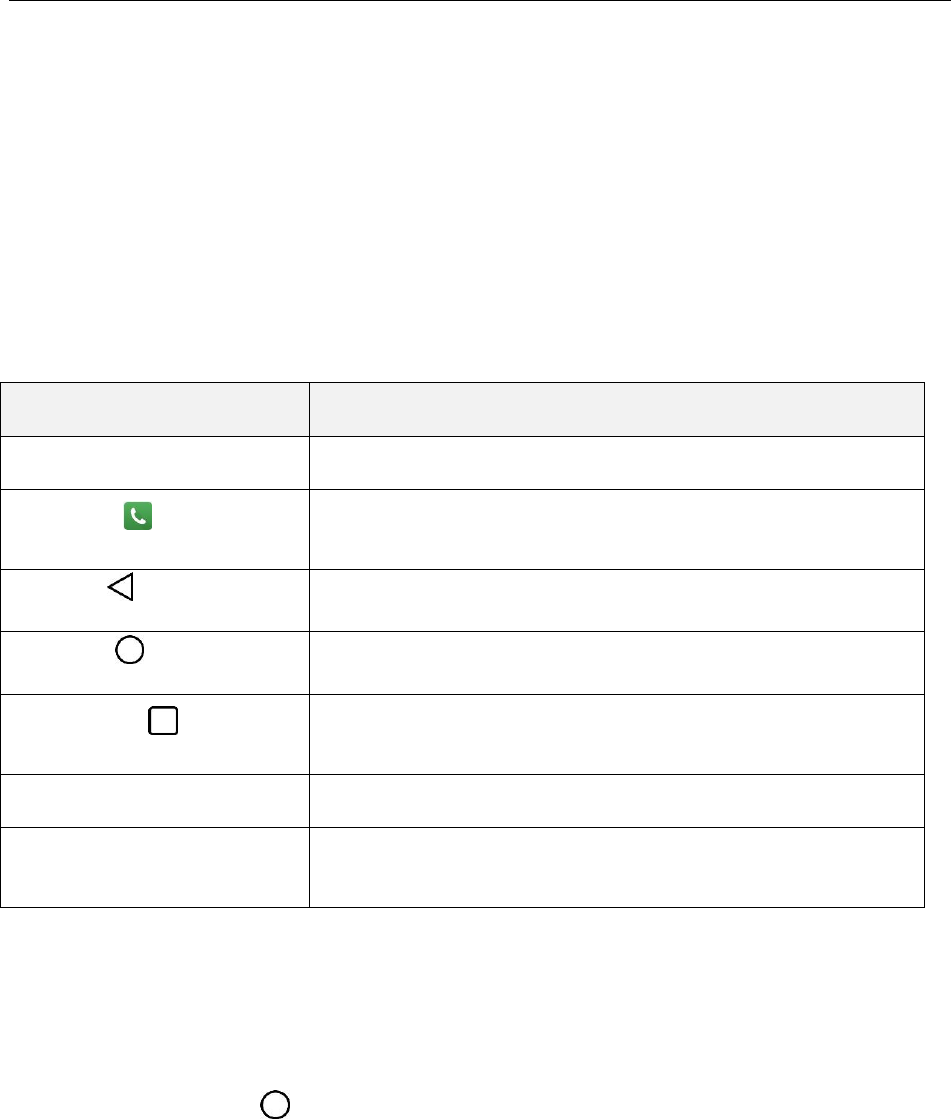
Your Phone's Home Screen 34
Your Phone's Home Screen
The following topics describe how to use and customize your phone’s home screen, understand the
status bar, and use the notification panel.
Home Screen Basics
The home screen is the starting point for your phone’s applications, functions, and menus. You can
customize your home screen by adding application icons, shortcuts, folders, widgets, and more.
Home Screen Layout
Your home screen extends beyond the initial screen. Swipe the screen left or right to display additional
screens.
Item
Description
Notifications
Displays your current notifications.
Phone App
Tap to open the dial pad. Also provides additional tabs to access
Call logs, Contacts, and Groups.
Back Key
Tap to return to the previous screen.
Home Key
Tap to display the main home screen.
Overview Key
Tap to access a list of your most recently-used apps. Touch and
hold while using an app to use the Multi-window feature.
Application Icons
Tap an icon (application, folder, etc.) to open and use it.
Status Bar
Shows device status information including the time, signal
strength, battery status, and notification icons.
Extended Home Screens
In addition to the main home screen, your phone features extended home screens provide more space
for adding icons, widgets, and more. Swipe across the screen to move from the main screen to an
extended screen. The small circles above the primary shortcuts let you know your current screen position.
■ Tap the Home Key to display the main home screen.
To go directly to a particular screen:
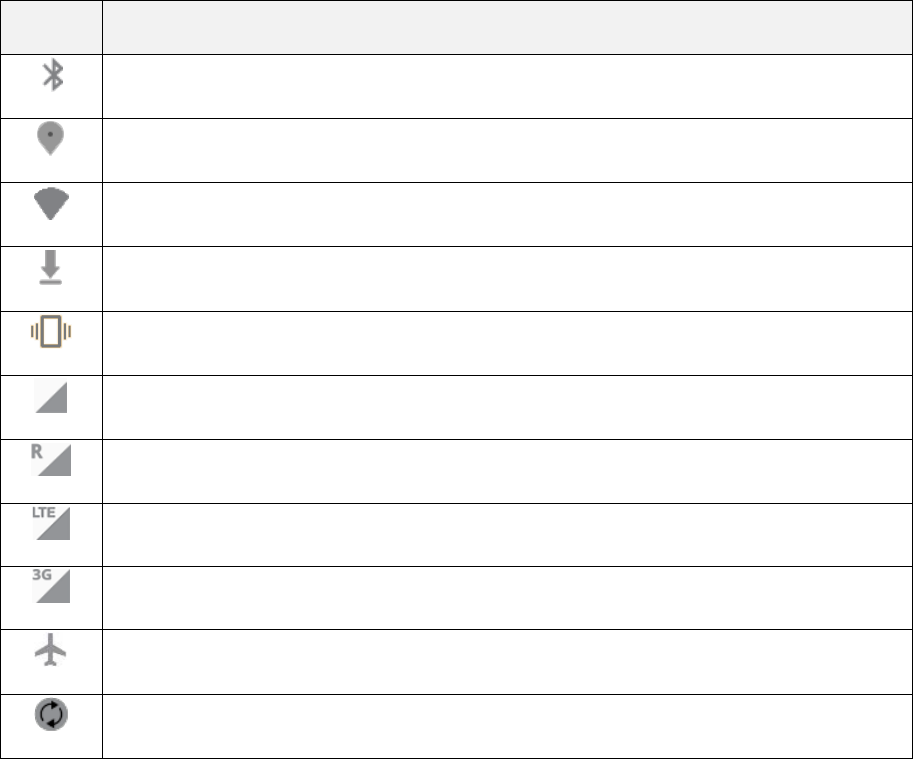
Your Phone's Home Screen 35
● Swipe left and right to access additional home screen panels.
● Tap the location dots near the bottom of the home screen to move to the selected panel.
Status Bar and Notification Panel
Your phone’s status and notifications are available at a glance at the top of the screen.
Status Bar
The status bar at the top of the home screen provides phone and service status information on the right
side and notification alerts on the left. To view the notification panel or access the quick settings menu,
pull down the status bar from the top of the screen.
Note: Status and notification icons are subject to change. Not all icons are depicted below.
Status Bar Layout
Main Status Icons
Icon
Status
Bluetooth® active
GPS active
Wi-Fi active
Downloading
Vibrate
Network (full signal)
Network (roaming)
4G LTE data service
3G (data service)
Airplane mode
Sync active
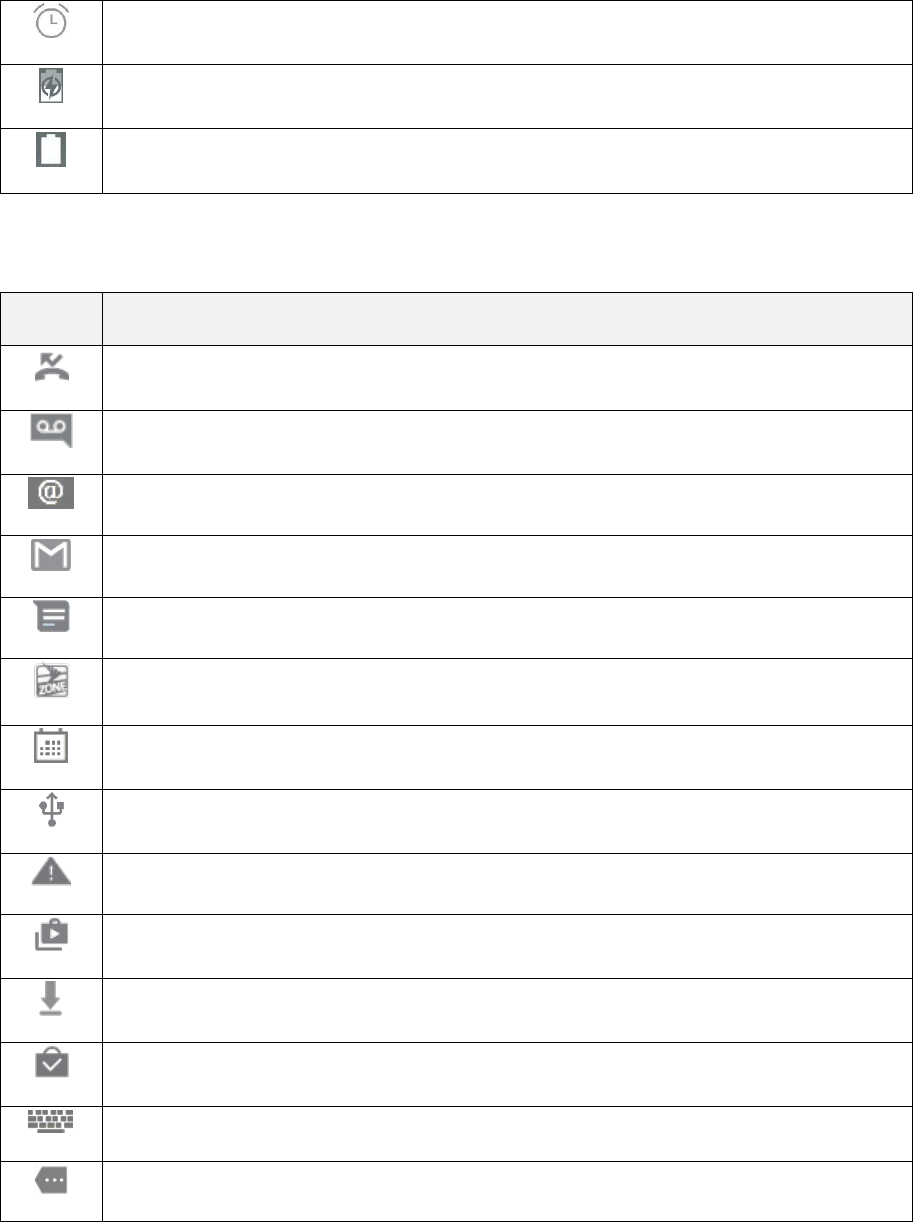
Your Phone's Home Screen 36
Alarm set
Battery (fast charging)
Battery (full charge)
Main Notification Icons
Icon
Notification
Missed call
New voicemail
New email
New Gmail
New text or MMS message
New Sprint Zone message
Event
USB connection
Warning
Update available
Update downloading
Update successful
Keyboard active
More notifications available (pull down to view)

Your Phone's Home Screen 37
Note: Additional notification icons may appear. All notifications may be accessed through the notification
panel.
Notification Panel
Your phone’s notifications appear at the left side of the status bar, and you can access the full notification
panel by pulling down the status bar. From there, you can check notifications, download updates, open
messaging apps, use the quick settings menu, and more.
Open the Notification Panel
■ Pull down the status bar. (Slide your finger down from the top of the screen.)
The notification panel opens. To check notifications, tap an item in the list.
Close the Notification Panel
■ Slide the notification panel up. (Slide your finger up from the bottom of the screen.)
– or –
Tap Back to close the notification panel.
Notification Panel Layout
The notification panel gives you access both to notifications and the quick settings menu.
Customize the Home Screen
Learn how to set the wallpaper and add, move, or remove shortcuts, widgets, and folders from the home
screen.
Rearranging Items on the Home Screen
● Moving Widgets and Icons: From home, touch and hold an item and then drag it to the desired
location.
● Deleting Widgets: From home, touch and hold an item and then drag it to Remove.
● Displaying the Home Screen Menu: From home, touch and hold an empty space to display the
home screen menu. Menu options include Widgets, Theme, Home screen settings and App trash.
Change the Wallpaper
Select and assign your phone’s background wallpaper.
1. Tap > Settings > Display tab > Home screen/Lock screen > Wallpaper.
2. Tap an option to select the wallpaper.

Your Phone's Home Screen 38
Home screen to set the background wallpaper for your home screen. Select from Wallpaper
gallery, Gallery, Sprint ID, Live wallpapers, and Photos.
Lock screen to set the wallpaper for your phone’s lock screen. Select from Wallpaper
gallery, Gallery, or Collage Wallpapers.
3. Select a wallpaper and tap OK or SET WALLPAPER.
The wallpaper is set.
Note: If you select Gallery, you will need to select an album and a picture. Once selected, use the crop
tool to resize and position the image and then tap OK.
Note: If you select Live Wallpapers, before you tap APPLY, you can tap EDIT to select custom
animation settings, etc., for the live wallpaper.
Add Widgets to the Home Screen
You can add widgets to your phone’s home screen. Widgets are self-contained apps that display on a
home screen. Unlike a shortcut, the Widget works like an onscreen application. There are all kinds of
widgets, including links to a specific contact, Internet bookmarks, Facebook® status windows, Gmail and
email accounts, and many others.
1. Tap , touch and hold an empty space, and then tap Widgets.
The widget list opens.
2. Touch and hold a widget icon.
The icon will disengage and you will see thumbnails of your home screens.
3. Drag the icon to an empty location on one of the home screens.
The widget is added to the home screen.
Add Folders to the Home Screen
You can group home screen shortcuts into folders for convenient access.
1. Tap , touch and hold a shortcut you want to place in a folder and drag it over another icon you
want to place in the folder. Then release it.
A new folder is created.
2. To add more app shortcuts to the folder, touch and hold a shortcut and drag it on top of the new
folder.
The new shortcut is added to the folder.
Change Folder Names
Once you have added folders, you can change the name easily from the folder display.

Your Phone's Home Screen 39
1. Tap , tap the folder to open it, and then tap the folder name.
2. Type a new name and then tap OK.

40
Making Connections
The following set of topics will cover your phone’s ability to help you make connections, from phone calls
and maintaining contacts, to text messages, email, Internet, and international services.

Phone Calls and Voicemail 41
Phone Calls and Voicemail
The following topics outline the use of your device’s phone app to place and receive calls, use voicemail,
set up and manage contacts, and more.
Place and Answer Calls
The following topics describe how to directly dial calls, how to answer incoming calls, and how to use the
in-call screen options.
Adjust In-Call Volume
■ Adjusting Call Volume: Press the Volume keys during the call.
Emergency Call Cautions
Emergency calls are restricted in Airplane mode.
Call Using the Phone Dialer
The most "traditional" way to place a call is by using the phone's dialer screen.
1. Tap > Phone > Dial tab.
2. Enter a phone number using the on-screen dialpad and tap .
If you enter a wrong number, tap to erase digits one by one.
To erase the entire number, touch and hold .
You can open other applications during a call. The will appear in the status bar while the
call is underway.
Press the Volume Up/Down keys to adjust the call volume.
Use the on-screen buttons to add another call, put a call on hold, to use the speakerphone,
and for other options, as described in In-Call Screen Layout and Operations.
3. Tap to end the call.
Tip: To redial your last outgoing call, follow step 1 to access the Dialer, tap the Call logs tab, locate the
call entry and tap .
You can also make calls from your Contacts list and from the Call logs.

Phone Calls and Voicemail 42
Call Emergency Numbers
You can place calls to 9-1-1 even if the phone’s screen is locked or your account is restricted.
To call the 9-1-1 emergency number when the phone’s screen is locked with a screen lock:
1. From the lock screen, tap Emergency call.
2. Tap .
As long as you are in an area covered by wireless service, the emergency call is placed.
To call the 9-1-1 emergency number normally or when your account is restricted:
1. Unlock the screen. For more information, see Lock and Unlock Your Screen.
2. Tap > Phone > Dial tab.
3. Tap .
As long as you are in an area covered by wireless service, the emergency call is placed.
Enhanced 9-1-1 (E 9-1-1) Information
This phone features an embedded Global Positioning System (GPS) chip necessary for utilizing E 9-1-1
emergency location services where available.
When you place an emergency 9-1-1 call, the GPS feature of your phone seeks information to calculate
your approximate location. Depending on several variables, including availability and access to satellite
signals, it may take up to 30 seconds or more to determine and report your approximate location.
Important: Always report your location to the 9-1-1 operator when placing an emergency call. Some
designated emergency call takers, known as Public Safety Answering Points (PSAPs), may not be
equipped to receive GPS location information from your phone.
Answer Phone Calls
The following information lets you know how to answer incoming calls, mute the ringer on incoming calls,
reject incoming calls, and more.
When you receive a phone call from a contact, the Incoming call screen appears and displays the caller
ID icon, name, and phone number of the calling party. When you receive a phone call from someone who
is not stored in your contacts, only the default caller ID icon and phone number appear on the Incoming
call screen.
Note: If your phone is turned off, all calls automatically go to voicemail.
Answer an Incoming Call
1. When a call arrives, drag in any direction to answer it.
2. To end the call, tap .

Phone Calls and Voicemail 43
Mute the Ringing Sound
To mute the ringer without rejecting the call, you can do any of the following:
● Press the Volume Down key.
● Place the phone face down on a level surface.
Reject an Incoming Call
■ When a call arrives, drag in any direction to reject it.
The ringtone or vibration will stop and call will be sent directly to voicemail.
Reject a Call and Send a Text Message
You can reject an incoming call and automatically send a text message to the caller.
1. When a call arrives, slide Decline with message up from the bottom of the screen.
The ringtone or vibration will stop and you will see a list of preset text messages.
2. Tap one of the messages to send it to the caller.
The selected message will be delivered to the caller.
You can edit the reject messages through the Call settings menu. From the phone app, tap
> Call settings > Call blocking & Decline with message > Decline with message and
edit or create the reject messages.
In-Call Screen Layout and Operations
While you’re on a call, you will see a number of onscreen options. Tap an option to select it.
In-Call Screen Layout
Tap options to activate them during a call.
● Add call to initiate a 3-way call.
● End to end the current call.
● Dialpad to display the dialpad to enter additional numbers, for example, an extension or access
code.
For example: When you call your bank‘s 800 number, use your dialpad to enter your account
number and PIN.
● Speaker to route the phone’s audio through the speaker (On) or through the earpiece (Off).
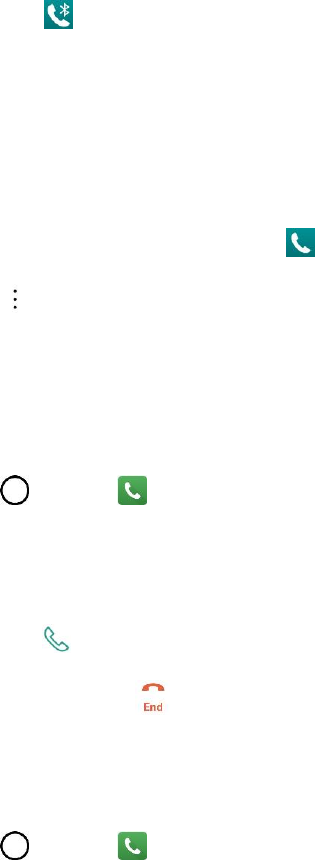
Phone Calls and Voicemail 44
Activate the speaker to route the phone’s audio through the speaker. (You can adjust the
speaker volume using the volume keys.)
Deactivate the speaker to use the phone’s earpiece.
Warning: Because of higher volume levels, do not place the phone near your ear during speakerphone
use.
● Mute to mute the microphone during an active call. Tap again to unmute the microphone.
● Bluetooth (Only available when a Bluetooth headset is connected to your phone) to route the
phone’s audio through a connected Bluetooth headset (On) or through the speaker (Off).
When the call is routed to a Bluetooth headset, the current call area shows the Bluetooth call
icon ( ).
Note: The Headset button is activated to show the current call is routed to the connected Bluetooth
headset.
To route the current call back to the phone, tap Bluetooth to temporarily use the phone. Tap
it again to route the call back to the connected Bluetooth headset.
When Bluetooth or the Bluetooth headset is turned off, the call is routed through either the
earpiece or speaker and shows ( ).
● Tap during a call to display a list of additional in-call features:
Contacts: Display your contacts list.
Place a Call from Contacts
You can place phone calls directly from entries in your Contacts list.
1. Tap > Phone to display the phone app.
2. Tap the Contacts tab to display the Contacts list.
3. Tap a contact.
4. Tap Call next to the number you want to call.
5. To end the call, tap .
Call from Call Logs
The Call logs list lets you quickly place calls to recent incoming, outgoing, or missed numbers.
1. Tap > Phone to display the phone app.
2. Tap the Call logs tab to display the Call logs list.

Phone Calls and Voicemail 45
3. Tap an entry to display the call details.
4. Tap Call to place a call.
5. To end the call, tap .
Voicemail
The following topics describe how to set up and use your phone's voicemail and visual voicemail features.
Voicemail Setup
You should set up your voicemail and personal greeting as soon as your phone is activated. Always use a
password to protect against unauthorized access. Your phone automatically transfers all unanswered
calls to your voicemail, even if your phone is in use or turned off.
1. Tap > Phone > Dial tab.
2. Touch and hold to dial your voicemail number.
3. Follow the system prompts to:
Create your password.
Record your name announcement.
Record your greeting.
Important: Voicemail passcode – It is strongly recommended that you create a password when setting
up your voicemail to protect against unauthorized access. Without a password, anyone who has access
to your phone is able to access your voicemail messages.
Visual Voicemail Setup
This topic describes the Visual Voicemail feature of your phone's service, as well as the steps required to
set up Visual Voicemail on your phone.
About Visual Voicemail
Visual Voicemail gives you a quick and easy way to access your voicemail. Now you can find exactly the
message you are looking for without having to listen to every voicemail message first. This feature
periodically goes out to your voicemail, and gathers the caller information from all of the current
voicemails. It then populates a list with the caller name and number, along with the length of time and
priority level of the voicemail message.
Set Up Visual Voicemail
Setting up Visual Voicemail follows many of the same procedures as setting up traditional voicemail. You
should set up your voicemail and personal greeting as soon as your phone is activated. Your phone
automatically transfers all unanswered calls to your voicemail, even if your phone is in use or turned off.
Note: To set up your traditional voicemail box, see Voicemail Setup.

Phone Calls and Voicemail 46
1. Tap > Voicemail .
You’ll see a Welcome to Visual Voicemail screen.
2. Scroll through the introduction screens to view a brief explanation of visual voicemail services.
3. At the end of the welcome screens, you'll come to a Personalize your voicemail prompt.
4. Tap PERSONALIZE and follow the system prompts to:
Create a password (part of standard voicemail).
Record your name announcement.
Record your greeting.
Important: Voicemail passcode – It is strongly recommended that you create a password when setting
up your voicemail to protect against unauthorized access. Without a password, anyone who has access
to your phone is able to access your voicemail messages.
Review Visual Voicemail
Visual Voicemail lets you easily access and select which messages you want to review.
1. Tap > Voicemail .
You will see the voicemail inbox.
2. Tap a message to review it.
3. Tap Back to return to the voicemail inbox to review additional messages.
Tip: There are several icons at the bottom of the review screen for maintenance, storage, messaging,
and other options. For an explanation of all your options, tap Menu > Help > Visual Voicemail Menu.
Visual Voicemail Options
Use the following options to access and configure your Visual Voicemail options.
1. Tap > Voicemail .
2. From this initial screen, you can:
Tap to view the voicemail messages in other folder: Inbox, Sent, Archive, and Trash.

Phone Calls and Voicemail 47
Tap to access New Voice SMS, New Avatar message, Search, Store, Help, and
Settings.
Configure Visual Voicemail Settings
The Visual Voicemail settings menu lets you access settings for notifications, pictures, greetings, and
more.
1. Tap > Voicemail .
2. Tap > Settings and select from the following:
Avatar
• Disable Avatar to disable Avatar compose features and content store.
• Avatar Facebook ad signature to enable avatar advertising signature when posting on
Facebook.
• SMS delivery to allow sending SMS message to recipients who do not have Avatar
capability.
Display
• Themes to choose the type of theme used for the application.
• Display name to enter a name to identify yourself to people when replying or forwarding
messages.
Help/Info to see the visual voicemail help.
Preferences
• Manage subscription to subscribe and unsubscribe from the visual voicemail premium
monthly subscription service. This may take a minute.
• Data consent agreement to agree or disagree to send speech data to assist with the
quality of the voicemail feature.
• Auto forward to email to send a copy of new messages to an email address of your
choice.
• Personalize voicemail to change your voicemail greeting for incoming calls and update
password.
• Transcription language to choose the transcription language (if available).
• Delete messages to set Visual Voicemail to permanently delete messages from the
Trash folder after a specific number of days.
• Transcriptions displayed to transcribe Voicemails from voice to text.
• Enable/Disable free trials to opt in or out of future free trials.

Phone Calls and Voicemail 48
• SMS delivery of voice message to allow voice message delivery via SMS to recipients
who do not always have VoiceSMS capability.
Sound
• Notifications to determine how you are notified of new voicemails. Set the notification
sound and vibrate option.
• Speakerphone to automatically turn the speaker on or off.
Updates to search for an upgrade to your Visual message software.
About Voicemail to view build information about the current visual voicemail application.
Change Your Main Greeting via the Voicemail Menu
Your main greeting can be changed directly via the Visual Voicemail system. This direct access saves
you from having to navigate within the voicemail menu.
1. Tap > Voicemail .
2. Tap > Settings > Preferences > Personalize voicemail.
3. Tap OK to connect to the voicemail system. Follow the prompts to change your current greeting.
Edit the Display Name via the Voicemail Menu
From your Visual Voicemail menu, you can quickly change the name or number attached to your voice
messages.
1. Tap > Voicemail .
2. Tap > Settings > Display > Display name.
3. Tap the existing identification field and enter a new identifying name or number (used to identify
you to recipients of your voice messages).
4. Tap OK to save your information.
Optional Calling Services
The following topics outline additional voice-related services available with your phone, including Wi-Fi
calling, call services and more.
Wi-Fi Calling
Wi-Fi Calling uses Wi-Fi networks to help improve voice and data coverage. It sends and receives calls
and text messages over a connected Wi-Fi network and may offer better coverage in buildings and areas
of poor cellular reception.
For more information about Wi-Fi and your phone, see Wi-Fi.

Phone Calls and Voicemail 49
Set Up Wi-Fi Calling
1. Tap > Settings > Networks tab.
2. Tap Wi-Fi Calling and follow the online prompts to set up Wi-Fi Calling.
Wi-Fi Calling is set up. You will see in the status bar when Wi-Fi Calling is active, or if
Wi-Fi Calling is set up but you are not currently connected to a Wi-Fi network.
Tip: For more information about Wi-Fi Calling, visit this FAQ link at sprint.com/support.
Enable or Disable Wi-Fi Calling
1. Tap > Settings > Networks tab > Wi-Fi Calling.
2. Tap to turn Wi-Fi Calling on or off.
Wi-Fi Calling will be turned off, and the Wi-Fi Calling icon will not appear in the status bar.
Tip: You can also turn Wi-Fi Calling on or off through the quick settings menu. Pull down the status bar to
display the quick settings menu and tap Wi-Fi Calling to enable or disable the feature.
Caller ID Blocking
Caller ID identifies a caller before you answer the phone by displaying the number of the incoming call. If
you do not want your number displayed when you make a call, follow these steps.
1. Tap > Phone > Dial tab.
2. Tap .
3. Enter a phone number.
4. Tap .
Your caller information will not appear on the recipient’s phone.
To permanently block your number, call Sprint Customer Service.
Call Waiting
When you’re on a call, Call Waiting alerts you to incoming calls by sounding two beeps. Your phone’s
screen informs you that another call is coming in and displays the caller’s phone number (if it is available).
To respond to an incoming call while you’re on a call:
■ Swipe in any direction. (This puts the first caller on hold and answers the second call.)
To switch back to the first caller:
■ Tap Swap calls.
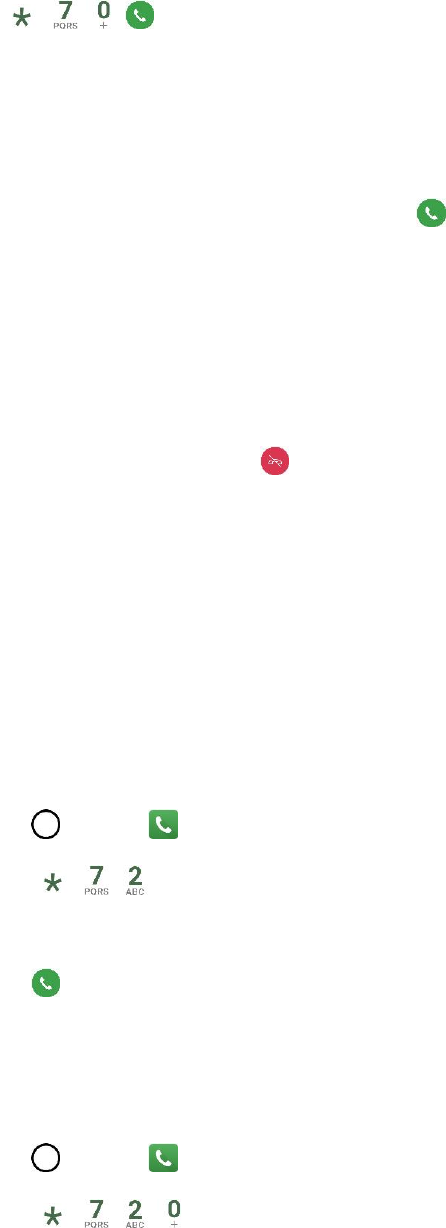
Phone Calls and Voicemail 50
Note: For those calls where you don’t want to be interrupted, you can temporarily disable Call Waiting by
pressing before placing your call. Call Waiting is automatically reactivated once you end
the call.
Conference Calling
With conference calling, also known as 3-way calling, you can talk to two people at the same time. When
using this feature, the normal airtime rates will be charged for each of the two calls.
1. On the dial pad screen, enter a number and tap (or place a call from Log or Contacts).
2. Once you have established the connection, tap Add call, and dial the second number (or place
the call from Logs or Contacts).
This puts the first caller on hold and dials the second number.
3. When you’re connected to the second party, tap Merge calls. Your conference call is now in
session.
4. To end the three-way call, tap .
Note: If one of the people you called hangs up during your call, you and the remaining caller stay
connected. If you initiated the call and are the first to hang up, all callers are disconnected.
Call Forwarding
Call Forwarding lets you forward all your incoming calls to another phone number – even when your
phone is turned off. You can continue to make calls from your phone when you have activated Call
Forwarding.
Note: You are charged a higher rate for calls you have forwarded.
To activate Call Forwarding:
1. Tap > Phone > Dial tab.
2. Tap .
3. Enter the area code and phone number to which you want your calls forwarded.
4. Tap .
You will hear a tone to confirm the activation of Call Forwarding. All calls to your wireless
number will be forwarded to the designated phone number.
To deactivate Call Forwarding:
1. Tap > Phone > Dial tab.
2. Tap .
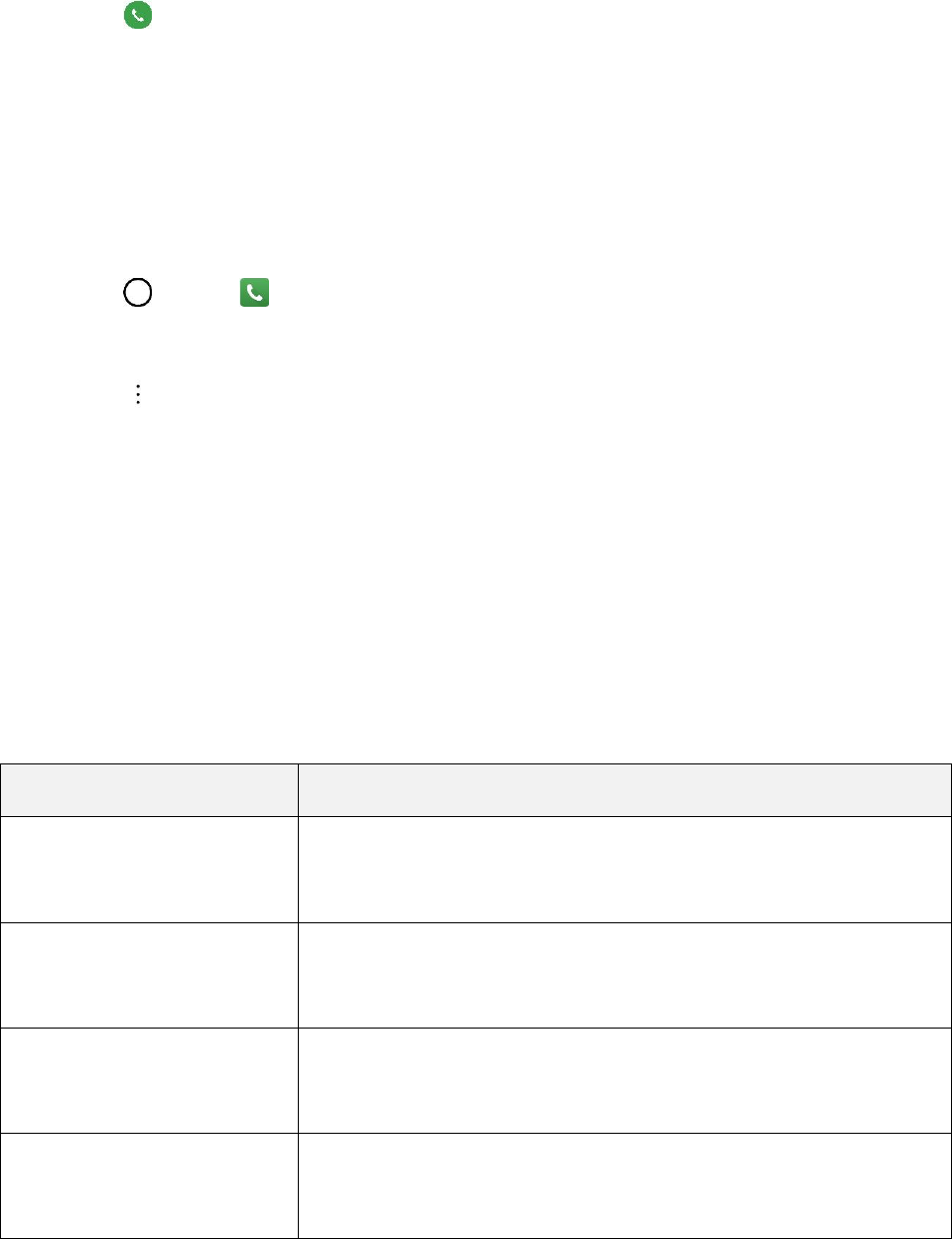
Phone Calls and Voicemail 51
3. Tap .
You will hear a tone to confirm the deactivation.
Call Settings Menu
Your phone’s Call Settings menu lets you configure your voicemail options and a number of other settings
for the phone application.
Use the Call Settings Menu
1. Tap > Phone .
The phone app opens.
2. Tap > Call settings.
The call settings menu appears.
3. Configure your options.
Tap a menu item to display its options.
Select your options and follow the prompts to set them.
Your call settings options are set.
Call Settings Overview
Use the Call Settings menu to adjust the following settings:
Setting
Description
Decline with message
under Call blocking & Decline
with message
You can send out a text message when you want to ignore an incoming
call and respond to the caller with a text instead. You can add or edit
quick messages.
Blocked numbers
under Call blocking & Decline
with message
You can set call rejections and manage the reject list.
Digit filter
under Call blocking & Decline
with message
Block calls based on the starting or ending digits in their number.
Private numbers
under Call blocking & Decline
with message
You can set call rejections from a private number.

Phone Calls and Voicemail 52
End calls with the Power key
under Answer and end calls
You can set the phone to end calls with the Power/Lock key.
Auto answer
under Answer and end calls
Allows you to set the time before a connected hands-free device
automatically answers an incoming call.
Voice clarity
You can set the phone to enhance voice clarity in noisy environments
so you can hear more clearly.
Incoming voice call pop-up
under More
Activate to display the incoming call pop-up when using an application.
Vibrate when call ends
Under More
Activate to vibrate when a call ends.
Smart dialing
under More
Activate to make a call to the U.S. from abroad without entering the
national code. Touch and hold or tap the contact.
Answer incoming call
under More > Gestures
You can answer an incoming call by bringing the phone to your ear.
Silence incoming calls
under More > Gestures
You can set the phone to silence incoming calls by just flipping the
phone.
Save unknown numbers
under More
You can set the phone to save the phone numbers not saved in
Contacts yet.
Proximity Sensor
under More
When receiving and making calls, this sensor automatically turns the
backlight off and locks the touch keypad by sensing when the phone is
near your ear. This extends battery life and prevents the touch keypad
from activating unintentionally during calls.
TTY mode
under More
A TTY (also known as a TDD or Text Telephone) is a
telecommunications phone that allows people who are deaf, hard of
hearing, or who have speech or language disabilities, to communicate
by telephone. Your phone is compatible with select TTY phones.
Please check with the manufacturer of your TTY phone to ensure that it
is compatible with digital cell phones. Your phone and TTY phone will
connect via a special cable that plugs into your phone's headset jack. If
this cable was not provided with your TTY phone, contact your TTY
phone manufacturer to purchase the connector cable.
Hearing aids
under More
Tap to turn on hearing aid compatibility.

Phone Calls and Voicemail 53
TTY Mode
A TTY (teletypewriter, also known as a TDD or Text Telephone) is a telecommunications device that
allows people who are deaf, hard of hearing, or who have speech or language disabilities, to
communicate by telephone.
Your phone is compatible with select TTY devices. Please check with the manufacturer of your TTY
device to ensure that it supports digital wireless transmission. Your phone and TTY device will connect
using a special cable that plugs into your phone’s headset jack. If this cable was not provided with your
TTY device, contact your TTY device manufacturer to purchase the connector cable.
To turn TTY Mode on or off:
1. Tap > Phone > Dial tab.
2. Tap > Call settings > More > TTY mode.
3. Tap TTY Full, TTY HCO, or TTY VCO to turn TTY mode on.
– or –
Tap TTY Off to turn TTY mode off.
Your phone’s TTY mode is set.
Note: When enabled, TTY mode may impair the audio quality of non-TTY devices connected to the
headset jack.
Warning: 9-1-1 Emergency Calling
It is recommended that TTY users make emergency calls by other means, including Telecommunications
Relay Services (TRS), analog cellular, and landline communications. Wireless TTY calls to 9-1-1 may be
corrupted when received by public safety answering points (PSAPs), rendering some communications
unintelligible. The problem encountered appears related to TTY equipment or software used by PSAPs.
This matter has been brought to the attention of the FCC, and the wireless industry and the PSAP
community are currently working to resolve this.

Contacts 54
Contacts
The Contacts application lets you store and manage contacts from a variety of sources, including
contacts you enter and save directly in your phone as well as contacts synchronized with your Google
Account, your PC, compatible email programs (including Exchange Server), and your friends from
compatible social networking applications.
Cautions
Information saved in Contacts may be lost or changed if the battery is left uncharged. Accident or
malfunction may also cause loss or change to information. It is recommended that you keep a
separate copy of contacts and other important information. Sprint is not responsible for any damages
from lost or changed contacts.
Add Contacts
You can add contacts on your phone and synchronize them with the contacts in your Google Account,
Microsoft Exchange account, or other accounts that support syncing contacts.
The Contacts application tries to join new addresses with existing contacts to create a single entry. You
can also manage that process manually.
1. Tap > Essentials > Contacts .
2. Tap to add a contact.
3. Tap a destination type, Phone contact or Google (if available).
4. Tap to select a picture to display next to the name in your list of contacts and in the Caller ID.
5. Tap the Name field and enter a name for your contact.
6. Tap the Phone field and enter a phone number.
Note: To select a type (label) for a phone number, email address, or postal address (such as Mobile,
Home, Work, etc.), tap the type next to the field and select the appropriate type.
Note: To add more phone numbers, email addresses, etc., tap Add phone or Add email.
7. Enter any additional information you may want to save and when you're finished tap SAVE.
The contact is added.
Save a Phone Number
You can save a phone number to Contacts directly from the phone keypad.
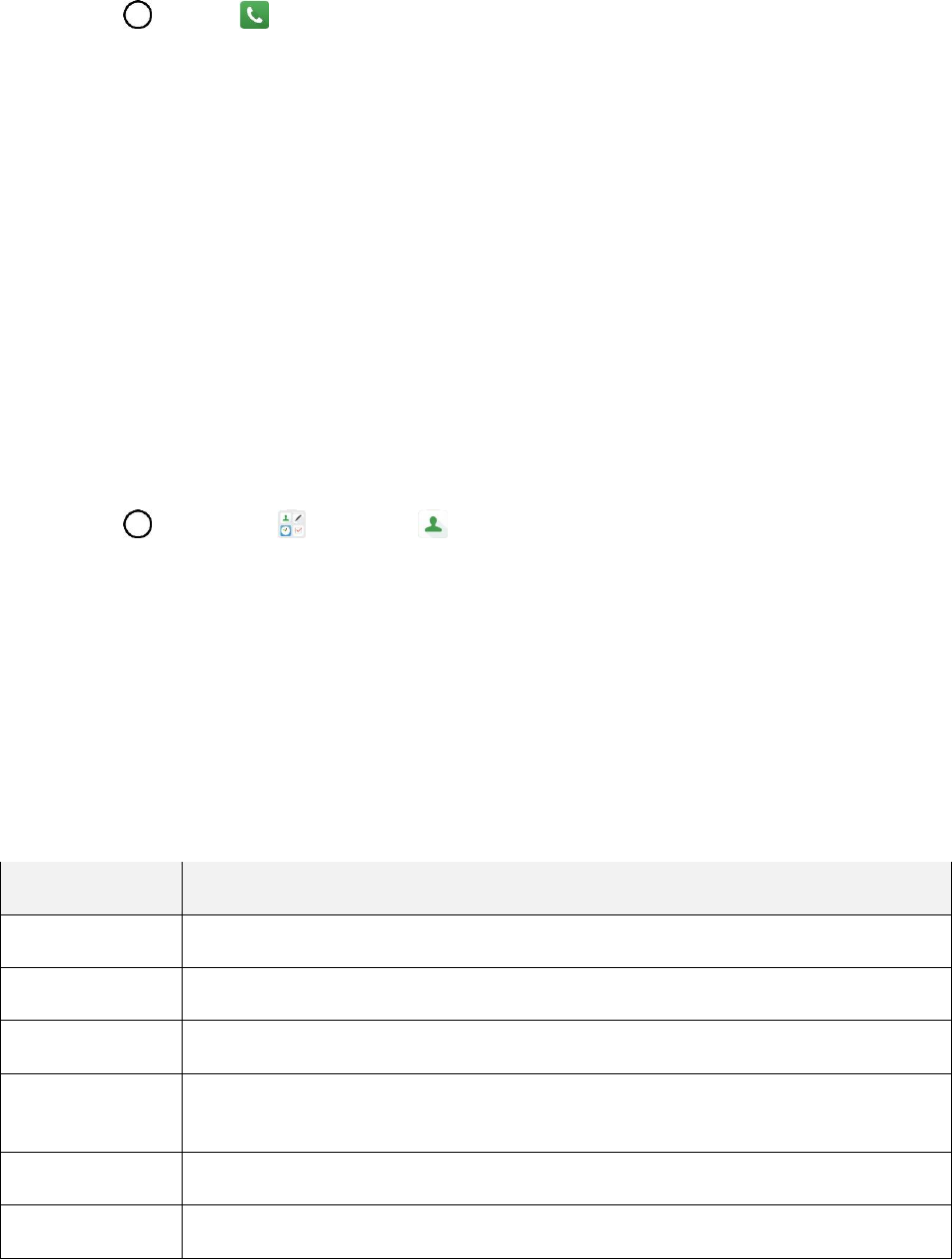
Contacts 55
1. Tap > Phone .
2. Enter a phone number.
3. To add the number to an existing contact, tap Update contact. To add a new contact, tap Create
contact.
For an existing contact, tap the contact name and select a number type for the new number.
For a new contact, enter the name and any additional information.
4. Tap SAVE.
The contact is added.
View Contacts
View a contact’s details by displaying a contact entry.
1. Tap > Essentials > Contacts .
You will see the Contacts list.
2. Tap a contact to view its details.
Contacts Screen Layout
The following illustration shows your Contacts app layout and describes the various features.
Item
Description
Groups tab
Show contact groups.
Contacts tab
Show all contacts.
Contact
Tap to show a contact’s details.
Image
Tap to show a thumbnail of the contact entry. Tap an icon to place a call, send a
message, etc.
Search
Search contacts.
Index
Browse contacts by letter.
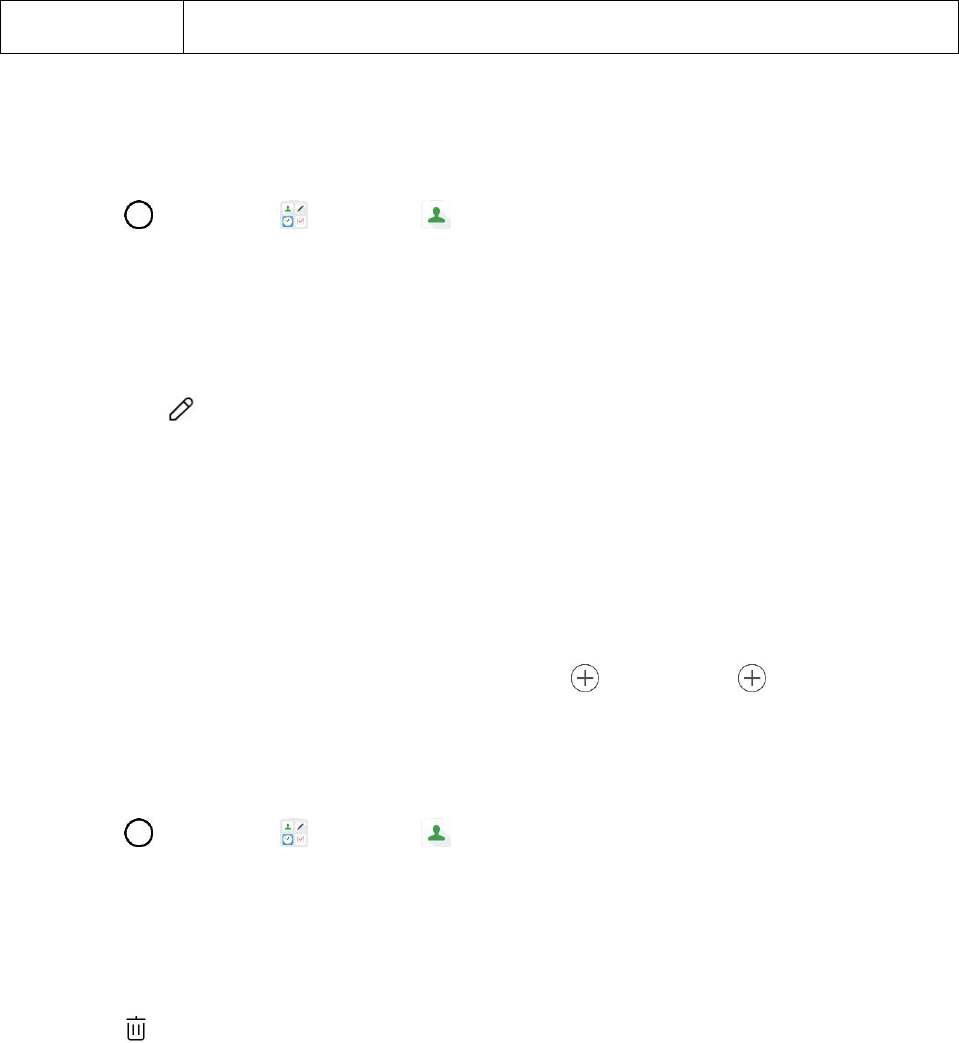
Contacts 56
Add new
Add a new contact.
Edit Contacts
Once you’ve added a contact, you can add or edit any of the information in the entry, assign a caller ID
picture, customize with a unique ringtone, and more.
1. Tap > Essentials > Contacts .
You will see the Contacts list.
2. Tap the contact to view its details.
The contact’s detailed listing appears.
3. Tap Edit .
4. Tap any field you want to change or add. See Add Contacts.
5. Add or edit the information, and then tap SAVE.
Your changes are saved to the contact entry.
Note: To select a type (label) for a phone number, email address, or postal address (such as Mobile,
Home, Work, etc.), tap the type next to the field and select the appropriate type.
Note: To add more phone numbers, email addresses, etc., tap Add phone or Add email.
Delete Contacts
You can delete a contact from the contacts details page.
1. Tap > Essentials > Contacts .
You will see the Contacts list.
2. Tap a contact to view its details.
The contact’s detailed listing appears.
3. Tap .
4. Tap DELETE.
The contact is deleted.
Tip: You can also touch and hold the contact from the contact list and then tap Delete contact >
DELETE.

Contacts 57
Share Contacts
You can quickly share contacts using Bluetooth, email, Gmail, or text messaging.
1. Tap > Essentials > Contacts .
You will see the Contacts list.
2. Tap > Share.
3. Tap the contacts you want to share, then tap SHARE.
4. Choose the method for sending.
5. Complete the required steps as prompted for the selected method.
The selected contact will be shared.
Import Contacts
You can import contacts from your internal storage directly to your Contacts application.
1. Copy the vCard files to your phone from your computer.
2. Tap > Essentials > Contacts .
3. Tap > Manage contacts > Import.
4. Select where to import from and save to, then tap OK.
5. Tap the files you wish to import and tap IMPORT and IMPORT to confirm.
Back Up Contacts
You can back up and export all of the contacts on your phone, as vCard files. You can then copy this file
to a computer or another phone that is compatible with this format, such as an address book application.
1. Tap > Essentials > Contacts .
2. Tap > Manage contacts > Back up.
3. Select a storage location and then tap OK.
4. Tap the contacts you want to export, then tap BACK UP and BACK UP to confirm.
5. Enter a file name and tap OK.

Messaging 58
Messaging
With wireless service and your phone’s messaging capabilities, you have the opportunity to share
information through many different channels and accounts, including Messenger, Gmail (Google),
personal and corporate email.
Messenger
You can send and receive text messages, photos, voice messages, and video using Messenger. When
you receive a new message, you will be notified by your phone. Messaging is available via the
Messenger application. The icon appears status bar when a new message is received.
Send a Text Message
Quickly compose and send text messages (SMS) on your phone.
Note: See your service plan for applicable charges for text messaging.
1. Tap > Messenger .
2. Tap .
3. Tap the To field and enter a contact's names, phone numbers, or email addresses that you'd like
to message. You can also pick from your top contacts or your whole contact list.
4. Tap .
5. Tap the text field and enter your message.
To enter a emoji, tap . Select a category and make a selection from the list to insert it into
your current message.
6. Review your message and tap .
Send a Multimedia Message (MMS)
When you need to add a little more to a text message, you can send a multimedia message (MMS) with
the contents such as images, videos, etc.
Note: See your service plan for applicable charges for multimedia messaging.
Compose Multimedia Messages
1. Tap > Messenger .
2. Tap .
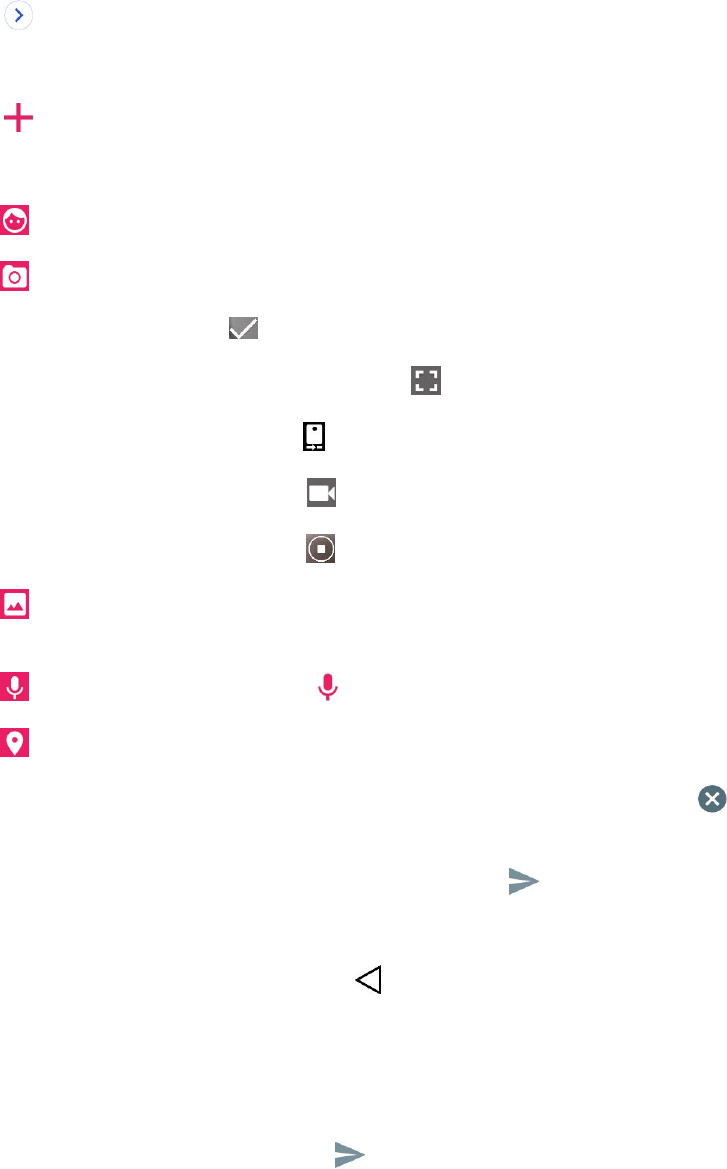
Messaging 59
3. Tap the To field and enter a contact's names, phone numbers, or email addresses that you'd like
to message. You can also pick from your top contacts or your whole contact list.
4. Tap .
5. Tap the text field and enter your message.
6. Tap .
7. Select a multimedia attachment type:
Sticker: Diverse stickers are available.
Take picture/Record video: Take a picture or record a video to insert in your message.
• To take a picture, tap .
• To see the camera in full-screen view, tap .
• To swap the camera lens, tap .
• To start recording a video, tap .
• To stop recording a video, tap .
Gallery: Opens the Gallery application. Tap a picture or a video to attach to your
message.
Record audio: Touch and hold until you finish recording.
Location: You can send your location.
Note: To remove or replace a picture or an audio attachment, on the Compose screen, tap next to the
attachment.
8. When you are finished creating your new MMS message, tap .
Save and Resume a Draft Message
While composing a text or multimedia message, tap to automatically save your message as a draft.
To resume composing the message:
1. On the screen with all message threads, tap the message. The Draft label is shown if a saved
draft is available.
2. When you finish editing the message, tap .

Messaging 60
New Messages Notification
Depending on your notification settings, the phone will play a ringtone, vibrate, or display the message
briefly in the status bar when you receive a new text or multimedia message. To change the notification
for new text and multimedia messages, see Text and MMS Options for details.
A new message icon also appears in the notifications area of the status bar to notify you of a new text
or multimedia message. The Messages application icon (if shown on the home screen) also displays the
number of new messages .
■ To open the message, pull down the status bar to open the notification panel. Tap the new
message to open and read it. For information on reading and replying to messages see Manage
Message Conversations.
Manage Message Conversations
Text and multimedia messages that are sent to and received from a contact (or a number) are grouped
into conversations or message threads in the Messenger screen. This allows you to see exchanged
messages (similar to a chat program) with a contact on the same screen.
Read a Text Message
● Do one of the following:
On the Messenger screen, tap the message thread to open and read it.
If you have a new message notification, drag the status bar down to open the notification
panel. Tap the new message to open and read it.
View a Multimedia Message (MMS)
1. Tap > Messenger .
2. On the Messenger screen, tap a message thread to open it.
3. While viewing a message, tap the play icon (on the video or audio file) to playback the file or tap
the image to view the picture.
Tip: The file attachment on the multimedia message can be saved to your phone's internal storage. To
save the attachment, touch and hold the file and tap .
Note: When Auto-download MMS is disabled, only the message header is downloaded. To download the
entire message, tap the Download button in the message. For details, see Text and MMS Options.
Reply to a Message
1. Tap > Messenger .
2. On the Messenger screen, tap a message thread to open it.
3. While viewing a message, tap the text field and type your reply message.

Messaging 61
4. Once completed, tap .
To return to the All messages screen from a text message thread, tap .
Note: To view the details of a particular message, in the message thread, touch and hold the message to
open the options menu, and then tap .
Note: If a message contains a link to a web page, tap the message and then tap the link to open it in the
web browser.
Note: If a message contains a phone number, tap the message and then tap the phone number to dial
the number or add it to your contacts.
Delete Conversations
1. Tap > Messenger .
2. On the Messenger screen, touch and hold a message thread to display .
To select multiple conversations, tap each conversation to delete. will be shown.
3. Tap and then tap DELETE to confirm.
Tip: You can also delete a conversation while you're viewing it. While viewing a conversation, tap >
Delete.
Delete a Single Message
1. While viewing a conversation, touch and hold the message that you want to delete.
2. Tap and then tap DELETE to confirm.
View Contact Information from a Message
When you have received a message from someone in your stored contacts, you can tap the contact’s
photo or icon in the message thread to open a menu of options. Depending on the stored contact
information, you can view the contact details, place a phone call, send an email message to the contact,
and more.
Text and MMS Options
The messages settings menu lets you control options for your text and multimedia messages including
message limits, size settings, and notifications.
1. Tap > Messenger .
2. On the Messenger screen, tap > Settings.
3. Adjust the following settings according to your needs:

Messaging 62
Default SMS app: To change your default messenger app.
Get notifications: Select whether to get notifications or not when a new message arrives.
Notification sound: Allows you to select a ringer to sound when a new message is received.
Tap this option, and then select a ringtone that is specific to new text and multimedia
messages. A sample will briefly be played upon selection, then tap OK to save your new
setting.
Hear outgoing message sounds: Select whether to hear sounds when you send a
message.
Vibrate: Enable this option if you want the phone to vibrate when a new text or multimedia
message is received.
Advanced
• Enhanced features: Configure the enhanced features (available when the mobile
network allows).
• Group messaging: Select the group messaging option between Send an SMS reply to
all recipients and get individual replies (mass text) and Send an MMS reply to all
recipients (group MMS).
• Auto-download MMS: Enable this option to automatically retrieve the entire content of
your multimedia message. When enabled, the multimedia message header, message
body, and any attachments will automatically download to your phone when the message
is received. If you disable this option, only the multimedia message header will be
retrieved and displayed.
• Auto-download MMS when roaming: Disable this option if you only desire the
multimedia message headers to download while roaming. Enable this option to
automatically download your complete multimedia messages even while roaming.
• Use simple characters: Turn this on to change special characters in text messages into
simple ones.
• SIM card messages: You can view SIM card messages.
• Phone number: Tap this to change the phone number you use to send messages.
Gmail
Use Google’s Gmail service and your Google Account to send, receive, and manage your Gmail
messages. Before using Gmail, you must register a Google (Gmail) Account on your phone. See Google
Account for details.
Gmail Cautions
Gmail is handled as email from a PC. Restricting email from PCs on your phone prevents your phone
from receiving Gmail.

Messaging 63
Create and Send Gmail
Use your phone to create and send Gmail messages.
1. Tap > Google > Gmail .
The Gmail inbox opens.
2. In the inbox, tap .
The Gmail composition window opens.
3. Enter the message recipient(s), subject, and message, and then tap Send .
The Gmail message is sent.
Gmail Composition Options
● Adding Cc/Bcc: In the mail composition window, tap and then add recipients.
● Attaching Pictures or Videos: In the mail composition window, tap Attach file . Locate the
file and then tap the picture or video you want to attach.
● Save as a Draft (Send Later): While composing your message, tap > Save draft. The
message is saved as a draft for later.
● Delete Mail Being Composed: In the mail composition window, tap > Discard.
Note: To view your draft email messages, in the inbox, tap > Drafts.
Note: To view your sent messages, in the inbox, tap > Sent.
Open Gmail Messages
Your phone allows you to access, read, and reply to all your Gmail messages.
Open Gmail Messages from Notifications
When new Gmail arrives, you will see in the status bar.
1. Pull down the status bar to display the notification panel.
2. Tap the new message from the notification panel.
The new Gmail message opens.
If you have two or more new Gmail messages, tapping the notification opens the Gmail inbox.
Open Gmail Messages from the Inbox
You can also read and reply to all your Gmail messages from the Gmail inbox.

Messaging 64
1. Tap > Google > Gmail .
The Gmail inbox opens.
2. Tap the message thread you want to view.
The message thread opens, with the newest message displayed.
Options when Reviewing Gmail Messages
● Replying to Gmail Messages: With the Gmail message open, tap Reply , compose your
reply message, and tap Send .
To reply to all, tap > Reply all.
● Forwarding Gmail Messages: With the Gmail message open, tap > Forward, enter a
recipient and an additional message, and tap Send .
Use Gmail Labels
Gmail saves all mail in one box, but you can add labels that allow you to sort your Gmail conversation
threads. For example, when a new thread starts with a received mail, the label "Inbox" is automatically
added to the thread. By then adding the label "travel," all threads with "travel" are shown in a list.
1. Tap > Google > Gmail .
The inbox opens.
2. Touch and hold a conversation thread to add a checkmark to it, and then tap > Change
labels.
3. Tap a label for the thread.
The thread is added to the selected label.
Archive Gmail Threads
Remove sent and received Gmail threads so they do not appear in the inbox. When replies arrive for
archived threads, they appear in the inbox again.
1. Tap > Google > Gmail .
The inbox opens.
2. Touch and hold a conversation thread to add a checkmark to it, and then tap Archive .
The thread is now archived.

Messaging 65
Mute Gmail Threads
If registered on a mailing list, there will be threads with always-continuing conversations. For long threads
that are not important, mute the threads and they will no longer appear in the inbox. When mail arrives
that includes user's address as a recipient or in Cc, mail will again appear in the inbox.
1. Tap > Google > Gmail .
The inbox opens.
2. Touch and hold a conversation thread to add a checkmark to it, and then tap > Mute.
The thread is now hidden.
Delete Gmail Threads
If you no longer wish to keep a Gmail conversation thread, you can simply delete it from the inbox.
1. Tap > Google > Gmail .
The inbox opens.
2. Touch and hold a conversation thread to add a checkmark to it, and then tap Delete .
The thread is deleted.
Search Gmail Messages
If you need to find a specific message or message thread, you can search Gmail from the inbox.
1. Tap > Google > Gmail .
The inbox opens.
2. Tap .
3. Enter your search text and tap .
The search results appear. Tap a message or thread from the list to display it.
Report Spam Gmail
You can report spam Gmail messages from your phone’s Gmail inbox.
1. Tap > Google > Gmail .
The inbox opens.
2. Touch and hold a conversation thread to add a checkmark to it, and then tap > Report spam.
The selected message is reported as spam Gmail.

Messaging 66
Add Another Google (Gmail) Account
If you have multiple Gmail accounts you wish to view on your phone, you can add them from the Settings
> Accounts & sync menu.
1. Tap > Settings > General tab > Accounts & sync > ADD ACCOUNT.
2. Tap Google, and then tap Email or phone.
3. Enter your Gmail username and password, and then tap NEXT.
4. After your phone connects with the Google servers, select the items you would like to sync with
your phone and then tap Sync now.
5. Tap Finish setup.
You are signed in to your Google Account, and you can access both of your Gmail accounts
from the Gmail app.
Note: You can also sign up for a new Gmail account from the Settings menu. In step 2 above, tap Or
create a new account and follow the prompts.
Switch between Gmail Accounts
If you have more than one Gmail account set up, you can switch between them in the Gmail app.
1. Tap > Google > Gmail .
The inbox opens.
2. Tap .
3. Tap the account you want to view from the list at the top of the menu.
The selected account inbox is displayed.
Gmail Settings
You can access settings for the Gmail app and for your individual Gmail accounts from the Gmail Settings
menu.
1. Tap > Google > Gmail .
The Primary inbox opens.
2. Tap > Settings .
3. Tap General settings to access settings for all accounts, or tap an account name to configure
settings for a specific Gmail account.
General settings: Gmail default action, Conversation view, Swipe actions, Sender image,
Reply all, Auto-fit messages, Auto-advance, Confirm before deleting, Confirm before
archiving, and Confirm before sending.

Messaging 67
Account settings: Inbox type, Inbox categories, Notifications, Inbox sound & vibrate,
Signature, Vacation responder, Sync Gmail, Days of mail to sync, Manage labels, Download
attachments, and Images.
Note: Available settings are subject to change.
Email
Use the Email application to send and receive emails from your webmail or other accounts, using POP3
or IMAP, or access your Exchange account for your corporate email needs.
Set Up Email Account
Your phone supports several types of email accounts and allows you to have multiple email accounts set
up at one time.
Before setting up an email account, make sure you have the username (user ID), password, server name,
etc., so you can get set up successfully.
1. Tap > Email .
A popup window for adding an account appears if no email account has been previously set up.
2. Follow the onscreen instructions to set up your email account.
The email account is set up and you will begin receiving email.
Add Email Account
You can add several types of personal email accounts, such as POP3 and IMAP accounts, on your
phone.
Add an Email Account from the Email App
You can add email accounts directly from the email app, even if you have another email account set up.
1. Tap > Email .
The email inbox opens.
2. Tap > Settings.
3. Tap Add account.
4. Follow the onscreen instructions to complete the account setup.
The email account is added and you will begin receiving email for the account.
Add an Email Account from the Settings Menu
You can also set up email accounts from the Settings > General tab > Accounts & sync menu.

Messaging 68
1. Tap > Settings > General tab > Accounts & sync > ADD ACCOUNT > Email > Yahoo
or Other.
2. Enter the EMAIL ADDRESS and PASSWORD for the email account and then tap NEXT.
Tapping NEXT prompts your phone to attempt a "regular" email setup and test the incoming
and outgoing servers.
If you have custom settings you need to configure, tap MANUAL SETUP and enter your
settings. These may include mail type, user name, password, server, security type, etc.
3. Select your sync settings and then tap NEXT.
4. Enter an account name and a display name and tap DONE to complete setup.
The email account is set up and you will begin receiving email for the account.
Important: If the account type you want to set up is not in the phone database, you will be asked to enter
more details. You should get all pertinent information for the email account, such as incoming and
outgoing server settings, before you proceed.
Add Exchange ActiveSync Accounts
If you synchronize your phone with your Exchange account, you can read, manage, and send email in the
same easy way as with a POP3/IMAP account. However, you can also access some powerful Exchange
features.
Important: Before setting up a Microsoft Exchange Account, contact your company’s Exchange Server
administrator for required account settings information.
1. Tap > Settings > General tab > Accounts & sync > ADD ACCOUNT > Microsoft
Exchange.
2. Enter the EMAIL ADDRESS and PASSWORD for the email account and then tap NEXT.
3. Enter the required information:
DOMAIN/USERNAME: Enter your network domain and username, separated by “\.”
PASSWORD: Enter your network access password (case-sensitive).
SERVER ADDRESS: Enter your system’s Exchange server remote email address. Obtain
this information from your company network administrator.
Use secure connection (SSL): Tap to enable this feature, if your system requires SSL
encryption.
Client certificate: Tap add a certificate, if your system requires certification.
4. Follow the onscreen prompts to configure options for the account.
5. Enter an account name and a display name and tap DONE to complete setup.

Messaging 69
Your corporate email account is set up and you will begin receiving email for the account.
Create and Send Email
Compose and send email using any account you have set up on your phone. Increase your productivity
by attaching files such as pictures, videos, or documents to email messages.
1. Tap > Email .
2. From the Inbox, tap .
3. Enter the recipient’s email address in the To field.
You can add as many message recipients as you want.
Note: To send an additional carbon copy (Cc) or a blind carbon copy (Bcc) of the current email to other
recipients, enter the recipients in the Cc or Bcc field.
4. Tap the Subject field and enter the email subject.
5. Tap the body field and compose your email.
To add an attachment (such as picture, video, contact, event, audio, etc.), tap .
You can access the internal storage and navigate to the file you wish to attach.
Tap the file you wish to attach.
6. Tap to send the email.
Note: If you close the messaging window before sending it, the message will be stored in Drafts.
Open Email Messages
You can open and read email messages directly from the email inbox. Reading and replying to email on
your phone is as simple as on your computer.
1. Tap > Email .
The email inbox opens.
2. Tap the message you want to view.
The email message opens.
3. Tap to reply to the message.
Tip: Tap the account name at the top of the screen to switch to a different email account.
Tip: You can also access new email messages from the notification panel. Pull down the status bar to
display the notification panel, and then tap an email notification. The email inbox will open and display the
new email message.

Messaging 70
Options when Reviewing Email Messages
● Resetting Mail as Unread: Tap . Tap the check box on the left side of a read message and
then tap MARK AS UNREAD.
● Deleting Email: Tap . Tap the check box on the left side of a message or messages and then
tap DELETE.
Delete Email Account
You can delete an email account from your phone if you no longer wish to receive messages for the
account on your phone.
1. Tap > Email .
The email inbox opens.
2. Tap > Settings.
3. Tap > Remove account.
4. Select the account(s) to delete, and then tap REMOVE.
5. Tap REMOVE to confirm.
The account is deleted from your phone.
Manage Your Email Inbox
Your email inbox provides management options for viewing, sorting, and deleting your email messages.
View Your Email Inbox
1. Tap > Email .
The email inbox opens.
2. Tap to select a different inbox, or tap COMBINED VIEW to see all your email inboxes at
once.
Refresh an Email Account
Whatever your automatic synchronization settings are, you can also synchronize your sent and received
email messages manually at any time.
1. Tap > Settings > General tab > Accounts & sync.
2. Tap an account to reveal the account‘s synchronization settings screen.

Messaging 71
3. If the option is available, turn on each option you want the phone to automatically synchronize. If
you want to manually synchronize, tap > Sync now.
Sort Email Messages
1. From the inbox, tap > Sort by.
2. Select from the options to sort email messages.
Delete an Email Message
1. From the inbox, touch and hold the message you want to delete.
2. On the options menu, tap DELETE.
Delete Multiple Email Messages
1. From the inbox, touch and hold each message you want to delete.
2. Tap DELETE.
Microsoft Exchange Email Features
Set options for your corporate Microsoft Exchange email messages, including synchronization options,
flagging messages, out-of-office messages, meeting requests, and message priority.
1. Tap > Settings > General tab > Accounts & sync.
2. Tap Microsoft Exchange, then select Email Settings and tap the desired account to reveal the
account’s synchronization settings screen.
3. The following settings are available.
Account name: Displays the name used by the phone to track the account.
Signature: To add a signature or other information to outgoing email.
• Edit signature: Displays a signature. Tap this to change it.
Notifications: Allows you to decide whether to notify you of new email.
• Notification sound: Allows you to select the notification sound for new emails.
• Vibrate: Allows you to configure vibrate options for new emails.
• Vibration type: Allows you to select the vibration type for new emails.
• Sent email sound: Plays a sound when an email is sent.
Auto-sync email: Allows you to automatically sync email.
Sync schedule: Allows you to choose when to sync your email.

Messaging 72
Folders to sync: Select the folders you want to synchronize.
Email sync period: Choose how many days of email you want to sync.
Default email size: Allows you to set the size limit for messages.
Message format: Select the format you want to view email messages in.
Auto-download attachments: Allows you to download attachments for new emails while
connected to Wi-Fi.
Always Cc/Bcc me: Allows you to copy yourself to emails sent out.
Auto-resend times: Set the number of tries to resend a failed email message.
Out of office: Allows you to set your out of office settings and message.
Security settings: Set digital signatures and encryption to secure email.
Calendar sync period: Allows you to set the period of time to sync with your calendar.
Corporate directory: Searches online directory for the recipient input.
Server policy: View the server policy currently applied.
Server info: Allows you to change the server settings for your account.
4. Tap to return to the previous screen, your changes will be saved.

Internet and Social Networking 73
Internet and Social Networking
The following topics describe how to connect to and use the Internet on your phone, and how to access
popular social networking sites such as Facebook, Twitter, and Duo.
Data Services General Information (4G LTE and
3G Networks)
The following topics will help you learn the basics of using your data services, including managing your
user name, launching a data connection, and navigating the Web with your phone.
Important: Certain data services requests may require additional time to process. While your phone is
loading the requested service, the touchscreen or QWERTY keyboard may appear unresponsive when in
fact they are functioning properly. Allow the phone some time to process your data usage request.
4G LTE
The 4G enhanced LTE network provides your phone with wireless Internet access over greater distances
than Wi-Fi and delivers data transfer rates of up to 60 Mbps. To connect your phone to 4G, you need to
be in an area covered by the 4G enhanced LTE network.
For more information about the availability of 4G in your location, visit sprint.com/coverage.
Note: The availability and range of the network depends on a number of factors including your distance to
the base station, infrastructure, and other objects through which the signal passes.
Set Your Network Options
1. Tap > Settings > Networks tab > More > Mobile networks > Network mode.
2. Select the desired option.
By default, the phone will scan for the best available Sprint network and will automatically
connect to it.
When your phone is connected via 4G, the LTE icon appears in the status bar.
Note: The 4G network is self-discoverable, which means no additional steps are required for your phone
to connect to it.
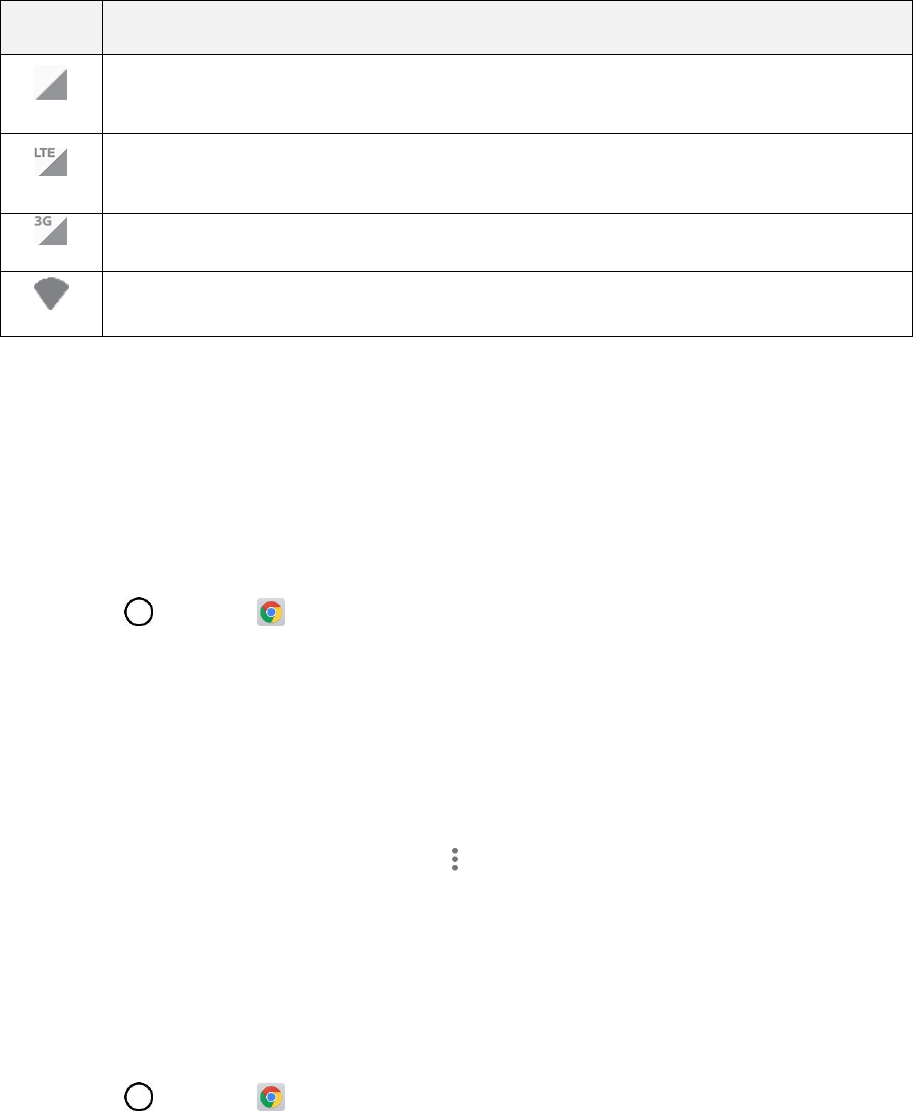
Internet and Social Networking 74
Data Connection Status and Indicators
Your phone displays the current status of your data connection through indicators at the top of the screen.
The following symbols are used:
Icon
Status
Network (full signal): The number of bars indicate the strength of the signal. More bars
mean a better signal.
Enhanced 4G LTE data service: Your phone is connected to the 4G enhanced LTE
network.
3G (data service): Your phone is connected to the 3G network.
Wi-Fi connection: Your phone is connected to a Wi-Fi network for data.
Chrome Browser
You can use the Chrome mobile Web browser to browse the Web on your phone. If you are signed in
with a Google Account, the Chrome browser will import all your bookmarks and other Web preferences
for use on your phone.
Use the Browser
Launching the browser is as easy as tapping an icon.
1. Tap > Chrome .
The browser opens.
2. Tap the address bar at the top and enter search words (for a Google search) or a Web address.
The search results appear or a Web page opens.
Chrome Support
■ To find help in the Chrome browser, tap > Help & feedback.
A Web page will open displaying Google help for Chrome.
Tip: For more information, visit: google.com/intl/en/chrome/browser/mobile/.
Add a Bookmark
Bookmark favorite sites using the browser menu options.
1. Tap > Chrome .
The browser opens.

Internet and Social Networking 75
2. Navigate to the Web page you want to bookmark, and tap > .
The Web page is added to bookmarks.
Bookmark Options
● Editing Bookmarks: From the browser, tap > Bookmarks > > Edit > edit the favorite >
.
● Deleting Bookmarks: From the browser, tap > Bookmarks > > Delete.
View Browser History
Use the browser menu options to view your browsing history.
1. Tap > Chrome .
The browser opens.
2. Tap > History.
The browser history window opens.
3. Tap an entry to open the Web page.
Open New Browser Tabs
Use tabbed browsing to switch between websites quickly and easily.
1. Tap > Chrome .
The browser opens.
2. Tap > New tab.
A new tab appears.
Tip: To view recently-closed tabs, tap > Recent tabs.
Browser Settings
Customize your experience with the Internet through the browser settings menu.
1. Tap > Chrome .
The browser opens.
2. Tap > Settings and customize your browser settings.
Your browser settings are saved.

Internet and Social Networking 76
Facebook
Post updates, read what your friends are up to, upload pictures and check-ins, and more with on-the-go
Facebook access.
Install the Facebook App on Your Phone
Before you use Facebook on your phone, you must download and install the app from the Google Play
store app. See Find and Install an App for details.
1. Tap > Facebook .
2. Tap INSTALL (or UPDATE).
The app will be downloaded and installed on your phone.
3. When the download has completed, tap OPEN.
Tap > Facebook .
Sign in to Your Facebook Account from Account Settings
1. Tap > Settings > General tab > Accounts & sync > ADD ACCOUNT.
2. Tap Facebook .
3. Enter your Email or Phone and password and tap LOG IN.
Your Facebook account is added to your phone.
Use Facebook
Once you’ve downloaded the app and signed in, you can post and read updates, upload pictures, tag
locations, and more, all from your phone.
1. Tap > Facebook .
The Facebook app launches.
If this is the first time you’ve used Facebook on your phone, enter your Email or Phone and
password and tap LOG IN to sign in to an existing account, or tap CREATE NEW
FACEBOOK ACCOUNT to set up a new Facebook account.
2. Tap What's on your mind? and type an update, tap Photo/Video and upload a picture or video
from the gallery, tap Check In to share your location, “Like” and comment on friends’ posts, and
more.
Twitter
Tweet (post messages) and view other people's tweets on Twitter. Login may be required to use Twitter.
For details on Twitter, visit twitter.com.

Internet and Social Networking 77
Install the Twitter App on Your Phone
Before you can use Twitter on your phone, you have to download and install the app from Google Play.
1. Tap > Play Store .
2. Tap the Search icon and search for "twitter."
3. Tap Twitter from the results list.
4. Tap INSTALL (or UPDATE).
The app will be downloaded and installed on your phone.
5. When the download has completed, tap OPEN.
Tap > Twitter.
Use Twitter
Read Twitter feeds, follow your friends, and tweet your own updates right from your phone.
1. Tap > Twitter.
The Twitter app launches.
If this is the first time you’ve used Twitter on your phone, tap Log in to sign in to an existing
account, or tap Sign up to set up a new Twitter account.
2. Tap type a tweet, and tap Tweet.
The tweet is sent and appears on your Twitter feed.
Duo
Duo is a one-to-one simple video calling app for everyone, regardless of OS (Android/iOS).
Open the Duo Application
■ Tap > Google > Duo .

Global Services 78
Global Services
With your phone and global roaming service from Sprint WorldwideSM Wireless Service, you can make
phone calls and use wireless data services around the globe on compatible CDMA and GSM/UMTS
networks. For a country-specific travel guide, select your phone and destination from sprint.com/traveltips.
Note: Global roaming is auto-enabled on your new Sprint phone. Visit sprint.com/globalroaming for more
information.
Activate Sprint Worldwide Service on Your
Account
Before using your phone in global roaming mode, you must activate Sprint Worldwide service.
To activate Sprint Worldwide service:
■ Chat with or email an international support rep by visiting sprint.com/swwsupport.
– or –
Call Sprint Worldwide Customer support at 1-888-226-7212.
Your Phone’s SIM Card for International GSM
Roaming
Your phone comes with a preinstalled SIM (Subscriber Identity Module) card to support roaming on
compatible GSM networks.
Note: Your SIM card should be preinstalled. If you need to reinstall your SIM card, follow the instructions
below.
Note: The SIM card included with your phone contains information specific to your phone and should be
retained for use on GSM networks.
Insert a SIM Card
Follow these instructions to insert a Nano SIM card. Remember to power off your phone before inserting
a Nano SIM card.
1. Gently insert the ejection pin into the hole on the card tray and then pull out the ejected tray.
2. Place the Nano SIM card into the correct section of the tray.

Global Services 79
Place gently with gold IC chip facing downward.
3. Insert the card tray back into the slot.
For more information, see Nano SIM Card.
Enable Global Roaming Mode
Your phone is designed to enter global roaming mode automatically when you activate your Sprint
Worldwide service, meaning that it should automatically connect to an appropriate CDMA/LTE network or
GSM/UMTS network when you travel. You may set global roaming options through the settings menu.
You may also need to set your network mode options through the settings menu. See Set the
Communications Method for Global Use.
Note: Global roaming is auto-enabled on your new Sprint phone. Visit sprint.com/globalroaming for more
information.
To set your roaming options manually:
1. Tap > Settings > Networks tab > More > Mobile networks > Roaming.
2. Tap Use roaming .
3. Select the desired roaming options for each category.
The selected options are set.
Set the Communications Method for Global Use
Select a communications method for an overseas carrier as needed.
1. Tap > Settings > Networks tab > More > Mobile networks.
2. Tap Network mode > Automatic / LTE/CDMA / CDMA / GSM/UMTS.
The communications method is set.
Note: At the time of purchase, your phone is set to the Automatic mode by default. This allows global
usage and normally will not need to be changed.
Select a Carrier
You can select a specific local carrier to use when traveling internationally. At the time of purchase, your
phone is preset to connect automatically to an appropriate carrier in your current area.
1. Tap > Settings > Networks tab > More > Mobile networks > 4G settings > Network
operator.
2. Tap an available network.
The selected carrier is set.
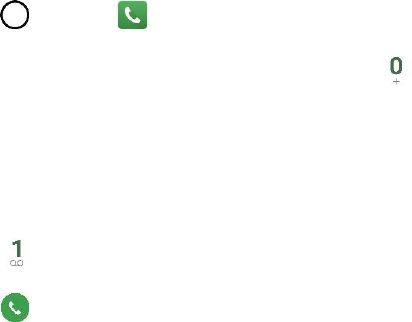
Global Services 80
To automatically select an appropriate carrier (default), tap Choose automatically.
To search for all available networks, tap Search networks.
Make and Receive Worldwide Calls
When traveling on international networks, you can place and answer calls as you would on the Sprint
network (see Place and Answer Calls), although some additional instructions may be required to place a
call. Some features and services are not available in all countries. For more information on services that
are available while roaming, visit sprint.com/sww.
Make Calls Using Plus (+) Code Dialing
Placing calls from one country to another country is simple with the Plus (+) Code Dialing feature. When
placing international calls, you can use Plus Code Dialing to enter the appropriate international access
code for your location (for example, 011 for international calls placed from the United States).
Note: Plus Code Dialing is only available when roaming internationally on GSM networks and on certain
CDMA networks in the United States, Canada, and the Caribbean.
Note: International access codes and dialing information are available online at sprint.com/sww.
To use Plus Code Dialing to place an international call:
1. Tap > Phone > Dial tab to display the phone screen.
2. If you are on the GSM network, touch and hold to insert a “+” on the phone dial screen. (The
“+” symbol automatically inserts the international access code for the country from which you are
calling.)
3. If you are on the CDMA network outside Canada or the Caribbean, enter the international access
code for the country from which you are calling.
4. Tap to insert the US country code, and then enter the area code and number.
5. Tap to place the call.
Sprint International Voicemail Service
Your Sprint voicemail will follow you as you travel. All of your unanswered calls will be forwarded to your
Sprint voicemail. You will need to be sure your voicemail box is already set up and that you know your
voicemail passcode.
Note: Sprint voicemail may not be available on all networks; check sprint.com/sww for service information.
International Voicemail Troubleshooting
There are a few tips to keep in mind when using Sprint voicemail while traveling.
● Some carriers may not support voicemail indicators. It may be necessary to call your voicemail to
see if you have any new messages.

Global Services 81
● If you hear the message “Please enter the number of the subscriber you wish to call,” enter your
10-digit wireless phone number.
Set Up Your Voicemail Access Number for International Use
To simplify accessing your Sprint voicemail while traveling, you can set up your voicemail access number
as a Contacts entry. This will make it faster and easier to access your messages while roaming
internationally.
1. Tap > Essentials > Contacts .
2. Tap to add a contact.
3. Type the contact information (for example, “My Voicemail”).
4. Touch and hold and then tap (+1), your area code, and your wireless phone number.
5. Tap SAVE.
Your voicemail access number is saved as a contact.
Access Your Voicemail Internationally
You will need to call your voicemail number to access your voicemail while roaming internationally.
New Message Indicators
Your voicemail message indicators may be displayed differently when roaming internationally.
● A “Message Waiting” indicator icon or a text message is displayed when a voicemail message is
received.
● You may see “Missed Call” on your screen prior to receiving a message notification.
● You must call voicemail in order to retrieve messages. Follow the instructions on the previous
page to store your voicemail number for easy access.
Retrieve Voicemail Messages
The voicemail retrieval process while traveling is the same as on the Sprint Network; however, you will be
required to enter your voicemail passcode.
To retrieve your voicemail messages:
1. Tap > Essentials > Contacts .
2. Tap the voicemail entry and then tap the number to call it.
Your phone dials your voicemail number.

Global Services 82
3. When your voicemail answers, tap , enter the passcode, and then tap to access your
voicemail.
Your voicemail box is accessed.
International Data Roaming
Sprint Worldwide Wireless Service can also keep you connected via email and Web browsing when
traveling in countries in which Sprint offers data service.
Data services are available on both CDMA and GSM/UMTS networks. Check sprint.com/traveltips and
sprint.com/sww to determine the services available where you are traveling.
Note: Prior to using your Sprint Worldwide GSM/UMTS Data Services, you must establish and utilize your
CDMA data services domestically on the Sprint Network.
Get Started With Sprint Worldwide Data Services
To use Sprint Worldwide Data Services, you will need to have these services activated on your account.
■ To activate, call Sprint Worldwide Customer Support at 1-888-226-7212. Representatives are
available 24 hours a day, 7 days a week to assist you.
Access Email and Data Services Internationally
To access your email and browse the Web when traveling, you may need to manually select the carrier
that provides Sprint service in your location. You can find a list of carriers for each country where GSM
data service is offered at sprint.com/sww. Then, follow the instructions below to select the appropriate
carrier network on your phone.
Access International Data Services on GSM/UMTS Networks
To select a GSM data service carrier for a specific country:
1. Tap > Settings > Networks tab > More > Mobile networks.
2. Tap Network mode > GSM/UMTS.
Data roaming on GSM/UMTS networks is set.
Access Email and Data Services Internationally on CDMA Networks
If data service is available on an international CDMA network, then you only need to set the phone to
CDMA; you will not need to select the specific carrier. Selecting a specific carrier is only necessary for
providers on the GSM network. If your phone has automatically selected a GSM network while traveling,
then you will need to set the phone to CDMA to access CDMA data services. (See Enable Global
Roaming Mode.) Visit sprint.com/sww for a list of services available in each country.

Global Services 83
Contact Sprint for Assistance with International
Service
If you experience any issues with voice or data services while outside of the United States, Sprint offers
customer support 24 hours a day. In the event that you do experience an issue, try the following actions:
● First try powering your phone off and then back on; this will force your phone to reregister with the
network.
● Try manually selecting another network. Information for selecting networks can be found in the
phone guide.
If neither of these actions resolves your issue, you will need to contact customer service (see below).
When calling to report an issue, the following information will be beneficial in trying to resolve your issue
as quickly as possible:
● Your wireless phone number.
● The city and country you are traveling in.
● Any error message that displays on your phone or that you heard when trying to place a call.
● If the issue is with data, were you able to place voice calls?
● If the issue is with voice service, were you able to access data?
Please call the numbers below if you need assistance:
While in the United States: Call 1-888-226-7212.
While traveling outside the United States:
● In GSM mode: touch and hold and then dial 1-817-698-4199.
● In CDMA mode: enter the country code and then dial 1-817-698-4199.
There is no charge for this call from your wireless phone.
From a landline phone when outside the United States:
Sprint Worldwide Customer Support can be reached from a landline phone at 1-817-698-4199. Access or
connection fees may apply. The toll free numbers below can also be used to contact Sprint Worldwide
Customer Support in the following countries:
Country
From Landline Phone
Caribbean (Anguilla, Barbados,
Cayman Islands, and Dominica)
1-888-226-7212
France
0800-903200

Global Services 84
Germany
0800-180-0951
Italy
800-787-986
Mexico
001-877-294-9003
Trinidad and Tobago
1-800-201-7545
United Kingdom
0808-234-6616
Note: This toll free service is available on ordinary landline phones and some public pay phones. This
service does not cover any hotel access charges.
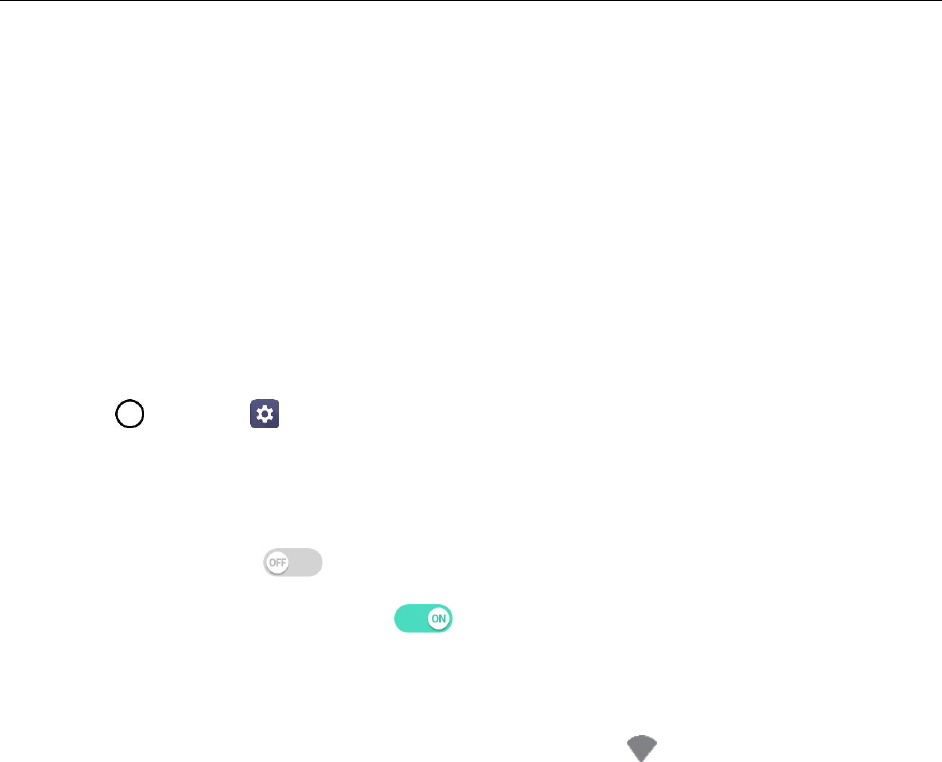
Connectivity 85
Connectivity
The following topics address your phone’s connectivity options, including Wi-Fi, Bluetooth, USB file
transfer and tethering, and more.
Wi-Fi
Wi-Fi provides wireless Internet access over distances of up to 300 feet. To use your phone’s Wi-Fi, you
need access to a wireless access point or “hotspot.”
The availability and range of the Wi-Fi signal depends on a number of factors, including infrastructure and
other objects through which the signal passes.
Turn Wi-Fi On and Connect to a Wireless Network
Use the Wireless & networks setting menu to enable your phone’s Wi-Fi radio and connect to an available
Wi-Fi network.
1. Tap > Settings > Networks tab.
2. Tap Wi-Fi.
You will see the names and security settings of in-range Wi-Fi networks.
3. Tap the Wi-Fi switch to turn Wi-Fi on.
To disable Wi-Fi, tap the switch again.
4. Tap a Wi-Fi network to connect, enter the password (if it’s not an open network), and then tap
CONNECT.
Your phone is connected to the Wi-Fi network. You will see ( ) in the status bar.
The password, for a household wireless LAN router, is sometimes found on a sticker on the
router (WEP, WPA, KEY, etc.). Contact the router manufacturer for information. For
password for a public wireless LAN, check with user's service provider.
Entering a password is not required if an access point is not security protected.
Note: The next time your phone connects to a previously accessed secured wireless network, you will not
be prompted to enter the password again, unless you reset your phone to its factory default settings or
you instruct the phone to forget the network.
Note: Wi-Fi networks are self-discoverable, which means no additional steps are required for your phone
to connect to a Wi-Fi network. It may be necessary to provide a user name and password for certain
closed wireless networks.
Wi-Fi Settings
Use the Wi-Fi settings menu to manually set your Wi-Fi connection options.

Connectivity 86
1. Tap > Settings > Networks tab.
2. Tap Wi-Fi.
You will see the names and security settings of in-range Wi-Fi networks.
3. Tap the Wi-Fi switch to turn Wi-Fi on.
To disable Wi-Fi, tap the switch again.
4. Tap > Advanced Wi-Fi.
5. Configure your Wi-Fi settings.
Your Wi-Fi settings changes are saved.
Disconnect Wi-Fi
You may wish to disconnect from a connected Wi-Fi network without turning Wi-Fi off.
1. Tap > Settings > Networks tab.
2. Tap Wi-Fi.
3. Tap the name of the connected access point and then tap FORGET.
After disconnecting from an access point, you may need to re-enter the password to
reconnect.
Wi-Fi Direct
Use Wi-Fi Direct to connect directly to other Wi-Fi Direct devices simply via Wi-Fi, without an access point
or the Internet.
1. Tap > Settings > Networks tab.
2. Tap Wi-Fi.
You will see the names and security settings of in-range Wi-Fi networks.
3. Tap the Wi-Fi switch to turn Wi-Fi on.
4. Tap > Advanced Wi-Fi > Wi-Fi Direct.
5. Tap a device with which to connect.
If connected via Wi-Fi, you will see a confirmation. Follow the onscreen instructions.
6. Accept the connection on the other device.
If a connection is not accepted after a certain period, the connection request is cancelled.
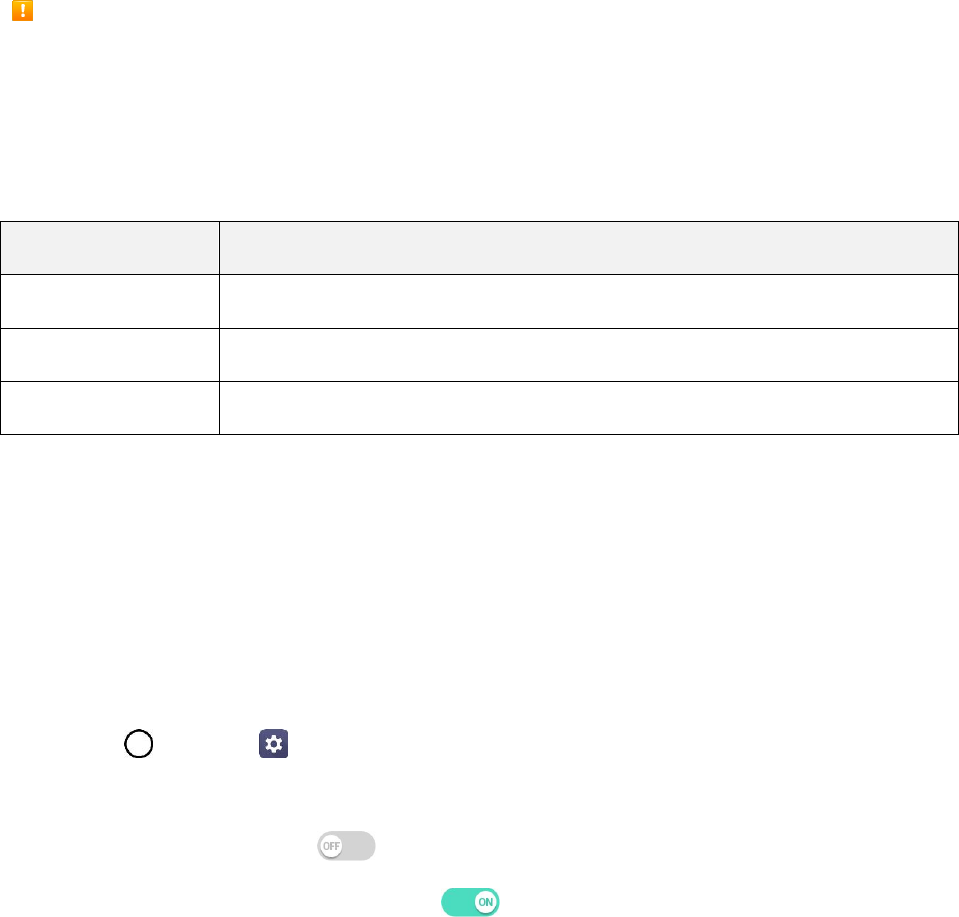
Connectivity 87
To stop a connection, tap the device > OK.
Bluetooth
Bluetooth® is a short-range communications technology that allows you to connect wirelessly to a number
of Bluetooth devices, such as headsets and hands-free car kits, and Bluetooth-enabled handhelds,
computers, printers, and wireless phones. The Bluetooth communication range is usually approximately
30 feet.
Bluetooth Function Cautions
Information may not appear correctly on connected devices depending on the transferred data.
Bluetooth Information
Bluetooth is a technology that enables wireless connection with PCs, Bluetooth devices with hands-free
features, etc.
Function
Description
Audio output
Listen to music wirelessly.
Hands-free calls
Call hands-free, using Bluetooth-capable hands-free devices and headsets.
Data exchange
Exchange data with Bluetooth devices.
Enable the Bluetooth Feature
Use the settings menu to enable or disable your phone’s Bluetooth capabilities.
● Wireless connection to all Bluetooth functions is not guaranteed for the phone.
● The phone may not connect properly depending on the other device.
● Noise may be experienced with wireless calls and hands-free calls depending on the conditions.
To enable Bluetooth:
1. Tap > Settings > Networks tab.
2. Tap Bluetooth.
3. Tap the Bluetooth switch to turn Bluetooth on.
To disable Bluetooth, tap the switch again.
Tip: You can also turn Bluetooth on or off with the toggle menu in the notification panel. Drag the status
bar down to display the notification panel and then tap Bluetooth to turn Bluetooth on or off.
Note: Turn off Bluetooth when not in use to conserve battery power, or in places where using a wireless
phone is prohibited, such as aboard an aircraft and in hospitals.

Connectivity 88
Pair Bluetooth Devices
Search for and pair nearby Bluetooth devices. Registered Bluetooth devices can be connected simply.
■ Enable the Bluetooth function on the Bluetooth devices being paired beforehand.
To pair Bluetooth devices:
1. Tap > Settings > Networks tab.
2. Tap Bluetooth.
Nearby devices appear in the “AVAILABLE DEVICES” list.
If a target device is not detected, tap SEARCH to search again.
3. Tap a device from the “AVAILABLE DEVICES” list, and follow the onscreen instructions to pair
with the device.
Methods to accept a Bluetooth connection differ depending on the devices used.
Unpairing from a Paired Device
1. From the Bluetooth settings menu, tap Settings next to the paired device you wish to unpair.
2. Tap Unpair.
The device is unpaired from your phone. To make another connection with the device, you will
need to pair again.
Connect to a Paired Bluetooth Device
You can listen to music over a Bluetooth stereo headset, or have hands-free conversations using a
compatible Bluetooth headset or car kit. It’s the same procedure to set up stereo audio and hands-free
devices.
1. Tap > Settings > Networks tab.
2. Tap Bluetooth.
Paired Bluetooth devices appear in the “PAIRED DEVICES” list.
3. Tap a device from the “PAIRED DEVICES” list.
Your phone connects to the paired device.
The pairing and connection status is displayed below the device’s name in the Bluetooth devices section.
When the device is connected to your phone, the Bluetooth paired icon is displayed in the status bar.
Depending on the type of device you have connected, you can then start using the headset or car kit to
listen to music or make and receive phone calls.

Connectivity 89
Note: Due to different specifications and features of other Bluetooth-compatible devices, display and
operations may be different, and functions such as transfer or exchange may not be possible with all
Bluetooth-compatible devices.
Send Information Using Bluetooth
You can use Bluetooth to transfer information between your phone and another Bluetooth-enabled device
such as a phone or computer.
Types of Data You Can Send via Bluetooth
You can send the following types of information, depending on the device you are sending to:
● Images and videos
● Calendar events
● Contacts
● Audio files
In the instructions below, Contacts data is being used as an example.
Sending Contacts Data via Bluetooth
1. Tap > Essentials > Contacts .
2. Tap > Share.
3. Tap the contact(s) you want to send and then tap SHARE > Bluetooth.
4. Tap a paired device to receive the data.
The contact information is sent.
If you see a message to confirm, follow the onscreen instructions.
Receive Information via Bluetooth
Your phone is capable of receiving a wide variety of file types with Bluetooth, including pictures, music
tracks, and documents such as PDFs.
1. When another device attempts to send a file to your phone via Bluetooth, you will see a request
to accept the file.
2. Tap ACCEPT.
The file is sent to your phone.
When your phone receives a file, you will see a notification. To open the file immediately,
drag the status bar down to display the notification panel, and then tap the notification.
When you open a received file, what happens next depends on the file type:

Connectivity 90
• Media files and documents are usually opened directly in a compatible application. For
example, if you open a music track, it starts playing in the default music application.
• For a vCalendar file, select the where you want to save the event, and then tap SAVE TO
CALENDAR. The vCalendar is added to your Calendar events.
• For a vCard contact file, if there are multiple vCard files on your storage card, you can
choose to import one, several, or all of those contacts to your contacts list.
Hotspot
Wi-Fi Hotspot allows you to turn your phone into a Wi-Fi hotspot. When this feature is turned on, you can
share your phone's mobile data services via Wi-Fi with other Wi-Fi enabled devices. The feature works
best when used in conjunction with 4G data services (although 3G service can also be used).
Important: Use of the Hotspot feature requires an additional subscription. Sign on to your account at
sprint.com/mysprint or access your account via Sprint Zone (Tap > Sprint Zone ) to learn more.
Note: Turning on Hotspot will disable your phone's connection to other Wi-Fi networks.
Set Up Wi-Fi Hotspot
1. Tap > Settings > Networks tab.
2. Tap Tethering > Wi-Fi hotspot.
3. Tap the Wi-Fi hotspot switch to turn Wi-Fi hotspot on.
Wi-Fi hotspot is enabled.
To disable Wi-Fi hotspot, tap the switch again.
Note: The best way to keep using the phone as a hotspot is to have it connected to a power supply.
Important: Write down the passkey (password) for this connection (shown onscreen).
Connect to Wi-Fi Hotspot
1. Enable Wi-Fi (wireless) functionality on your target device (laptop, media device, etc.).
2. Scan for Wi-Fi networks from the device and select your phone hotspot from the network list.
3. Select this phone and follow your onscreen instructions to enter the passkey (provided on the Wi-
Fi Hotspot page).
4. Launch your Web browser to confirm you have an Internet connection.
Tethering
Use Tethering to share your device’s Internet connection with a computer that connects to your device via
USB tethering, Wi-Fi hotspot or by Bluetooth.
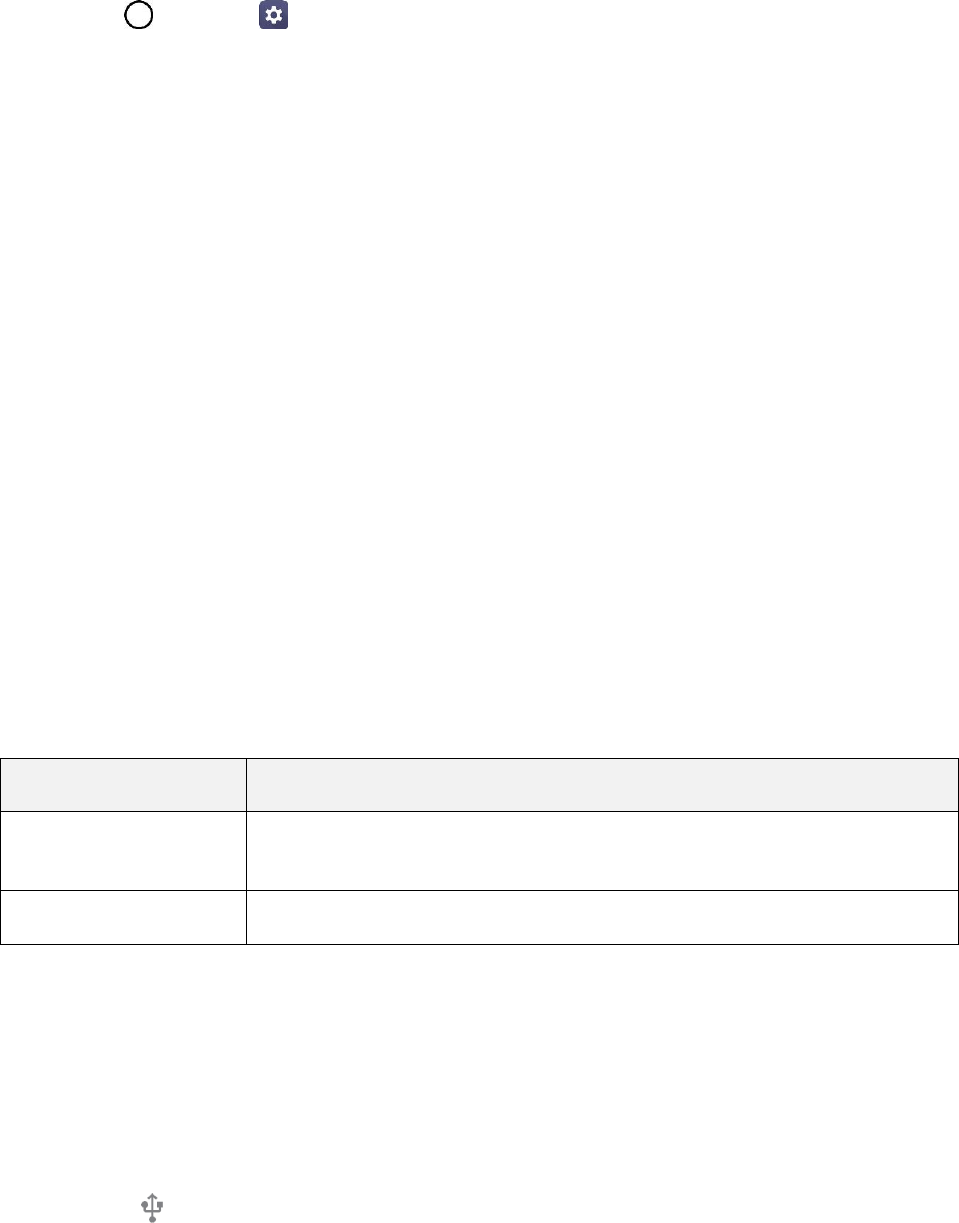
Connectivity 91
1. Tap > Settings > Networks tab > Tethering.
2. Select a tethering option: USB tethering, Wi-Fi hotspot or Bluetooth tethering.
USB tethering: Allows other devices to connect to your phone via USB cable.
Wi-Fi hotspot: Allows other devices to connect to your phone via Wi-Fi.
Bluetooth tethering: Pair your phone with the other device via Bluetooth.
Tip: For additional support with tethering, tap Help from the tethering menu.
Transfer Files Between Your Phone and a
Computer
You can use the supplied USB cable to connect your phone directly to your computer and transfer music,
pictures, and other content files.
For example, if you have a music album stored on your computer that you want to listen to on your phone
with any of the music apps, just attach your phone to the computer and copy the files to the music folder.
File Transfer Tips
● If you want to save data to a microSD card on your phone, make sure the microSD card is
installed and active. See microSD Card.
● Avoid removing the microSD card while transferring data.
● Data exchange may use the methods outlined in the following table:
Method
Description
File transfer
Transfer files between your phone and PC such as pictures, videos, and
music.
Photo transfer
Transfer image files between your phone and PC.
Transfer Files Between the Phone and a Computer
1. Connect your phone to your computer using the supplied USB/charging cable.
Insert the larger end of the cable into the charger/accessory port at the bottom of the phone.
Insert the USB end of the cable into an available USB port on your computer. You may need
to remove the USB cable from the charging adapter to access it.
2. When appears in the notifications area, drag the Status bar down to display the notification
panel.

Connectivity 92
3. You will see either USB PC connection as File transfer or Photo transfer.
The files on your phone can now be accessed via your computer.
For most transfers, you'll want to use File transfer.
To change the option, tap it in the notification panel to open the storage settings, and then tap
the desired option from the USB PC connection window.
4. On your computer, navigate to the detected device (such as through the My Computer menu) and
open it.
5. If available, select a drive (SD card for microSD card or Internal storage for internal phone
storage).
6. Select a folder (for example, Music for songs and albums) and copy files to it from your computer.
7. When you are done, disconnect your phone from your computer.
The transferred files are now saved to your phone or microSD card.
Content Sharing
Share your device’s data to other devices via various methods.
Playing Content
You can play photos, videos or music saved on the device from a TV.
1. Connect the TV and device to the same Wi-Fi network.
2. Execute a file from the Gallery and tap Play on other device.
3. Select the TV.
Note: To use Chromecast, update Google Play to the latest version.
Sending or Receiving Files
You can send or receive files saved on your device to another LG device or tablet.
■ Tap > Settings > Networks tab > Share & connect > File sharing > SmartShare Beam
and swipe to activate it.
Note: Make sure that your device is connected to the same wireless network as the file transfer target
device.
Note: Make sure that File sharing is turned on in the notification panel of both the device and the target
device.

Connectivity 93
Sending Files to Another Device
1. Select a file and tap > SmartShare Beam. You can also share multiple files at once by
tapping from the file list, selecting the desired files, then tapping SHARE > SmartShare
Beam.
When the search permit confirmation window appears, tap OK.
2. Select a device from the list of nearby devices that support SmartShare Beam.
The file is sent to the device.
Using Nearby Devices
You can play multimedia files saved on a connected device from your device.
1. From the Gallery, select > Nearby devices.
2. Select a device from the device list.
If the desired device is not seen on the device list, check that DLNA is turned on, then tap
Search nearby devices.
3. Play content saved on the selected device.

94
Apps and Entertainment
The following set of topics will explore the features that make your phone so much more than a phone,
from the camera and productivity apps to music, entertainment, and more.

Camera and Video 95
Camera and Video
You can use the camera or camcorder to take and share pictures and videos. Your phone comes with a
13 megapixel camera that lets you capture sharp pictures and videos and a 5 megapixel front camera.
Camera Overview
The camera's viewfinder screen lets you view your subject and access camera controls and options.
● Camera mode to select the camera mode from AUTO, SQUARE, MANUAL (Camera), or
MANUAL (Camcorder).
● Flash to turn the flash On, Off or set it to Auto.
● Swap camera to swap between the rear camera lens and the front camera lens.
● Film filter effect to apply film effects to your pictures.
● Mode to select the mode from: Auto, Panorama, 360 Panorama, Food, Popout, Snap,
Slo-mo, Time-lapse.
● Settings to adjust the following camera and video settings. See Camera Settings.
Learn More About Your Phone's Camera
For an overview of your phone's camera and its features, you can access more information through the
phone's settings menu.
1. Tap > Camera .
The camera viewfinder appears.
2. Tap > Help, and scroll through the topics to learn more.
Take Pictures and Record Videos
The following topics teach you how to take pictures and record videos with your phone’s camera.
Note: If you have a microSD card installed, pictures and videos can be stored to the microSD card. If no
card is installed, pictures and videos are saved to your phone’s memory.
Capturing Pictures/Videos
● File Format for Pictures: File format for pictures is JPEG.

Camera and Video 96
● File Format for Videos: File format for videos is MPEG4.
Camera Cautions
If the Lens Becomes Dirty: Fingerprints/smudges on the lens prevent the capturing of clear still
images/videos. Wipe the lens with a soft cloth beforehand.
Avoid Exposure to Direct Sunlight: Be careful not to expose the lens to direct sunlight for long
periods. It may discolor the color filter and affect image colors.
Flash Warning
Do not shine the flash close to your eyes. Do not look directly at the flash when shining it. Do not
shine the flash at other people's eyes as it may affect eyesight, etc.
Take Pictures
You can take high-resolution pictures using your phone’s camera.
1. Tap > Camera .
2. Frame your subject on the screen.
Note: You can fix the current exposure level and focus position by touching and holding the screen in the
AUTO mode. To turn the feature (AE/AF lock) off, tap a blank area on the screen.
3. Tap . Your picture will be automatically saved to the Gallery.
Note: When the screen is turned off or locked, start the camera by pressing the Volume Down (-) key
twice. To use this, make sure the feature is turned on in Settings.
Tap > Settings > General tab > Shortcut keys and turn on the switch.
Quick Share
After taking a picture or recording a video, you can immediately share it on the Camera.
1. Take a picture or record a video.
2. Tap the Quick Share icon that appears on the viewfinder to share via the displayed app.
– or –
Swipe the Quick Share icon towards the center of the screen to choose another sharing app.
Switching between Cameras
You can switch between the front and rear cameras to suit your environment.
On the camera screen, tap or swipe the screen in any direction to switch between the front and rear
cameras.

Camera and Video 97
Note: Use the front camera to take selfies. See Selfie Shot for details.
Selfie Shot
You can use the front camera to view your face on the screen and take selfies.
Gesture Shot
You can take selfies by using gestures.
■ Show your palm to the front camera and then clench your fist. You can also clench your fist and
then open it towards the front camera.
In three seconds, a photo is taken.
Note: To use this function, make sure that Gesture shot is selected under camera Settings.
Note: Make sure that your palm and fist are within the reference line so that the camera can detect them.
Interval Shot
You can take selfies at an interval.
■ While using the front camera, touch and hold . You can also show your palm to the camera,
then clench your fist twice quickly.
Four photos are taken at about two seconds interval after a timer delay of three seconds.
Auto Shot
You can use the face detection feature to take selfies easily and conveniently. You can set the device so
that, when you look at the screen, the front camera detects your face and takes a selfie automatically.
■ The white colored guide frame appears when the front camera detects your face. If the subject
within the guide frame stops moving, the guide frame color turns blue, then the camera takes a
photo.
Note: To use this feature, switch to the front camera, then tap the Settings icon > Selfie shot > Auto
shot.

Camera and Video 98
Gesture View
After taking a selfie with the front camera, you can preview the selfie immediately by placing the screen
close to your face.
Note: Tap > Gesture view to enable the Gesture view feature.
Note: Only one preview is available each time a photo is taken.
Note: If you rotate the device while in preview screen, the screen switches to camera mode.
Save as Flipped Image
Before taking a photo or recording a video with the front camera, tap > Save as flipped. The image is
flipped horizontally.
Record Videos
Record high-quality videos using your phone’s video camera.
1. Tap > Camera .
2. Frame your subject on the screen.
3. Tap to start recording the video.
4. The length of the recording is displayed on the screen.
Note: Tap to take pictures while recording video.
5. Tap to pause recording video. You can resume recording again tapping .
6. Tap to stop recording. Your video will be automatically saved to the Gallery.
Zoom In or Out
You can zoom in or out on the camera screen while taking a photo or recording a video.
■ On the camera screen, pinch or spread two fingers to zoom in or out, then use the displayed +/-
slide bar.
Note: The zoom feature is not available when using the front camera.
Take Various Shots
In the Camera auto mode, the following shots are available.
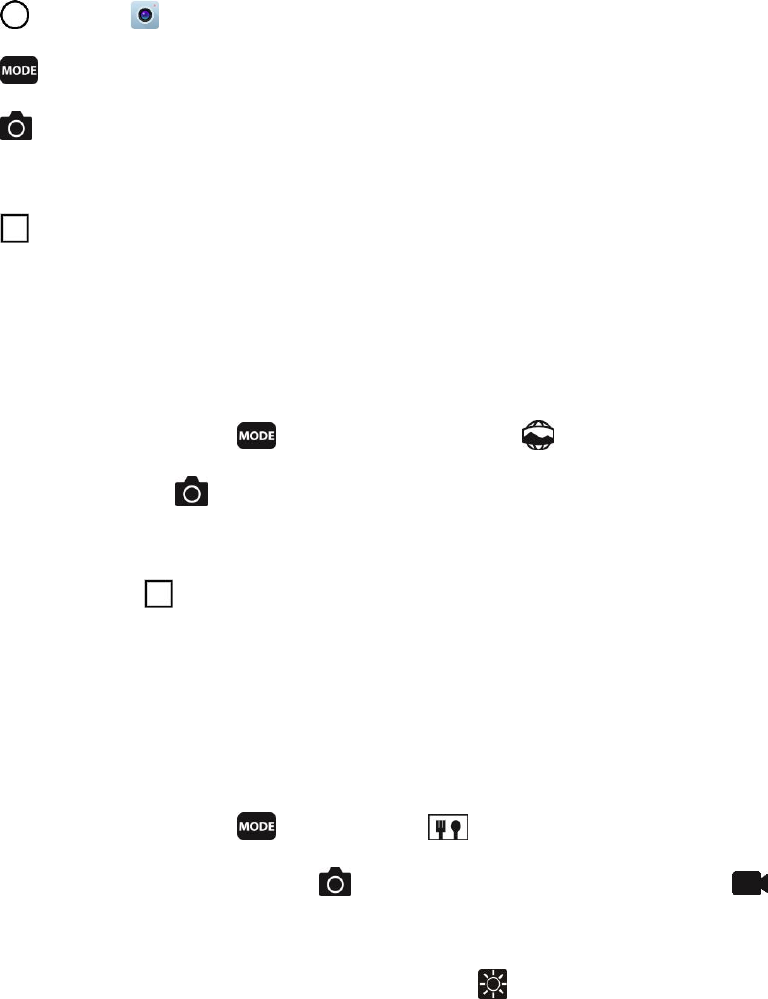
Camera and Video 99
Take Panoramic Photos
You can create a panoramic photo by moving the camera in one direction to photograph and stitch
continuous shots of a wide view.
1. Tap > Camera .
2. Tap > Panorama.
3. Tap and then slowly move the camera in one direction.
Move the device by following the direction of the arrow in the guideline.
4. Tap to stop capturing the panoramic.
360 Panorama
You can create a 360° panorama photo by moving the camera in one direction.
1. In the AUTO mode, tap MODE > the 360° Panorama icon .
2. Tap the Capture button and then slowly move the camera in one direction.
Move the device by following the direction of the arrow in the guideline.
3. Tap the Stop button to stop capturing the 360° panorama.
Food
The food's colors will be enhanced and brightened. You can also adjust the colors of your favorite food
image.
1. In the AUTO mode, tap MODE > the Food icon .
2. To take a photo, tap the Capture button . To record a video, tap the Record button .
Drag the color slide bar on the screen to adjust the white balance and select the best color.
If the slide bar is invisible, tap the White balance icon to adjust the white balance.

Camera and Video 100
Popout
You can take a photo or record a video by using both the standard and wide-angle cameras located at the
back of the device to record the scenes as if they were put in a frame. The scenes shown in the small,
front screen are shot by using the standard camera, and the scenes shown in the large, background
screen are shot by using the wide-angle camera. Change the front screen to a different shape or apply
various effects to take a unique photo or video.
1. In the AUTO mode, tap MODE > the Popout icon .
2. Tap the Layout icon and select the desired layout.
3. Select the desired effect:
Fisheye: Apply a convex lens effect to the area captured by the wide-angle camera.
B&W: Apply grayscale to the area captured by the wide-angle camera.
Vignette: Darken the edges of the area captured by the wide-angle camera.
Lens blur: Blur the area captured by the wide-angle camera.
4. Tap the Capture button to take a photo. To record a video, tap the Record button .
Snap
You can record short videos clips and assemble them into a 60-second short film.
1. In the AUTO mode, tap MODE > the Snap icon .
2. Tap the Record button .
Tap the icon once to record a three-second video clip. Touch and hold the icon to create a
longer video clip (maximum length: one minute).
3. Tap SAVE.
Slo-mo
You can create an entertaining video by changing the moving speeds of subjects in your video. This
feature allows you to record a video at a faster rate of speed and then play it at the standard speed so
that the video appears to be slowed down.
1. In the AUTO mode, tap MODE > the Slo-mo icon .
2. Tap the Record button and record a video.
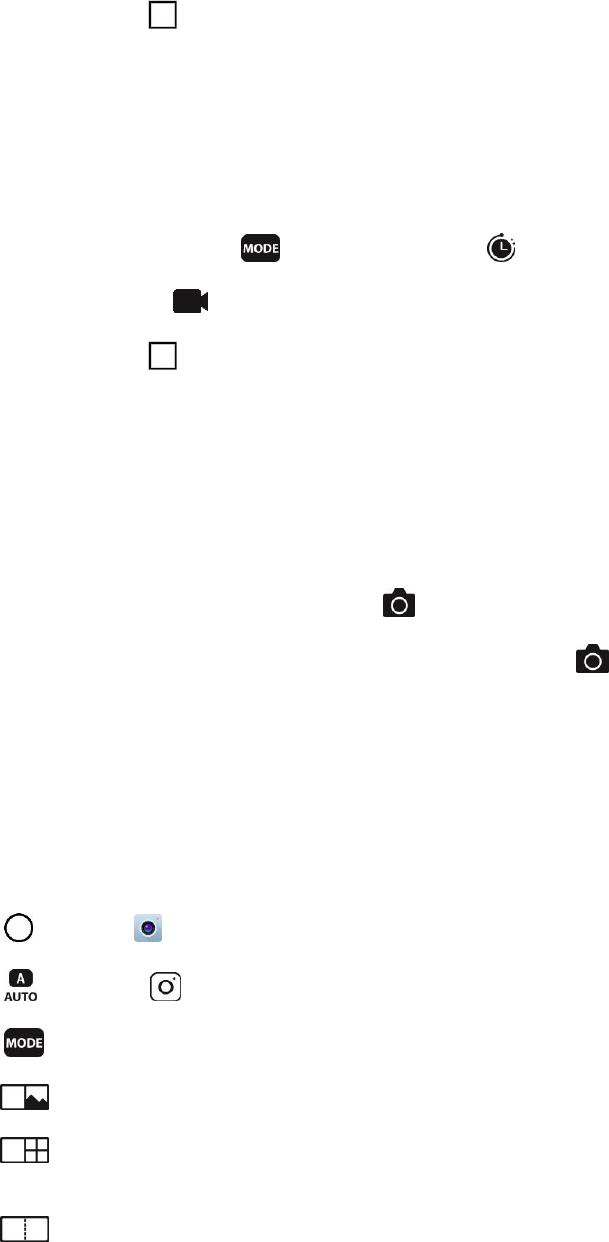
Camera and Video 101
3. Tap the Stop button to end the video recording.
Time-lapse
You can take a sequence of frames at set intervals to record changes that take place slowly over time,
such as cloud movements, celestial motions, traffic, and more.
1. In the AUTO mode, tap MODE > the Time-lapse icon .
2. Tap the Record button and record a video.
3. Tap the Stop button to end the video recording.
Note: While recording a Time-lapse, voices are not recorded.
Burst Shot
You can take continuous shots to create the illusion of moving pictures.
In the AUTO mode, touch and hold the Capture button .
■ Continuous shots are taken at a fast speed while the Capture button is held down.
Take Specialty Shots
You can take various specialty shots using different camera modes.
Square Mode
You can take multiple photo or videos in the form of a collage by using the front and rear cameras.
Photos and videos can be saved with different layouts.
1. Tap > Camera .
2. Tap > SQUARE .
3. Tap to choose a layout.
Snap shot: You can take a photo or record a video and preview it right away.
Grid shot: You can take up to 4 photos or 4 videos (max. of 3 seconds) organized in a
square.
Match shot: You can take 2 photos or videos at the same time or separately.

Camera and Video 102
Guide shot: You can take photos by following another photo's guide.
4. Tap or to take a photo or record a video.
5. Tap to save (if necessary).
Manual Camera Mode
You can create professional level photos using a variety of advanced features. Adjust the white balance,
focus, brightness, ISO, shutter speed and other options.
1. Tap > Camera .
2. Tap > .
3. Manually adjust the following camera settings, as necessary.
4. Tap to customize a variety of camera options to suit your preferences.
Photo size: Sets the desired value for the aspect ratio and size of your photos.
Timer: Sets the timer to automatically take photos after a specified period of time.
Cheese shutter: Enables photos to be taken with voice commands.
Tracking focus: Enables the lens to remain focused on the subject you touch on the screen,
even if the subject is moving. (Available when the Standard camera is in use.)
Tag locations: Saves the image with GPS location data.
Guide: Displays guides so that you can take photos or record videos based on the reference
lines.
Save as RAW: Stores the image as a RAW file format so that you can modify it. The DNG file
is created while taking a photo, then saved as a non-compressed high resolution image.
Add signature: Display a personalized signature on the photos.
Storage: Select if you want to store the pictures and videos in the Internal storage or SD card.
(Available when a memory card is inserted.)
Help: Provides help information for each camera menu.
5. Tap to take a picture.

Camera and Video 103
Manual Video Mode
You can record a video by manually customizing various options. Adjust values for the white balance,
focus, brightness, ISO, shutter speed and more.
1. Tap > Camera .
2. Tap > .
3. Manually adjust the camera settings, as necessary.
4. Tap to customize a variety of camera options to suit your preferences.
Video resolution: Sets the desired value for the aspect ratio and size of your videos.
Frame rate: Sets the frames per second value.
Bit rate: Sets the image quality for videos.
Hi-Fi: Records a video with Hi-Fi quality sound.
Timer: Set the timer to automatically take photos after a specified period of time.
Steady recording: Minimizes motion blur while recording a video.
Tracking focus: Enables the camera to remain focused on the subject you touch on the
screen, even if the subject is moving. (Available when the standard camera lens is in use.)
Tag locations: Saves the image with GPS location data.
Grid: Displays guide grids so that you can take photos or record videos based on the
horizontal and vertical reference lines.
Storage: Select if you want to store the pictures and videos in the Internal storage or SD card.
(Available when a memory card is inserted.)
Help: Provides help information for each camera menu.
5. Tap to record a video.
View Pictures and Videos Using Gallery
Using the Gallery application, you can view pictures and watch videos that you’ve taken with your phone’s
camera, downloaded, or copied onto your storage card or phone memory.
For pictures that are on your storage card or phone memory, you can do basic editing such as rotating
and cropping. You can also easily assign a picture as your contact picture or wallpaper and share
pictures with your friends.
View Pictures and Videos
You can access and view all your stored pictures and videos from your phone’s Gallery.

Camera and Video 104
1. Tap > Gallery .
The album list opens.
2. Tap an album (such as Camera).
The list of pictures and videos for the album opens.
To select another album, tap Back to return to the Albums tab.
3. Tap an image to view the picture or video.
The picture opens or the video begins playing.
Tap a picture or video to view it full screen.
Play a Video
Select a video from an album in your Gallery. Playing it using the Videos app provides the following
options.
Note: To adjust the sound volume, drag the right side of the video screen up or down.
Note: To adjust the screen brightness, drag the left side of the video screen up or down.
Pictures and Videos: Review Screen
After capturing a picture or video, from the camera screen, tap the thumbnail image at the corner of the
screen to see the item in the review screen. From there, you can access options such as save, view,
send, or delete the picture or video.
Pictures and Videos: Options while Viewing
● Zoom In or Out on a Picture: Tap the screen twice or pinch the screen to zoom in or out on a
picture.
● Viewing Videos: Use the onscreen controls to play, pause, or stop the video playback.
After selecting an album from the Albums tab, you can browse through the pictures and videos of that
album. Tap a picture or video to view it in full screen. By default, the pictures and videos in an album are
displayed in grid view.
Note: When viewing pictures, you can touch and hold on a picture or video to open a selection menu and
choose what to do with the picture or video.
Floating Button
To quickly move to the Home screen while viewing the Gallery in landscape orientation, touch and hold
the Back button , move your finger upward to the Home button , and then release it.

Camera and Video 105
Note: You can move the floating button's position by dragging it horizontally along the bottom part of the
screen.
Edit Pictures
In the Gallery application, you can edit a picture using Edit or rotate, or crop it and more by opening a
selection menu.
Edit a Picture
1. While viewing a photo, tap the Edit icon .
2. Use a variety of effects and tools to edit the photo.
3. Tap SAVE to save changes.
The edited photo overwrites the original file.
To save the edited photo as another file, tap the Menu icon > Save copy.
Write a Memo on the Picture
1. While viewing a photo, tap the Memo icon .
2. Write a memo on the photo and tap SAVE.
Related Content
You can edit and customize related content in the Gallery.
1. While viewing a picture preview, tap Related icon .
2. When the icon related with the date you took the photo appears, touch the screen.
You can view the photos related with the date you chose.
Note: Related contents can be related to up to four combinations of 'Memories, Date, Place, Camera
mode'.
Tap the Content Save icon to save the related content as a video.
Tap the Menu icon to access additional options.

Camera and Video 106
Rotate and Save a Picture
1. Tap > Gallery .
The album list opens.
2. Tap an album (such as Camera).
The list of pictures and videos for the album opens.
3. Tap the picture you want to rotate.
4. Tap > Rotate, then select either Rotate left or Rotate right.
The picture is rotated and saved to the phone or SD card, depending on your settings.
Crop a Picture
1. Tap > Gallery .
The album list opens.
2. Tap an album (such as Camera).
The list of pictures and videos for the album opens.
3. Tap the picture you want to crop.
4. Tap > Crop.
A crop box appears on the picture.
5. To adjust the crop box size, touch and hold the edge of the box. When directional arrows appear,
drag your finger inward to or outward to resize the crop box.
To move the crop box to the part of the picture that you want to crop, drag the crop box to the
desired size and position.
6. Tap OK to apply the changes to the picture.
The cropped picture is saved in the album as a copy. The original picture remains unedited.
Edit Videos
You can open edit menus by touching .
1. While viewing a video, tap the Edit icon .
2. Use a variety of effects and edit tools to edit the video.

Camera and Video 107
3. Tap SAVE to save changes.
Make a GIF File
You can easily make a GIF file using previously recorded video.
1. At the desired starting point while watching the video, tap the Menu icon > Create GIF.
The GIF file is generated for the time selected from the current time.
For videos less than 5 seconds, GIF images are automatically generated for the remaining
time.
Warning: The GIF making feature is provided for the user’s creative activity. If you infringe other’s
copyright or defamation laws by using the GIF making feature, you may be liable for civil and criminal
liability. Be sure to not duplicate or transfer the work of others without permission. LG Electronics cannot
accept any liability for the user’s action.
Delete Pictures and Videos
You can delete files by using one of the following options.
● Touch and hold a file from the file list, then tap Delete.
● Tap from the file list and delete the desired files.
● Deleted files are automatically moved to Trash and they can be restored to the Gallery within 7
days.
● On the Gallery, tap Gallery Menu icon > Trash. Tap the Delete icon to completely delete
the files. In this case, the files cannot be restore.
Share Pictures and Videos
The Gallery application lets you send pictures and videos using email or multimedia messages. You can
share pictures on your social networks (such as Facebook, Flickr, and Twitter) and share videos on
YouTube. You can also send them to another phone or your computer using Bluetooth.
Send Pictures or Videos by Email
You can send several pictures, videos, or both in an email or Gmail message. They are added as file
attachments in your email.
1. Tap > Gallery .
The album list opens.
2. Tap an album (such as Camera).
The list of pictures and videos for the album opens.
3. Tap the picture or video you want to share, then tap .

Camera and Video 108
To select multiple items, tap while viewing an album. Then tap all the items you want to
include and tap SHARE.
4. On the Share via menu, tap Email or Gmail.
5. Follow the onscreen prompts to complete and send the message.
For more information about using Gmail, see Create and Send Gmail.
Send a Picture or Video by Multimedia Message
Multimedia Messaging (MMS) lets you send pictures and videos using your phone’s messaging app.
Although you can send several pictures or videos in a multimedia message, it may be better to just send
one at a time, especially if the files are large in size.
1. Tap > Gallery .
The album list opens.
2. Tap an album (such as Camera).
The list of pictures and videos for the album opens.
3. Tap the picture or video you want to share, then tap .
To select multiple items, tap while viewing an album. Then tap all the items you want to
include and tap SHARE.
4. On the Share via menu, tap Messaging.
5. Follow the onscreen prompts to complete and send the message.
For more information about sending multimedia messages, see Send a Multimedia Message (MMS).
Send Pictures or Videos Using Bluetooth
You can select several pictures, videos, or both and send them to someone’s phone or your computer
using Bluetooth. Make sure that Bluetooth is on.
1. Tap > Gallery .
The album list opens.
2. Tap an album (such as Camera).
The list of pictures and videos for the album opens.
3. Tap the picture or video you want to share, then tap .
To select multiple items, tap while viewing an album. Then tap all the items you want to
include and tap SHARE.

Camera and Video 109
4. On the Share via menu, tap Bluetooth.
5. Follow the onscreen prompts to complete and send the files.
For more information, see Bluetooth.
Share Pictures or Videos via Additional Apps or Social Media
From Gallery, you can share your pictures and videos from a variety of apps and social media sites, such
as Facebook, Google+, Instagram, Flickr, and more. Available apps will vary depending on what you have
installed on your phone.
1. Tap > Gallery .
The album list opens.
2. Tap an album (such as Camera).
The list of pictures and videos for the album opens.
3. Tap the picture or video you want to share, then tap .
To select multiple items, tap while viewing an album. Then tap all the items you want to
include and tap SHARE.
4. On the Share via menu, tap the app you want to use.
5. Follow the prompts to complete and post or share your pictures or videos.
The upload is completed.
For confirmation, check the status bar for the upload information.
Share Videos on YouTube
You can share your videos by uploading them to YouTube™. Before you do this, you must create a
YouTube account and sign in to that account on your phone.
1. Tap > Gallery .
The album list opens.
2. Tap an album (such as Camera).
The list of pictures and videos for the album opens.
3. Tap the picture or video you want to share, then tap .
To select multiple items, tap while viewing an album. Then tap all the items you want to
include and tap SHARE.
4. On the Share via menu, tap YouTube.

Camera and Video 110
5. Enter the prompted information, such as title and description, and select a privacy option.
6. Tap Upload .
The upload is completed.
Camera Settings
You can adjust your camera’s settings using the icons on the main camera screen and the full camera
settings menu.
Switch Cameras
Your phone lets you use different types of cameras depending on your settings and downloads.
1. Tap > Camera .
The camera viewfinder appears.
2. Tap .
The camera switches.
Set Camera Functions
You can configure your camera’s settings to fit any situation and event.
1. Tap > Camera .
The camera viewfinder appears.
2. Tap .
The camera settings menu opens.
Note: Available options vary depending on the selected camera (front or rear camera) and the selected
camera mode.

Productivity 111
Productivity
The following topics detail many of your phone’s tools and features such as the maps and navigation,
calculator, clock, Capture+, QuickMemo+, and more.
Calendar
Use Calendar to create and manage events, meetings, and appointments. Your Calendar helps organize
your time and reminds you of important events. Depending on your synchronization settings, your
calendar stays in sync with Microsoft Exchange calendar or Google calendar.
In order to sync with your Google calendar, you must sign in to a Google Account on your phone. See
Google Account.
Calendar Operations
● Change Calendar View: From the Calendar, tap Day, Week, Month, Year or Agenda to change
the current view.
● View Next/Previous Month (Month View): From the Calendar, flick the screen left or right.
● View Next/Previous Week (Week View): From the Calendar, flick the screen left or right.
● View Next/Previous Day (Day View): From the Calendar, flick the screen left or right.
Add an Event to the Calendar
Add events to your calendar directly from the Calendar application.
1. Tap > Calendar .
The Calendar app opens.
2. Tap .
The add event window opens.
3. Enter an event name, location, start date/time, end date/time, etc., and then tap SAVE.
The event is added to your calendar.
Selecting a Calendar
● If you have more than one calendar, select a calendar in which to add events:
Select your Google Account to create a Google Calendar event. If you have several Google
Calendars on the Web, select one in which to add your event.

Productivity 112
• You can create multiple Google Calendars only in Google Calendar on the Web. After
creating them in Google Calendar on the Web, you’ll be able to see them in the Calendar
application on your phone. For more information about creating and managing multiple
Google Calendars, visit the Google website: calendar.google.com.
If you have synchronized your phone with an Microsoft Exchange account on your computer,
you can also select these calendars.
View Calendar Events
You can display the Calendar in daily, weekly, monthly, or agenda view. To change the Calendar view,
tap the current view in the top left corner and then tap Year, Month, Week, Day, Agenda, or Tasks.
1. Tap > Calendar .
The Calendar app opens.
2. Tap a date and then tap an event.
The event details appear.
In event details, tap to edit the event.
In event details, tap and follow the prompts.
Sync Calendars
You can select which calendars you’d like to sync on your phone, along with what types of information
you want to sync.
1. Tap > Calendar .
The Calendar app opens.
2. Tap > Calendars to sync.
3. Select the desired options by switching on or off from the items.
The sync settings have been updated.
4. Tap SAVE.
The selected calendars sync.
Synchronize an Microsoft Exchange Calendar
If you have set up a Microsoft Exchange account on your phone, you can also synchronize Microsoft
Exchange calendar events on your phone. Calendar events on your Microsoft Exchange will also show in
Calendar if you chose to synchronize with the Microsoft Exchange Server.
1. Tap > Settings > General tab > Accounts & sync > Microsoft Exchange.
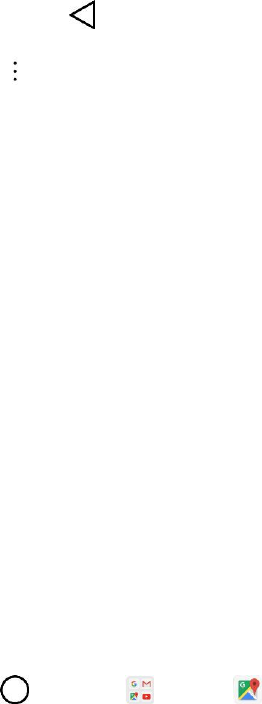
Productivity 113
To confirm your sync settings, tap the account name and make sure the Calendar switch is
on. Tap to return to the sync menu.
2. Tap > Sync now.
Note: If Microsoft Exchange ActiveSync doesn’t appear under the Accounts heading in the Settings menu,
you do not have an Exchange ActiveSync account configured on the phone. For information about adding
an account, see Add Exchange ActiveSync Accounts.
Navigation Apps
Your phone offers a number of location-based navigation programs to help you figure out where you are
and get you where you’re going.
Enable Location Services on Your Phone
Before using any location-based services, you must enable your phone’s location feature. For information
about setting your phone’s location options, see Location.
Google Maps
Use the Google Maps app to determine your location, find directions, browse local businesses and
attractions, rate and review places, and more.
View Maps of Specified Places
Use Google Maps to locate and map a specific address or destination.
1. Tap > Google > Maps to view videos stored in the storage.
Google Maps opens.
If prompted, follow the onscreen instructions to accept terms of use.
2. Tap the search bar.
3. Enter an address, city, facility name, etc., and then tap a candidate in the results list or tap the
Search icon in the keyboard.
A map of the specified location opens.
Scout
Scout™ by Telenav is a daily personal navigator that helps you get where you’re going. It lets you see
and hear turn-by-turn directions and it can provide important, personalized information about traffic and
alternate routes.
Install the Scout App on Your Phone
Before you use Scout on your phone, you may need to download and install the app from the Google
Play Store app.

Productivity 114
1. Tap > Play Store .
2. Tap the Search icon and search for "scout."
3. Tap Scout GPS Navigation & Meet Up from the results list.
4. Tap INSTALL, and then tap ACCEPT.
The app will be downloaded and installed on your phone.
5. When the download has completed, tap OPEN.
To open the app from the home screen, tap > Scout .
Use Scout as Your Personal Navigator
1. Tap > Scout .
The Scout app will open.
If prompted, accept the terms of use before continuing.
2. Follow the on-screen instructions to access, launch, and use.
Google Search
Search information saved on the phone and in phone applications as well as on the Internet.
Use Google Search
Type search terms in the Google Search bar to find information on your phone and around the globe.
1. From the home screen, tap the Google search bar or tap > Google > Google .
The Search window opens.
If confirmation appears, follow onscreen instructions.
2. Type your search keywords and tap .
Search results appear.
To search by voice, tap in the search bar and speak your search terms.
Google Search Options
● Changing Search Information: In the search window, tap > Settings > In Apps and select
where you want to search.
● Using Google Now: Google Now automatically searches for information based on search
keywords used, your current location, etc., and presents search results in the search screen.
Google Now also informs users of scheduled events.
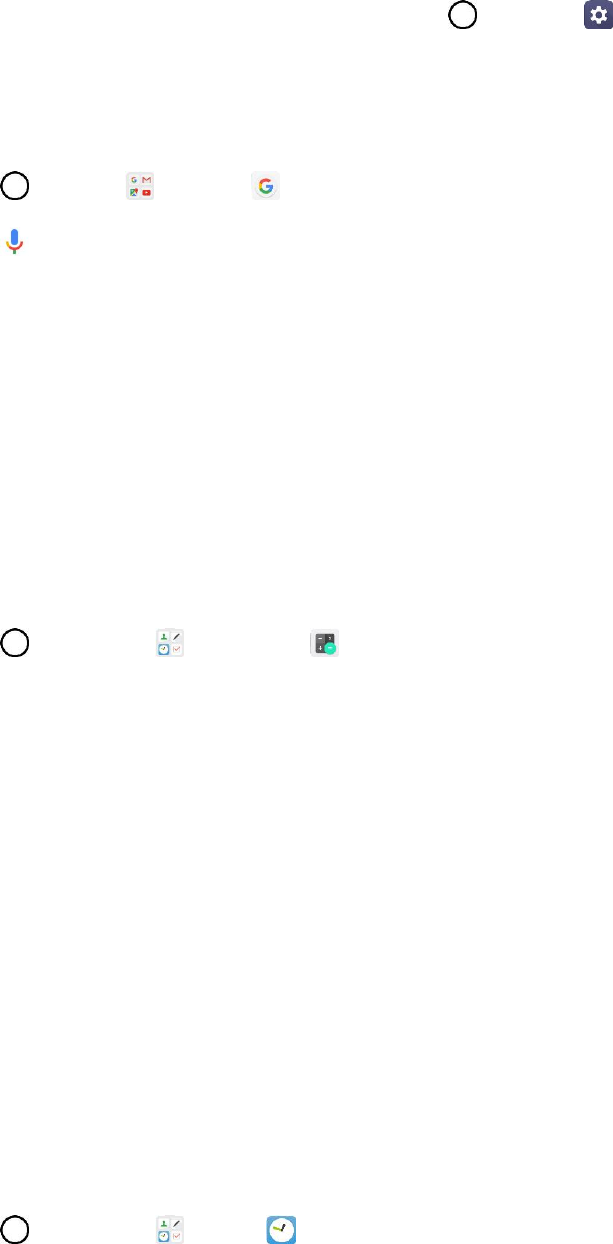
Productivity 115
To use all of Google Now’s functions, ensure that Google Location Reporting and Location
History are turned on in your location settings. Tap > Settings > General tab >
Location > Google Location History and select your options.
Use Google Voice Search
Use your voice to search instead of typing, with Google Voice Search.
1. Tap > Google > Google .
2. Tap in the search bar.
The Voice Search window opens.
3. Say your search terms.
Search results appear.
Calculator
Your phone’s convenient built-in calculator lets you perform basic and advanced mathematical equations.
1. Tap > Essentials > Calculator .
2. Use the keypad to make a calculation.
To use scientific calculator, drag the green colored slide bar located on the right side of the
screen to the left.
To restart a calculation, touch and hold the DEL button.
Clock
Your phone has a clock app that lets you set alarms, view time in time zones around the world, use a
stopwatch, set a timer, and use your phone as a desk clock.
Check the Time
You can check the phone any time on your phone. The current time displays in the upper right corner of
the status bar. Many widgets and lock screens also display the time and provide options for how time is
displayed.
Set Alarms
Set multiple alarms using your phone’s Clock app.
1. Tap > Essentials > Clock .

Productivity 116
2. Tap an existing alarm to change its time and other attributes or tap Add alarm to add a new
one.
3. Set the time of the alarm. You can change the time by scrolling the hour and minute hands or tap
the hour, minutes, and AM/PM fields to enter the time with the keyboard.
4. Tap Repeat to select the days when you want the alarm to sound. (If you don't set a repeat, the
alarm will only sound on the assigned day.)
5. Tap Alarm sound to select a ringtone for the alarm. The ringtone plays briefly when you select it.
6. Slide the button on the Alarm volume slider to the right to increase the alarm volume and to the
left to decrease it.
7. Tap Alarm with vibration to have the phone vibrate, in addition to playing the ringtone.
8. Tap Snooze duration to open a dialog box to set the amount of time to wait before sounding the
alarm again if it is not dismissed. You can set the alarm to ring repeatedly from 5 minutes up to 1
hour.
9. Tap Alarm note to enter a name for the alarm.
10. Tap Puzzle lock to enable this option if desired, which requires you to wake up enough to solve a
simple puzzle to dismiss the alarm.
11. When you're finished, tap SAVE.
Additional Clock Features
Your phone’s clock app provides additional useful features including world clock, stopwatch, and timer
functions. All features are available from the clock app display.
■ Tap > Essentials > Clock .
World Clock
The world clock lets you keep track of the current time in multiple cities around the globe.
1. Tap > Essentials > Clock > World clock tab.
2. Tap to add a city.
3. Enter the city name in the search field and tap on the keyboard.
– or –
Scroll through the cities list and tap the city.
4. You can add as many cities as you want. Repeat steps 2 and 3.

Productivity 117
Timer
The timer provides a countdown timer.
1. Tap > Essentials > Clock > Timer tab.
2. Tap the h/min/sec sections to set the timer.
3. Tap to start.
Tap to stop the timer and start over.
Tap to resume the timer after it's stopped.
Tap to pause the timer.
Stopwatch
The stopwatch lets you time events down to the hundredth of a second.
1. Tap > Essentials > Clock > Stopwatch tab.
2. Tap to start stopwatch time.
3. Tap to pause the stopwatch.
While measuring time, tap to record lap times.
4. Tap to resume the stopwatch after it's stopped.
– or –
Tap to reset the stopwatch and start over.
Capture+
The Capture+ feature allows you to create memos and capture screen shots. You can use Capture+ to
easily and efficiently create memos during a call, with a saved picture or from most phone screens.
1. While viewing the screen you want to capture and create a memo on, slide the status bar down
and tap .
2. Create a memo using the following options:
: Tap to save the current memo.
: Tap to undo the most recent action.

Productivity 118
: Tap to redo the most recently undone action.
: Tap to add typed text to the memo.
: Tap to add freehand notations to the memo.
: Tap to use the eraser on the drawing you've added to the memo.
: Tap to crop the memo.
: Tap to share the memo or change the background paper style.
Note: Please use a fingertip while using the Capture+ feature. Do not use your fingernail.
3. Tap to save the current memo.
4. Tap QuickMemo+ or Gallery to select where to save the note.
Discard the current Capture+:
■ Tap until you exit Capture+.
View the Saved Memo
Your memo can be saved in the QuickMemo+ application or in the Gallery application.
To view the memo saved in QuickMemo+:
■ Tap > QuickMemo+ and select the memo.
To view the memo saved in your Gallery:
■ Tap > Gallery and select the Capture+ album.
QuickMemo+
Use your phone’s QuickMemo+ app to save text, memos, lists, and more.
1. Tap > Essentials > QuickMemo+ .
The memopad list appears.
2. Tap and enter your memo title and text.
3. Tap .
The memo is saved.

Productivity 119
File Manager
View files stored on your phone.
1. Tap > Management > File Manager .
File Manager launches.
Follow onscreen instructions for first-time use and permissions.
2. Tap the file type and then tap the file you want to open.
The app opens and displays the file.
LG Mobile Switch
You can back up, restore and move the data saved on your device.
1. Tap > Management > LG Mobile Switch
2. Select USB cable, Wireless, or SD card.
3. Follow the on-screen instructions for transfer.
Warning: Resetting your device may delete backup files saved in internal storage. Make sure to copy and
store the important backup files to your PC.
HD Audio Recorder
The HD Audio Recorder app records audible files. Use them to simply remind you about something you
don’t want to forget (like a grocery list), record sound effects that you can attach to a message, or even
record your voice over background audio (such as music or a speech).
You can preset recording options or manually configure specific audio settings so that you can record
audio optimized for the selected mode.
1. Tap > Essentials > HD Audio Recorder .
2. Tap to select the recording mode.
Normal: You can record audio without extra settings.
Concert: You can record audio in a concert or other music events.
Custom: You can configure the desired settings to record audio.
Note: When you connect an earphone to the device, the Select mic icon appears. Tap the Select
mic icon and then select the microphone to use.
3. Tap > Settings to customize the file type, bit depth, sampling rate and other settings.

Productivity 120
4. Tap to record audio.
5. Tap to save the recorded file.
Studio Mode
With Studio mode, you can play an audio file or music and record your voice at the same time, create a
chord by recording your voice multiple times, and record your comments over the presenter's or speaker's
original audio file.
Note: Background music can only be played through earphones. Make sure to plug in earphones before
using this feature.
1. Tap > Essentials > HD Audio Recorder .
2. Tap > Custom.
3. Tap and select an audio file to use as background music.
4. Tap to select the microphone to use between Phone and Earphones.
5. To adjust the following values, move each slide of the following:
GAIN: You can adjust the sensitivity of the sound recorded by the microphone. The higher
the GAIN value is set, the more sensitively the sound is recorded.
LCF: You can filter any low-pitched noises such as the low hum of the air conditioner. The
higher the LCF (Low Cut Filter) value is set, the better high-frequency noises are filtered.
LMT: It can prevent clipping of the recorded sound. The higher the LMT (Limiter) value is set,
the more low frequency sounds that will not get clipped.
6. Tap to record audio.
7. Tap to save the recorded file.
You can monitor sound quality with the connected earpiece while recording an audio. While
recording an audio in Studio mode, the sound monitoring is not supported. You can hear only
the background music.

Entertainment and Activities 121
Entertainment and Activities
The following topics provide an overview of your phone’s entertainment apps, from music players and
YouTube, to health apps, games, and more.
Music
You can play audio files that are stored in your phone's storage. Copy audio files from your computer onto
your phone before you open the Music application. The Music Player application supports audio files in
numerous formats.
Music Player
You can play music and set as ringtone.
1. Tap > Essentials > Music .
2. You can select music tracks from the following tabs:
Songs: To browse through your downloaded music library.
Albums: To display your music library sorted by album.
Artists: To display your music library sorted by artist.
Genres: To display your music library sorted by genre.
3. Tap to see the additional options.
Favorites: To display your music library sorted by favorites.
Playlists: To select a customized playlist you’ve created.
Folders: To browse for music files using folders.
Nearby devices: To browse music files on other DLNA-compatible media servers.
Cloud: To browse music files saved on the cloud.
4. Once you’ve displayed a list of songs, you can browse through your available titles.
To listen to a song or playlist, tap it to begin playing.
Play a Song
1. Tap > Essentials > Music > Songs tab.
2. Select the song you want to play.

Entertainment and Activities 122
Create a Playlist
1. Tap > Essentials > Music .
2. Tap > Add to playlist.
3. Select the songs you want to add to the playlist and tap ADD.
4. Tap New playlist and enter a name.
5. Tap SAVE to save the playlist.
Assign a Song as a Ringtone
1. Tap > Essentials > Music > Songs tab.
2. Touch and hold a song you’d like to use as your new ringtone. A context menu is displayed.
3. Tap Set as ringtone and select Phone ringtone to set it as the default ringtone or Caller
ringtones to set it as a ringtone for a specific contact.
4. Confirm the song has been successfully assigned by navigating to your phone's ringtone menu.
Tip: To modify Ringtones, open the Contact entry and check the Ringtone field or tap > Settings
> Sound tab > Ringtone.
Sprint Music Plus
With Sprint Music Plus and the Music Store, Ringtone Store, and Ringback Tone Store, you can purchase,
download, and play music, ringtones, and ringback tones for your phone.
Install the Sprint Music Plus App on Your Phone
Before you use Sprint Music Plus on your phone, you must download and install the app from the Google
Play store app.
1. Tap > Play Store .
2. Tap the Search icon and search for "sprint music plus."
3. Tap Sprint Music Plus from the results list.
4. Tap INSTALL.
The app will be downloaded and installed on your phone.
5. When the download has completed, tap OPEN.
To open the app from the home screen, tap > Sprint Music Plus .

Entertainment and Activities 123
Access Sprint Music Plus
1. Tap > Sprint Music Plus .
The app opens.
The first time you use the app, tap Accept to agree to the Premium Services Terms of Use.
2. Tap a store option from the main page (Ringbacks Store, Music Store, or Ringtones Store), or
tap > Music (under Library) to access your music.
Tap the onscreen navigation tools to skip ahead or rewind. Tap at any time to see
additional options.
For more information, tap Menu > Settings > About or Help.
Note: If you have loaded music on to your phone from your computer (see Transfer Files between Your
Phone and a Computer), you will need to sync your music to listen to it through Sprint Music Plus. From
the Sprint Music Plus app, tap > Settings > Synchronize your music library. Once synced, you will
see your music in the library.
Purchase and Download Music from the Sprint Music Plus Store
From the Sprint Music Plus Store, you can shop for songs to purchase and download to your phone.
1. Tap > Sprint Music Plus > Music Store.
The app will open and display the Music Store.
2. Enter a song or artist in the search field or browse through options in the tabs in the center of the
screen.
3. Tap a song to select it.
The song information screen is displayed.
4. Follow the onscreen instructions to preview or purchase the song. Tap at any time to display
the Sprint Music Plus menu.
Tip: For ringtones or ringback tones, tap Ringtone Store or Ringback Tone Store from the Sprint Music
Plus main menu.
Back Up Your Downloaded Music Files
Sprint recommends that you back up your downloaded music files to your computer. Although the
downloaded files can only be played on your phone and on your account, backing them up to your
computer lets you access the files in case your phone is misplaced.
1. Connect your phone to your PC using a USB cable.
2. Open the Notifications Panel and tap the USB connection.

Entertainment and Activities 124
3. Select File transfer and use your computer to navigate to phone's Music folder.
4. Select and copy the music files to a folder on your computer’s hard drive.
YouTube
View videos uploaded to YouTube and upload your own videos to your YouTube account.
View YouTube Videos
You can use the YouTube app to view videos on YouTube even if you aren’t signed in to a YouTube
account.
1. Tap > Google > YouTube .
The YouTube app launches.
If you’re prompted to provide confirmation to use the site, follow the onscreen instructions to
continue.
2. Search through the YouTube channels and tap a video you want to see.
The video plays on your phone screen.
Tap the screen to pause or resume play while watching.
Post a Video to YouTube
You can post videos to your YouTube account from your phone. Before posting, you must set up a
YouTube account and sign in to it on your phone.
1. Tap > Google > YouTube .
The YouTube app launches.
2. Tap > .
3. Select a video to upload.
Enter a title, description, and tags, and select a privacy setting.
4. Tap .
The video is uploaded to your YouTube channel.
Sprint Zone
Access your Sprint account, get phone information and help, find recommended apps, and more.
1. Tap > Sprint Zone .
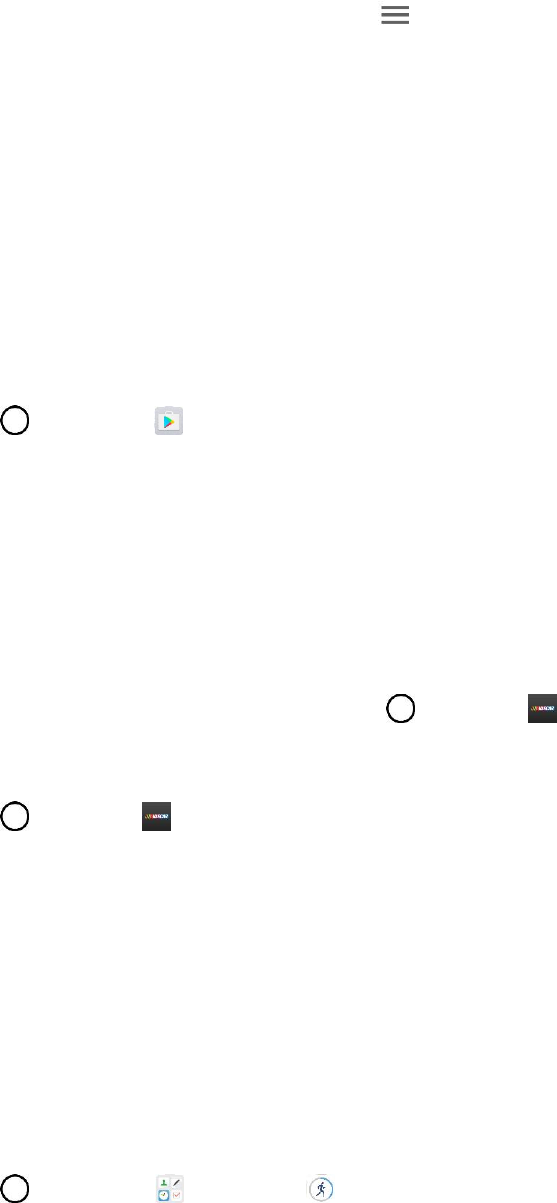
Entertainment and Activities 125
2. Tap an option on the main screen or tap Menu and select from a full list of options.
Note: Sprint Zone categories and options are subject to change. Check back frequently for new content
and updates.
NASCAR MOBILE
Now you have the ability to get every bit of NASCAR coverage, news, and stats right on your phone.
Install the NASCAR MOBILE App on Your Phone
Before you use the NASCAR MOBILE app on your phone, you must download and install the app from
Google Play.
1. Tap > Play Store .
2. Tap the Search icon and search for "nascar mobile."
3. Tap NASCAR MOBILE from the results list.
4. Tap INSTALL, and then tap ACCEPT.
The app will be downloaded and installed on your phone.
5. When the download has completed, tap OPEN.
To open the app from the home screen, tap > NASCAR .
Use the NASCAR MOBILE App
1. Tap > NASCAR .
The NASCAR Mobile app opens.
2. Follow the prompts to customize your app and begin following your favorite racers.
LG Health
You can set a daily exercise goal and check the amount of physical exercise to monitor your health and
fitness information.
Getting started with LG Health
You can configure LG Health when launching the app for the first time or after resetting it.
1. Tap > Essentials > LG Health .
2. Follow the on-screen instructions to complete the setup.
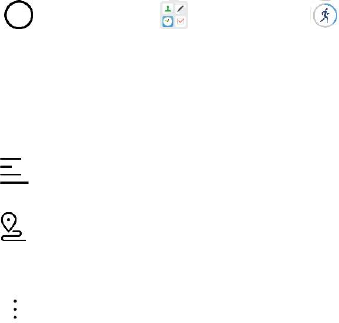
Entertainment and Activities 126
Using LG Health
You can easily view main information on LG Health and manage the amount of physical exercise and
health information.
1. Tap > Essentials > LG Health .
2. The following options are available.
View the record of your physical exercise on a particular date.
Record the route and amount of your physical exercise for each type of exercising
performed.
Set various LG Health settings, including your profile and goals.
Note: Health-related information provided by LG Health is designed for user convenience and cannot be
used for purposes of disease prevention, treatment, diagnosis or other medical issues.
Note: LG Health may vary or may not be available, depending on the country and the mobile service
provider. LG Health functions that are available and apps that can be added to LG Health may vary,
depending on the country. This is due to differing laws and regulations.
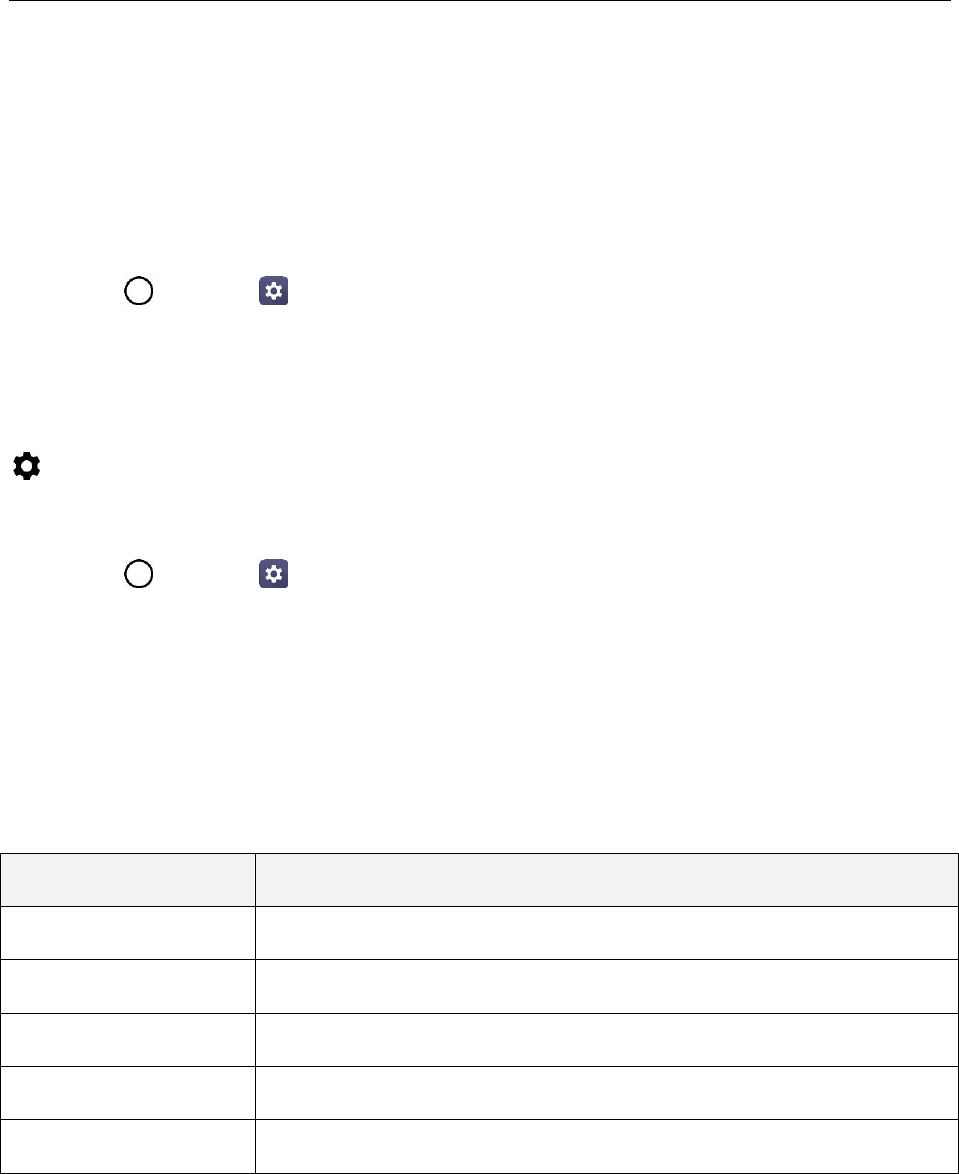
Networks Settings 128
Networks Settings
This group of settings lets you control your phone's Wi-Fi settings, Bluetooth, Tethering, VPN, Mobile
networks, and more.
Basic Settings
Your phone’s settings menu provides access to all your phone settings, from connections, display, and
sounds, to accounts, applications, and more.
Access Settings
1. Tap > Settings .
The settings menu opens.
2. Select categories and then select your settings options.
Tip: You can also access settings from the notification panel. Pull down the status bar and tap Settings
.
Access Networks Settings
1. Tap > Settings .
2. Tap Networks tab.
3. Set your networks options.
Your networks settings are saved and applied.
Networks Settings Overview
The network settings menu allows you to configure the following options:
Category
Description
Airplane mode
Turn on or off wireless connections.
Wi-Fi Calling
Set up Wi-Fi Calling and enable/disable it.
Wi-Fi
Enable and set Wi-Fi options.
Bluetooth
Enable Bluetooth connections.
Mobile data
Check your phone’s mobile data.
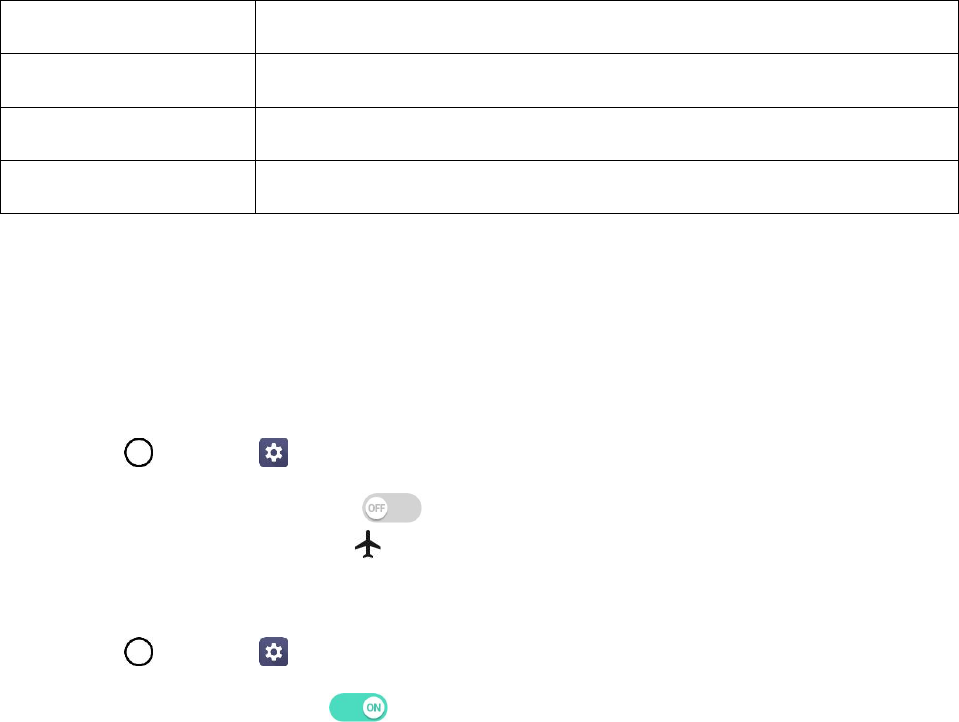
Networks Settings 129
Call
Set various call settings.
Share & connect
Share data and media with other devices.
Tethering
Share your mobile device's Internet connection.
More
Adjust additional network settings.
Airplane Mode
Airplane Mode (flight mode) allows you to use many of your phone’s features, such as games, and music,
when you are in an airplane or in any other area where making or receiving calls or data is prohibited.
When you set your phone to Airplane Mode, it cannot send or receive any calls or access online data.
Activate Airplane Mode
1. Tap > Settings > Networks tab.
2. Tap the Airplane mode switch to turn the function on. While in Airplane Mode, your
phone’s status bar will display .
Deactivate Airplane Mode
1. Tap > Settings > Networks tab.
2. Tap Airplane mode switch to turn the function off.
Wi-Fi Calling
You can make and receive calls over a connected Wi-Fi network to help improve voice and data coverage.
For details on Wi-Fi Calling feature, see Wi-Fi Calling.
Wi-Fi Settings
Your phone lets you take advantage of Wi-Fi hotspots for high-speed data access using available
computer networks. For details on your phone‘s Wi-Fi features and settings, see Wi-Fi Settings.
Bluetooth Settings
Your phone’s Bluetooth capabilities let you use wireless headsets, send and receive pictures and files,
and more. For details on your phone‘s Bluetooth settings, see Bluetooth.
Mobile Data Settings
You can check the current data usage, set to enable/disable mobile data, or set the mobile data limit.

Networks Settings 130
Turn Mobile Data On or Off
1. Tap > Settings > Networks tab > Mobile data.
2. Tap the Mobile data switch to turn it on.
–or –
Tap the Mobile data switch to turn it off.
Call Settings
Your phone's Call settings menu lets you configure options. For details on your phone's Call settings, see
Call Settings Menu.
Share & Connect Settings
Your phone lets you use the wireless technology that enables data transmission between devices.
Android Beam
When Android Beam is turned on, you can share files including music, videos, images, contacts and open
a web page or launch an app from another device.
1. Tap > Settings > Networks tab > Share & connect > Android Beam.
2. Tap to activate it.
3. Touch the back of your device with another device.
File Sharing
Send and receive files with computers and LG devices.
■Tap > Settings > Networks tab > Share & connect > File sharing.

Networks Settings 131
Media Server
Share media content with nearby DLNA-compatible devices.
1. Tap > Settings > Networks tab > Share & connect.
2. Tap Media server > Content sharing to allow nearby devices to access your content.
Screen Sharing
Allows you to project your device’s content on a compatible device, such as a TV that supports the
Miracast function.
1. Tap > Settings > Networks tab > Share & connect > Screen sharing.
2. Tap to activate it.
3. Select a device from the list of nearby devices.
If the desired device does not appear, tap SEARCH to refresh the list.
4. After connecting to the device, the device displays the screen of your device.
Note: Screen sharing turns off automatically if user escapes Screen sharing settings without any device
connected.
MirrorLink
Allows you to share apps between your device and the vehicle. To obtain more information about apps,
please visit http://www.mirrorlink.com/apps.
Note: Available only in cars that support MirrorLink.
Note: Download the MirrorLink app from the Google Play Store app.
1. Tap > Settings > Networks tab > Share & connect > MirrorLink.
2. Connect the device to a vehicle via USB and tap the Use MorrorLink switch .
If your device is connected to a device that supports automatic MirrorLink connection, Use
MirrorLink is automatically activated on your device.
Note: For your driving safety, access to some features will be restricted during a MirrorLink session.
LG AirDrive
Connect to your PC to manage your phone. Download LG Bridge from the LG Electronics website on
your PC before use. When you sign in to the same LG Account on your phone and PC, you can use the
LG AirDrive function.
1. Log in to the same LG account on a mobile device and a PC.

Networks Settings 132
2. Tap > Settings > Networks tab > Share & connect > LG AirDrive.
3. Run the LG Bridge application on your PC and select LG AirDrive.
Printing
The Printing menu allows you to manage your Google Cloud Print settings and print jobs.
■ Tap > Settings > Networks tab > Share & connect > Printing.
Tethering Settings
Your phone's Tethering settings menu lets you configure to share your phone's Internet connection with
other devices. For details on your Tethering, see Tethering.
More
This menu allows you to personalize additional wireless feature settings.
Mobile Networks
This menu allows you to configure various mobile network settings.
■ Tap > Settings > Networks tab > More > Mobile networks.
Mobile Data
Enable and disable data access over the mobile network.
1. Tap > Settings > Networks tab > More > Mobile networks.
2. Tap the Mobile data switch .
4G Settings
View your 4G network provider and IP address.
1. Tap > Settings > Networks tab > More > Mobile networks.
2. Tap the 4G settings to check Network operator and IP address.
Network Mode
Choose your preferred network mode.
1. Tap > Settings > Networks tab > More > Mobile networks > Network mode.
2. Choose from the following options:
Tap Automatic to turn on the Automatic radio band.

Networks Settings 133
Tap LTE/CDMA to turn on the LTE/CDMA radio band.
Tap CDMA to turn on the CDMA radio band.
Tap GSM/UMTS to turn on the GSM/UMTS radio band.
Access Point Names
Manage APN information.
1. Tap > Settings > Networks tab > More.
2. Tap Mobile networks > Access Point Names.
Roaming Settings
With your phone and global roaming service, you can make phone calls and use wireless data services
around the globe on compatible CDMA and GSM/UMTS networks.
Roaming Icon
Your display screen always lets you know when you’re off the Nationwide Sprint Network.
Anytime you are roaming, the phone displays the roaming icon ( ).
Roam on Other Digital Networks
When you’re roaming on digital networks, your call quality and security will be similar to the quality you
receive when making calls on the Nationwide Sprint Network. However, you may not be able to access
certain features, such as data services, depending on the available network.
Note: If you’re on a call when you leave the Nationwide Sprint Network, your call will be dropped. If your
call is dropped in an area where you think Sprint service is available, turn your phone off and on again to
reconnect to the network.
Check for Voicemail Messages While Roaming
When you are roaming off the Nationwide Sprint Network, you may not receive a notification of new
voicemail messages on your phone. Callers can still leave messages, but you will need to periodically
check your voicemail for new messages if you are in a roaming service area for an extended period of
time.
1. Dial your 10-digit wireless phone number.
2. When you hear your voicemail greeting, tap .
3. Enter your passcode at the prompt and follow the voice prompts.
When you return to the Nationwide Sprint Network, voicemail notification will resume as normal.

Networks Settings 134
Roaming Mode
Your phone allows you to control your roaming capabilities. By using the Roaming menu option, you can
determine which signals your phone accepts.
Choose from two different settings on your dual-band phone to control your roaming experience.
1. Tap > Settings > Networks tab > More > Mobile networks > Roaming.
2. Tap Use roaming to enable roaming on your device.
3. Tap each Domestic roaming option and International roaming option to place a checkmark and
connect to voice and data service while roaming.
Note: With Data roaming off, you can still transmit data with a Wi-Fi connection. See Wi-Fi Settings.
Roaming Alerts
Roaming alerts make it easy to manage your roaming by providing a warning when your device is
roaming on another carrier's network.
To turn Call alerts on or off:
1. Tap > Settings > Networks tab > More > Mobile networks > Roaming > > Set
roaming alerts.
2. Tap each roaming alert option to activate or deactivate this function. When active, an extra key
press is required for dialing when in a roaming area.
Note: Call alerts are turned on by default on your phone. Voice dialing and speed dialing are not available
when you are roaming with Call Guard enabled.
To place roaming calls with Call alerts on:
1. Tap > Phone .
2. Enter 1 + area code + the seven-digit number and tap .
To answer incoming roaming calls with Call alerts on:
1. Swipe in any direction. A message will be displayed notifying you that roaming charges will
apply.
2. Tap CALL.
Data Roam Guard
Depending on service availability and roaming agreements, your phone may be able to access data
services while roaming on certain digital systems. You can set your phone to alert you when you are
roaming off the Nationwide Sprint Network and try to use data services such as messaging.

Networks Settings 135
Note: Data roaming alerts are not turned on by default on your phone.
To set your Data roaming notification:
1. Tap > Settings > Networks tab > More > Mobile networks > Roaming > > Set
roaming alerts.
2. Tap the Domestic data roaming, International data roaming buttons or both to activate the
function.
To use data services when Data roaming alerts are active:
■ When a pop-up notification appears informing you that data roam charges may apply, tap
Connect or Always Connect to connect.
Virtual Private Networks (VPN)
From your phone, you can add, set up, and manage virtual private networks (VPNs) that allow you to
connect and access resources inside a secured local network, such as your corporate network.
Prepare Your Phone for VPN Connection
Depending on the type of VPN you are using at work, you may be required to enter your login credentials
or install security certificates before you can connect to your company’s local network. You can get this
information from your network administrator. Before you can initiate a VPN connection, your phone must
first establish a Wi-Fi or data connection.
Set Up Secure Credential Storage
If your network administrator instructs you to download and install security certificates, follow the
instructions below.
1. Tap > Settings > General tab > Fingerprints & security.
2. Tap Certificate management > Install from storage for desired certificates.
You can then download and install the certificates needed to access your local network. Your network
administrator can tell you how to do this.
Add a VPN Connection
Use the Wireless & networks settings menu to add a VPN connection to your phone.
1. Tap > Settings > Networks tab > More > VPN.
2. Tap Basic VPN > Add Basic VPN or LG VPN > Add LG VPN.
Note: A screen lock is required to configure a VPN.
3. Configure the settings according to the security details you have obtained from your network
administrator.
4. When finished, tap SAVE.

Networks Settings 136
The VPN is then added to the VPNs section of the VPN settings screen.
Connect to or Disconnect From a VPN
Once you have set up a VPN connection, use the Wireless networks settings menu to connect to or
disconnect from the VPN.
Connect to a VPN
1. Tap > Settings > Networks tab > More > VPN.
2. In the VPNs section, tap the VPN that you want to connect to.
3. When prompted, enter your login credentials, and then tap CONNECT. When you are connected,
the VPN connected icon appears in the notification area of the status bar.
4. Open the web browser to access resources such as intranet sites on your corporate network.
Disconnect From a VPN
1. Drag the status bar down to open the Notification panel.
2. Tap the VPN connection, and then tap Disconnect VPN to disconnect.
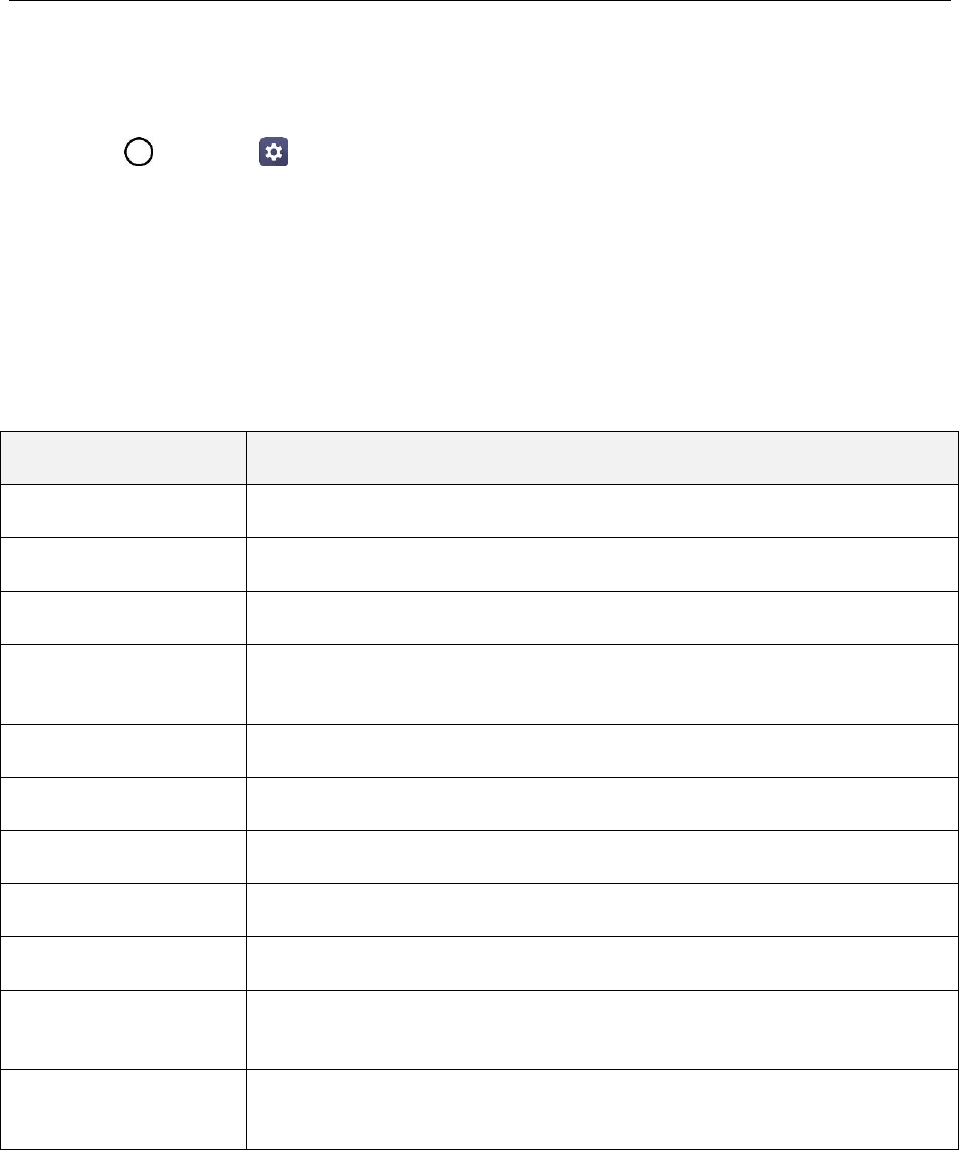
Sound Settings 137
Sound Settings
In the Sound settings menu, you can configure call and notification ringtones, audio volume, as well as
some related settings.
Access Sound Settings
1. Tap > Settings .
2. Tap Sound tab.
3. Set your sound options.
Your sound settings are saved and applied.
Sound Settings Overview
The sound settings menu allows you to configure the following options:
Category
Description
Sound profile
Set your phone's sound profile.
Volume
Adjust your phone's volume settings to suit your needs and your environment.
Ringtone
Set ringtones to alert you of incoming calls.
Ringtone ID
Set incoming calls with ringtones composed automatically from their phone
number.
Vibration strength
Set the vibration strength for calls, notifications, and touch feedback.
Sound with vibration
Set the phone to vibrate accompanying the ringtone.
Vibrate type
Set a vibrate type.
Do not disturb
Set a schedule when to prevent interruptions from notifications.
Lock screen
Choose if you want to show or hide notifications on the lock screen.
Apps
Prevent apps from displaying notifications or set apps to show notifications
with priority.
More
Adjust additional sound settings such as Notification sound, Vibrate on tap,
and Sound effects.

Sound Settings 138
Sound Profile
Set your phone's sound profile.
1. Tap > Settings > Sound tab.
2. Tap Sound profile.
3. Tap one of the three options:
Sound
Vibrate only
Silent
Volume
Adjust your phone's volume settings to suit your needs and your environment.
1. Tap > Settings > Sound tab.
2. Tap Volume.
3. Adjust each volume level.
Ringtone: Changes the volume of your call ringtones (if applicable).
Notification sound: Allows you to set this volume level. This is the volume of the ringtone
when you receive a notification.
Touch feedback & system: Changes the volume for feedback taps and system notifications.
Music, video, games & other media: Changes the volume of your music, videos, and other
media.
4. Tap OK.
Tip: You can adjust the ringer volume on the home screen or Applications screen, or almost any screen
by using the Volume keys on the back of your phone. In other applications such as Music, YouTube,
spoken directions, and other audio, the Volume keys control the volume of the application.
Ringtone
The phone ringtones alert you of incoming calls.
To select a ringtone for voice calls:
1. Tap > Settings > Sound tab.
2. Tap Ringtone.

Sound Settings 139
3. Tap a ringtone to select it and to hear it. If you want to set the ringtone, tap OK. If not, select
another ringtone or tap CANCEL.
To use a song as a ringtone:
1. Tap > Settings > Sound tab.
2. Tap Ringtone.
3. Tap and tap a song.
For details about using the Music Player application, see Music Player.
Ringtone ID
Allows you to set incoming calls with ringtones composed automatically from their phone number.
1. Tap > Settings > Sound tab.
2. Tap Ringtone ID.
3. To activate this feature, tap the Ringtone ID switch .
4. Tap Compose ringtones for to select if you want to create ringtones for everyone, your contacts,
or your favorites.
Vibration Strength
Allows you to set the vibration strength for calls, notifications, and touch feedback.
1. Tap > Settings > Sound tab.
2. Tap Vibration strength.
3. Use the each slider to set the vibration strength.
4. Tap OK.
Sound with Vibration
Allows you to set the phone to vibrate accompanying the ringtone.
1. Tap > Settings > Sound tab.
2. Tap the Sound with vibration switch to turn on the feature.
Vibrate Type
Allows you to set a vibrate type for incoming calls, incoming messages and email, alarms, and calendar
events.

Sound Settings 140
1. Tap > Settings > Sound tab.
2. Tap Vibrate type.
3. Set each vibrate type to the desired option.
4. Tap OK.
Do Not Disturb
Allows you to set a schedule when to prevent interruptions from notifications. You can set to allow certain
features to interrupt when Priority only is set.
1. Tap > Settings > Sound tab.
2. Tap Do not disturb.
3. Set the desired options as needed.
Lock Screen
Allows you to choose if you want to show or hide notifications on the lock screen.
1. Tap > Settings > Sound tab.
2. Tap Lock screen.
3. Tap the desired option.
Apps
Allows you to prevent apps from displaying notifications or set apps to show notifications with priority
when Do not disturb is set to Priority only.
1. Tap > Settings > Sound tab.
2. Tap Apps.
3. Tap the desired apps.
4. Choose Block to show no notifications from the app or choose Priority to show notifications with
priority on top of others and when Do not disturb set to Priority only.
More
This menu allows you to adjust additional sound settings.
Notification Sound
When you receive a notification such as the arrival of new messages, calendar events, or alarms, the
phone sounds a ringtone.

Sound Settings 141
1. Tap > Settings > Sound tab.
2. Tap More > Notification sound.
3. Tap a sound to select it and to hear it. If you want to set the sound, tap OK. If not, select another
sound or tap CANCEL.
Vibrate on Tap
Vibrate when tapping the Home touch buttons and during other UI interactions.
1. Tap > Settings > Sound tab.
2. Tap More > Vibrate on tap.
3. Tap the switch to turn on the feature.
Sound Effects
This menu lets you select whether you hear tones when touching numbers on the dialpad, selecting on-
screen options, and more.
1. Tap > Settings > Sound tab.
2. Tap More > Sound effects.
3. Tap the switch next to a desired option to enable or disable the feature.
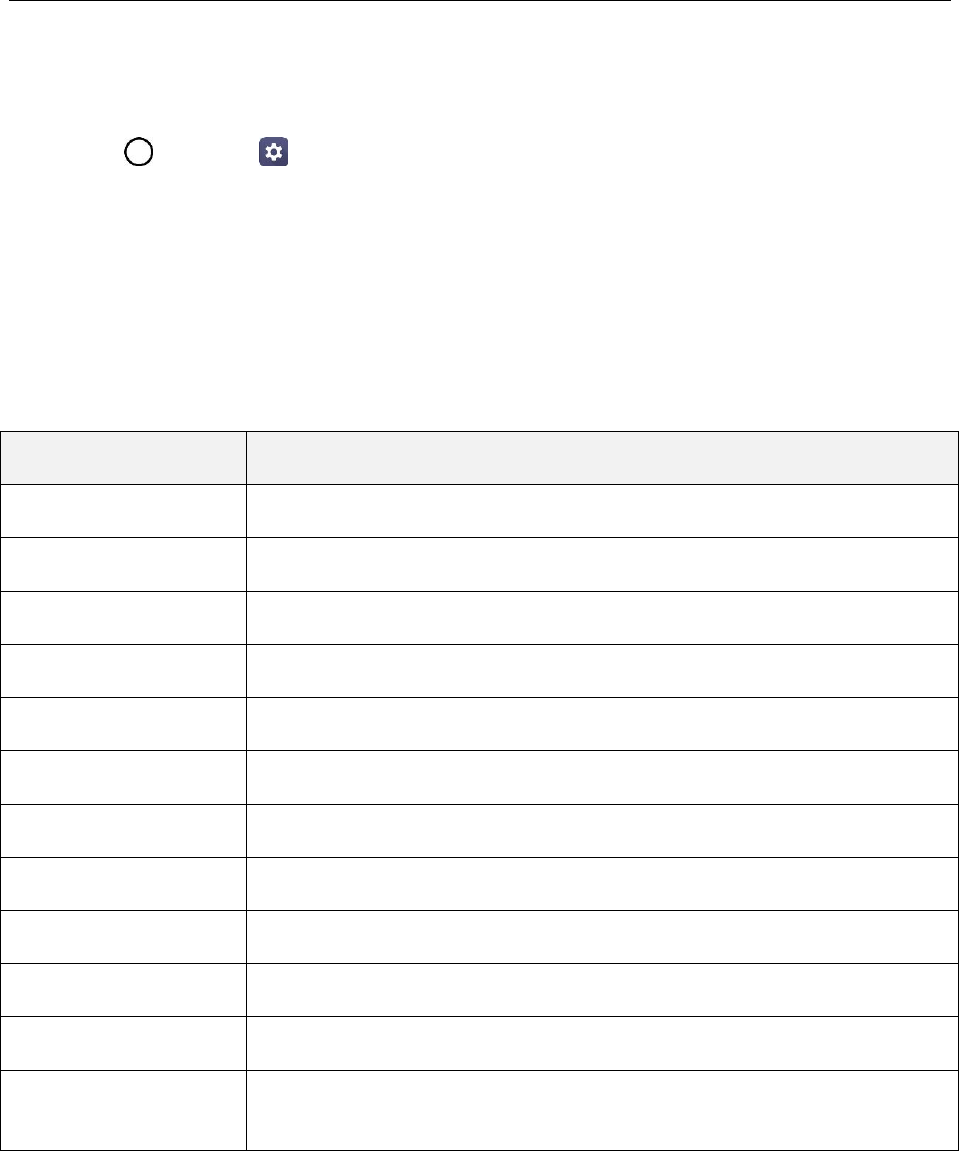
Display Settings 142
Display Settings
Adjusting your phone's display settings not only helps you see what you want, it can also help increase
battery life.
Access Display Settings
1. Tap > Settings .
2. Tap Display tab.
3. Set your display options.
Your display settings are saved and applied.
Display Settings Overview
The display settings menu allows you to configure the following options:
Category
Description
Home screen
Configure your phone's home screen settings.
Lock screen
Configure your phone's lock screen settings.
Theme
Choose the desired theme.
Home touch buttons
Configure options for your home touch buttons.
Font type
Choose the desired font type.
Font size
Choose the desired font size.
Bold text
Choose whether the phone displays bold text.
App scaling
Adjust the screen size of downloaded apps.
Display size
Set the size for the items and text viewed on screens without zoom capability.
Comfort view
Set to reduce the amount of blue light on screen to reduce eye strain.
Brightness
Adjust your screen’s contrast (brightness) to suit your surroundings.
Always-on display
Turn on to always display information, such as the date, time and
notifications, even when the screen is turned off.
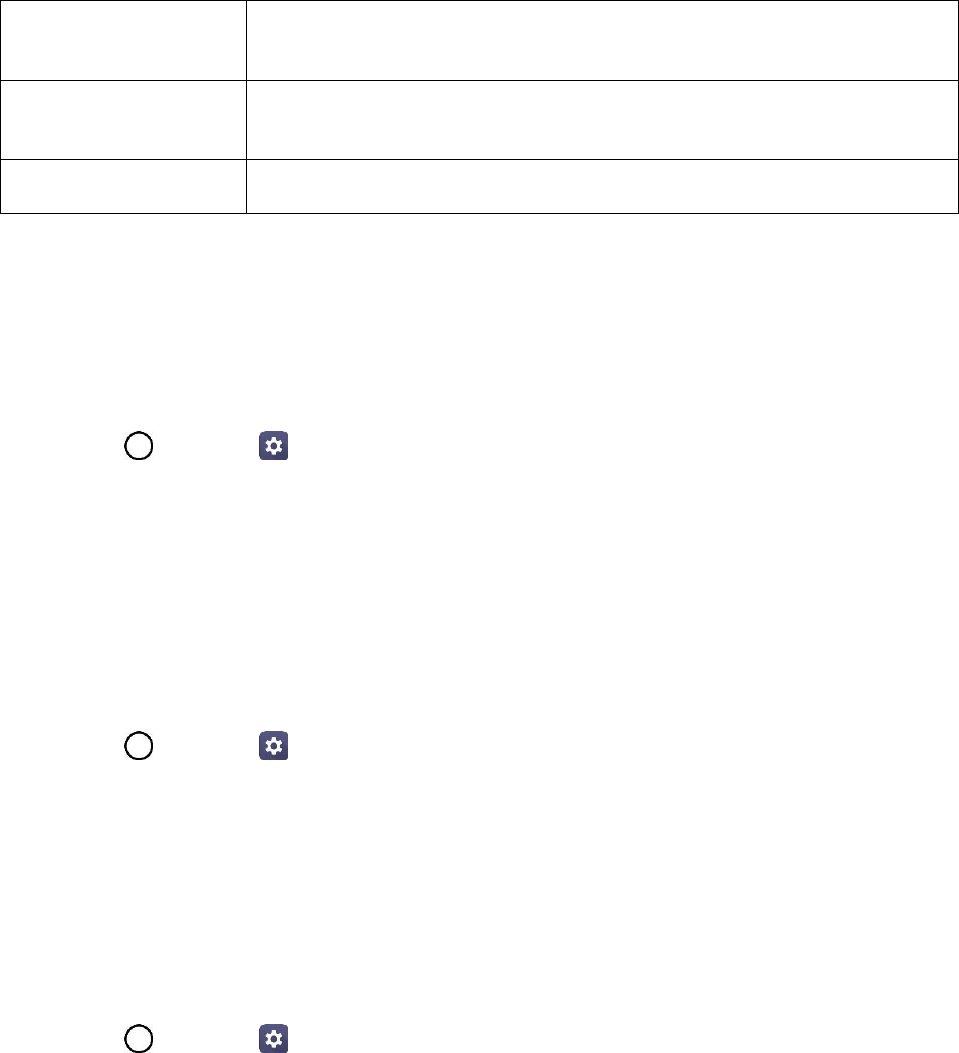
Display Settings 143
Auto-rotate screen
Choose whether the phone automatically switches the orientation of the
screen as you turn it sideways or even upside down.
Screen timeout
Select how long the display screen remains backlit after you touch the screen
or press a key before the screen darkens.
More
Adjust additional display settings such as KnockON and Screen saver.
Home Screen
Configure your phone's home screen settings.
Select Home
Choose the desired Home theme.
1. Tap > Settings > Display tab.
2. Tap Home screen > Select Home.
3. Tap Home (standard Android layout), EasyHome (simplified version for users less familiar with
Android navigation), or Home & app drawer (provides separate layout for the Home screen and
apps list).
Wallpaper
Choose the desired wallpaper for the home screen.
1. Tap > Settings > Display tab.
2. Tap Home screen > Wallpaper.
3. Choose a location and select the desired wallpaper.
4. Tap OK, SET WALLPAPER or APPLY to set it as the wallpaper.
Screen Swipe Effect
Choose the desired type of effect to display when you swipe from one home screen canvas to the next.
1. Tap > Settings > Display tab.
2. Tap Home screen > Screen swipe effect.
3. Tap the desired effect and then tap OK.
Icon shape
Choose the desired icon shape on the Home screen.

Display Settings 144
1. Tap > Settings > Display tab.
2. Tap Home screen > Icon shape.
3. Select between Original and Rounded square and then tap OK.
Sort Apps By
Sort apps by name or download date or download date on the home screen.
1. Tap > Settings > Display tab.
2. Tap Home screen > Sort apps by.
3. Tap the option you want to sort apps by.
Grid
Set the layout of the home screen.
1. Tap > Settings > Display tab.
2. Tap Home screen > Grid.
3. Tap the desired grid type and then tap OK.
Hide Apps
Choose if you want to show or hide apps on the home screen.
1. Tap > Settings > Display tab.
2. Tap Home screen > Hide apps.
3. Tap the app(s) that you want to hide and DONE.
Continuous Loop
Turn this on to loop back to the first screen after the last screen when swiping across the Home screen.
1. Tap > Settings > Display tab.
2. Tap Home screen > Continuous loop.
3. Tap the switch to turn this on.
Smart Bulletin
Enable this option to display an additional Home screen panel.
1. Tap > Settings > Display tab.

Display Settings 145
2. Tap Home screen > Smart Bulletin.
3. Tap the Smart Bulletin switch to turn this on.
4. Tap each app's switch to specify the settings.
Search
Turn this on to bring the Search feature simply by swiping down on the Home screen.
1. Tap > Settings > Display tab.
2. Tap Home screen > Search.
3. Tap the switch to turn this on.
Lock Screen
The Lock screen menu lets you configure screen lock options.
Select Screen Lock
You can increase your phone's security by setting up a Knock Code, pattern, PIN, or Password. When
these features are enabled, draw the correct unlock pattern, enter the PIN, or enter the password on the
screen to unlock and regain access to the phone.
1. Tap > Settings > Display tab.
2. Tap Lock screen > Select screen lock.
3. Select the desired screen lock option from the following options:
None: No screen lock set.
Swipe: Swipe any part of the screen to unlock the screen.
Knock Code: The Knock Code feature allows you to create your own unlock code using a
combination of knocks on the screen. You can access the home screen directly when the
screen is off by tapping the same sequence on the screen. You can also select which
notifications to show on the lock screen.
Pattern: Opens a set of screens that guide you through drawing a screen unlock pattern.
PIN: Enter a numeric PIN to unlock screen.
Password: Enter a password to unlock screen.
Fingerprints: Use your fingerprint to unlock the screen or content.
From then on, any time you wish to turn the phone on or unlock the screen, you must draw your unlock
pattern or enter the PIN or password to unlock the screen.

Display Settings 146
Note: You have five opportunities to enter your unlock Pattern, PIN or Password. If you've entered wrong
information five times in a row, you must wait 30 seconds before you can attempt again.
Note: When using Knock Code, failing to enter the correct sequence 5 times will display an outlined grid
box to allow you precise entry.
Smart Lock
Allows you to set when to automatically unlock the phone.
1. Tap > Settings > Display tab.
2. Tap Lock screen > Smart Lock.
Note: If you use this function, set a screen lock first.
Wallpaper
Select the wallpaper to display for your lock screen.
1. Tap > Settings > Display tab.
2. Tap Lock screen > Wallpaper.
3. Choose a location and select the desired wallpaper.
4. Tap SET WALLPAPER to set it as the wallpaper.
Clock
Select the position of the clock on the lock screen.
1. Tap > Settings > Display tab.
2. Tap Lock screen > Clock.
3. Select the position of the clock on the lock screen.
Shortcuts
Allows you to choose the shortcuts available on the lock screen.
1. Tap > Settings > Display tab.
2. Tap Lock screen > Shortcuts.
3. Tap a shortcut and select the desired app. You can also select to delete the shortcuts.
Screen Swipe Effect
Choose the desired screen swipe effect when you swipe the screen.

Display Settings 147
1. Tap > Settings > Display tab.
2. Tap Lock screen > Screen swipe effect.
3. Tap Square, Particle, Soda, Basic circle, or Vector circle.
Weather Animation
Show weather animation effect on the lock screen.
1. Tap > Settings > Display tab.
2. Tap Lock screen.
3. Tap the Weather animation switch to show a weather animation on the lock screen when it rains
or snows in your current location.
Contact Info for Lost Phone
Select whether to display the owner information on the lock screen and customize the owner information.
1. Tap > Settings > Display tab.
2. Tap Lock screen.
3. Tap Contact info for lost phone.
4. Enter the desired information in the field provided and tap SAVE.
Lock Timer
Choose the amount of time before the screen automatically locks after the screen has timed-out.
1. Tap > Settings > Display tab.
2. Tap Lock screen > Lock timer.
3. Tap the desired time.
Power Key Instantly Locks
Allows you to instantly lock the screen when you press the Power/Lock key.
1. Tap > Settings > Display tab.
2. Tap Lock screen.
3. Tap Power key instantly locks to turn on the feature.
Theme
Choose the desired theme.

Display Settings 148
1. Tap > Settings > Display tab.
2. Tap Theme.
Home Touch Buttons
Configure options for your home touch buttons.
To select the combination of your home touch buttons:
1. Tap > Settings > Display tab.
2. Tap Home touch buttons > Button combination.
3. Drag the icons to rearrange the Home touch buttons.
To select the color of your home touch buttons:
1. Tap > Settings > Display tab.
2. Tap Home touch buttons > Color.
3. Tap the desired color theme from the list.
Font Type
Choose the desired font type.
1. Tap > Settings > Display tab.
2. Tap Font type.
3. Tap a desired font type.
Font Size
Choose the desired font size.
1. Tap > Settings > Display tab.
2. Tap Font size.
3. Tap a desired font size.
Bold Text
Choose whether the phone displays bold text.
1. Tap > Settings > Display tab.
2. Tap the Bold text switch to set the bold text.

Display Settings 149
App Scaling
Adjust the screen size of downloaded apps.
1. Tap > Settings > Display tab.
2. Tap App scaling.
3. Tap an app on the list.
4. Select between Compatibility (16:9), Standard (16.7:9), and Full screen (18:9), then tap OK.
Display Size
Set the size for the items and text viewed on screens without zoom capability.
1. Tap > Settings > Display tab.
2. Tap Display size.
3. Use the slider to set the display size.
Comfort View
Set to reduce the amount of blue light on screen to reduce eye strain.
1. Tap > Settings > Display tab.
2. Tap Comfort view.
3. Tap the switch to use comfort view and select the blue light filter.
Brightness
Adjust your screen’s contrast (brightness) to suit your surroundings.
1. Tap > Settings > Display tab.
2. Scroll down to Brightness and use the slider to set the brightness level.
Tip: For the best battery performance, use the dimmer levels. You can also set Auto to adjust brightness
depending on the surrounding lighting.
Always-on Display
You can display the date, time, signature or other information on the screen even when the main screen
is turned off. Always-on display is a useful feature when you need to check the time quickly.
1. Tap > Settings > Display tab.
2. Tap Always-on display.

Display Settings 150
3. Tap the Always-on display switch to turn the feature on.
4. Tap Content to choose between Digital clock, Analog clock and Signature, then tap SAVE.
After choosing Signature, enter your signature and choose the font.
Note: Make sure to check that your signature does not exceed the input field.
5. Tap Night time to set a time to turn off the Always-on display function.
6. Turn this switch on and enter the time to turn off the Always-on display function, then tap SAVE.
Turn the Brighter Display switch on for brighter display.
Note: The battery may drain faster when you use Always-on display. Turn off this feature to use the
battery longer.
Auto-Rotate Screen
Choose whether the phone automatically switches the orientation of the screen as you turn it sideways or
even upside down.
1. Tap > Settings > Display tab.
2. Tap the Auto-rotate screen switch to automatically rotate the screen.
– or –
To disable the auto-rotate feature, tap the Auto-rotate screen switch again.
Note: Some applications on your phone do not support the Auto-rotate feature.
Screen Timeout
Select how long the display screen remains backlit after you touch the screen or press a key before the
screen darkens.
1. Tap > Settings > Display tab.
2. Tap Screen timeout.
3. Select 15 sec, 30 sec, 1 min, 2 min, 5 min, 10 min, 15 min, or Keep screen turned on.
Note: Long backlight settings reduce the battery’s talk and standby times. For the best battery
performance, use the shortest convenient timeout.
More Settings
The More settings menu allows you to adjust additional display settings.
Display Settings 151
KnockON
Turn on or off the screen by tapping the screen twice.
Screen Saver
Screensaver will be on when the phone is sleeping while docked and/or charging.
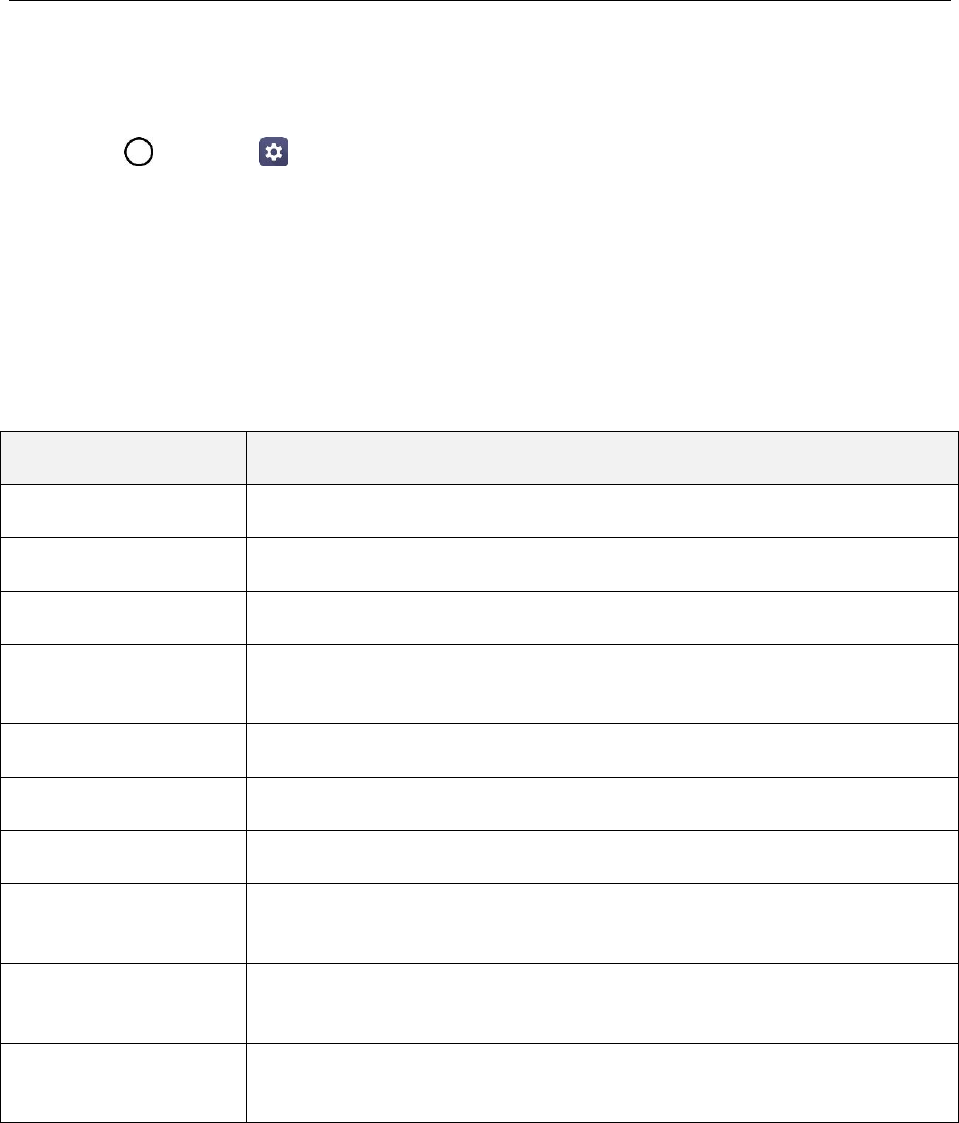
General Settings 152
General Settings
The following topics detail your phone's general settings, including Language & keyboard, Location,
Accounts & sync, and more.
Access General Settings
1. Tap > Settings .
2. Tap General tab.
3. Set your general options.
Your general settings are saved and applied.
General Settings Overview
You can set the following options in the General settings menu:
Category
Description
Language & keyboard
Set the language and keyboard type.
Location
Enable location service.
Accounts & sync
Manage and sync your accounts.
Cloud
Register a cloud account and view content saved on your cloud from the
device.
Accessibility
Configure any accessibility plug-ins you have installed on your phone.
Shortcut keys
Select whether to enable shortcut keys feature using the Volume keys.
Google services
Use Google Settings to manage your Google apps and account settings.
Fingerprints & security
Use the Fingerprints & security settings to help secure your phone and its
data.
Smart settings
Set to change your device settings according to the usage pattern and
location.
Date & time
Set your preferences for how the date and time is displayed. You can also
select a time zone.

General Settings 153
Storage
Monitor the used and available internal memory and SD card (if available).
You can also mount/unmount the SD card and erase its contents.
Battery & power saving
Show any battery information and configure options.
Memory
Monitor the memory used on average and the memory used by apps in the
device.
Smart cleaning
Clean up temporary files or apps that are no longer used to free up storage
space.
System updates
From time to time, updates may become available for your phone. You can
download and apply updates through the Settings menu.
Apps
View details about the applications installed on your phone, manage their
data, force them to stop, and set whether you want to permit installation of
applications that you obtain from websites and email.
Tap & pay
Make payments with your device instead of a credit card.
Backup & reset
Back-up your data, automatically restore data, and erase all the data on your
phone.
About phone
Displays information such as the network, battery, hardware, and software.
Regulatory & Safety
View regulatory marks and related information on your device.
Language & Keyboard
Your phone's Language & keyboard settings let you select a language for the devices screens and menus,
as well as manage a personal user dictionary. The keyboard settings let you select a preferred input
method, control keyboard settings, and more.
Language
You can choose to display your device's on-screen menus in multiple languages.
1. Tap > Settings > General tab > Language & keyboard > Language.
2. Select a language from the list.
Spelling Correction
Allows spelling correction when using the on-screen keyboard.
Keyboard & Input Methods
Shows the current keyboard type and the available input methods. Tap the options to configure each
keyboard’s settings.

General Settings 154
Text-to-Speech Output
Tap to set the preferred engine or general settings for text-to-speech output.
Pointer Speed
Adjust the pointer speed.
Reverse Buttons
Reverse the mouse buttons to use the primary button on the right side.
Location
The Location settings menu allows you to enable location service. Your phone determines your
approximate location using GPS, Wi-Fi and mobile networks.
● Tap > Settings > General tab > Location.
Mode : Set the location mode as High accuracy (GPS and networks), Battery saving
(Networks only), or Device sensors only (GPS only).
RECENT LOCATION REQUEST: View apps that recently requested location information.
Low power location estimation: Estimate the device location by using low power
consumption.
Google Location History: Permit Google services to collect your location information.
Accounts & Sync
Use the Accounts & sync settings menu to add, remove, and manage your Google and other supported
accounts. You also use these settings to control how and whether all applications send, receive, and sync
data on their own schedules and whether all applications can synchronize user data automatically. Gmail,
Calendar, and other applications may also have their own settings to control how they synchronize data;
see the sections on those applications for details.
1. Tap > Settings > General tab.
2. Tap Accounts & sync.
Tap ADD ACCOUNT to add new account.
Tap Auto-sync data to automatically sync your account data.
Cloud
You can register a cloud account and view content saved on your cloud from the device.
1. Tap > Settings > General tab > Cloud.
2. Tap ADD ACCOUNT and follow the on-screen instructions to complete the setup.

General Settings 155
Accessibility
Use the Accessibility settings to configure any accessibility plug-ins you have installed on your phone.
Note: Requires additional plug-ins to become selectable.
Vision
The Vision setting allows you to configure the visual options.
1. Tap > Settings > General tab > Accessibility > Vision.
2. Set the following options:
TalkBack: Tap the TalkBack switch to turn it on. Tap Settings at the bottom of the
screen to adjust the TalkBack settings. When TalkBack is turned on, the touchscreen settings
require the user to first tap an item they wish to select, and then double tap the item again in
order to access this feature.
Voice notifications: Use automatic spoken alerts for incoming calls and messages.
Font size: Tap to set the size of the text.
Bold text: Tap to set bold text.
Display size: Set the items on the screen to a size that is easy for you to see. Some items
may change position.
Touch zoom: Zoom in or out by triple tapping the screen.
Window zoom: Zoom in or out within a window and invert the color.
Large mouse pointer: Magnify the mouse pointer.
High contrast screen: Turn the background color into black for a high contrast screen.
Screen color inversion: Tap to invert the colors of the screen and content.
Screen color adjustment: Set the color contrast for better screen viewing.
Grayscale: Tap to set a grayscale screen.
End calls with the Power key: Tap so that you can end voice calls by pressing the
Power/Lock key. When this option is enabled, pressing the Power/Lock key during a call
does not lock the screen.
Hearing
The Hearing setting allows you to configure hearing options.
1. Tap > Settings > General tab > Accessibility > Hearing.
2. Set your preferred options.
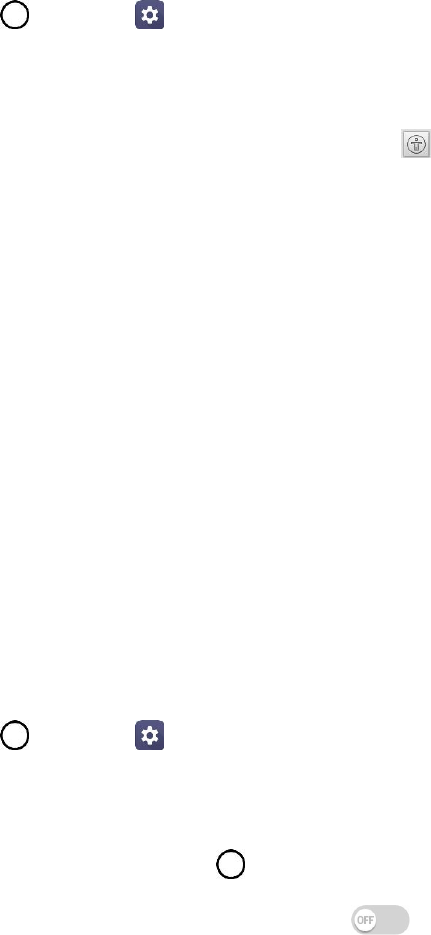
General Settings 156
Captions: Customize caption settings for those with hearing impairments.
Flash alerts: The flash will blink for incoming calls and notifications.
Mute all sounds: Activate to turn off all sounds.
Audio channel: Tap to change the sound to Mono or Stereo.
Sound balance: To manually adjust the sound direction.
Motor & Cognition
The Motor & cognition setting allows you to configure physical and motor options.
1. Tap > Settings > General tab > Accessibility > Motor & cognition.
2. Set your preferred options.
Touch assistant: Provide a touch board with easy use for general buttons or gestures to
access in short. Tap the Touch assistant icon to access the Power Key, Home Button,
Volume Down keys, Volume Up key, and the Next button (Screen capture, Accessibility,
Pinch).
Touch input: Enter text by touching and holding the screen or modify it by simply touching
the screen.
Physical keyboard: Customize the keyboard settings.
Auto mouse click: Automatically click the mouse pointer where it stops.
Touch and hold for calls: Answer or decline calls by touching and holding the call button
instead of dragging it.
Screen timeout: Turn off the screen automatically when the device is left idle for a specified
period of time.
Touch control areas: Limit the touch area so that only a particular portion of the screen can
be controlled by touch input.
General
The General settings allows you to configure general system options.
1. Tap > Settings > General tab > Accessibility.
2. Set your preferred options.
Accessibility features shortcut: Sets quick, easy access to selected features when you
triple-tap the Home Key .
Persistent notification: Tap the switch to turn it on. Alerts sound repeatedly when
there are unread notifications for certain apps.

General Settings 157
Auto-rotate screen: Tap to allow the device to rotate the screen depending on the device
orientation (portrait or landscape).
Services
The Services setting allows you to configure the service option.
1. Tap > Settings > General tab > Accessibility.
2. Tap Switch Access to control your device using configurable key combinations.
3. Tap Lookout and turn the switch on to activate it.
Lookout provides malware scanning, safe browsing, privacy advisor, missing device locator,
and data backup.
Shortcut Keys
Shortcut keys provide quick access to apps using the Volume keys. If you want to disable a shortcut key
feature, tap the switch to turn on/off.
You can quickly open Capture+ or Camera by pressing the Volume keys twice when the screen is off or
locked.
1. Tap > Settings > General tab > Shortcut keys.
2. Tap the switch to enable/disable the feature.
Capture+: Press the Volume Up key twice.
Camera: Press the Volume Down key twice.
Google Services
Use Google Services to manage your Google apps and account settings.
■ Tap > Settings > General tab > Google services.
Fingerprints & Security
Use the Fingerprints & security settings to help secure your phone and its data.
■ Tap > Settings > General tab > Fingerprints & security.
Fingerprints
Use your fingerprint to unlock the screen or content.
Content Lock
Select lock types to lock files in the QuickMemo+ app.

General Settings 158
Encrypt SD Card
Encrypt SD card storage and keep data unavailable for other devices.
Secure Start-up
When you power on your device, you will be required to enter your screen lock.
Make Passwords Visible
Enable to briefly show each character of passwords as you enter them so that you can see what you
enter.
Phone Administrators
Allows you to view or deactivate device administrators.
Unknown Sources
Allows installation of non-Play Store applications.
Credential Protection
Displays the storage type for credentials.
Certificate Management
Allows you to manage the certificate.
Trust Agents
View or deactivate Trust agents.
Screen Pin
This feature allows you to lock your device so that the current user can only access the pinned app. This
is useful for users with children.
Usage Access
Allows you to set access to App usage.
Smart Settings
You can automatically change your device settings according to the usage pattern and location.
Note: To use Smart settings, make sure to set the residential address. See Location for details.
1. Tap > Settings > General tab > Smart settings.
2. Tap each situation you want to activate and set as desired.

General Settings 159
Date & Time
Set your preferences for how the date and time is displayed. You can also select a time zone.
■ Tap > Settings > General tab > Date & time.
Storage
The Storage menu lets you monitor the used and available internal memory and SD card (if available).
You can also mount/unmount the SD card and erase its contents.
■ Tap > Settings > General tab > Storage.
Battery & Power Saving
The Battery menu lets you show any battery information and configure options.
1. Tap > Settings > General tab.
2. Tap Battery & power saving.
Tap Battery usage to display the apps that use the most battery power.
Tap Battery percentage on status bar to display the battery percentage indicator on the
status bar.
Tap Battery saver to set the Battery saver feature on or off and select which functions are
changed when the feature is activated.
Tap Game battery saver to adjust the video quality to reduce the battery consumption when
playing games.
Memory
You can monitor the memory used on average and the memory used by apps in the device.
■ Tap > Settings > General tab > Memory.
Smart Cleaning
You can clean up temporary files or apps that are no longer used to free up storage space.
1. Tap > Settings > General tab > Smart cleaning.
2. Select a category, then select an item to delete.
3. Tap DELETE to delete the selected item.

General Settings 160
System Updates
From time to time, updates may become available for your phone. You can download and apply updates
through the Settings menu.
■Tap > Settings > General tab > System updates.
Apps
The Apps settings menu lets you view details about the applications installed on your phone, manage
their data, force them to stop, and set whether you want to permit installation of applications that you
obtain from websites and email.
To view details about your applications:
1. Tap > Settings > General tab > Apps.
2. Tap the desired app to view its information.
To force applications to stop:
1. Tap > Settings > General tab > Apps.
2. Find the application to force stop and tap the application.
3. Tap Force stop.
4. Read the disclaimer and tap OK.
To uninstall a downloaded application:
1. Tap > Settings > General tab > Apps.
2. Find the application you want to uninstall and tap it.
3. Tap Uninstall.
4. Read the disclaimer and tap OK.
Backup & Reset
The privacy settings on your device allow you to back-up your data, automatically restore data, and erase
all the data on your phone.
■Tap > Settings > General tab > Backup & reset.
General Settings 161
LG Mobile Switch
You can transfer data such as messages, images, and Home screens from an old device to a new device.
See LG Mobile Switch for details.
Backup & Restore
Backs up your data to internal storage or SD card. You can also restore your data from a previous backup.
Back Up My Data
Allows you to back up app data, Wi-Fi passwords, and other settings to Google servers.
Backup Account
Allows you to choose an account to back up data.
Automatic Restore
When reinstalling an app, enabling this option restores backed up settings and data.
Network Settings Reset
Reset all network settings.
Factory Data Reset
Reset your device to factory defaults, erasing all data from your device.
This action permanently erases ALL data from the device, including Google or other account settings,
system and application data and settings, downloaded applications, as well as your music, photos, videos,
and other files. Any data found on an external SD card is not affected.
Note: When you sign in to a Google Account on your device, Factory Reset Protection is automatically
activated. This protects your device in the event it is lost or stolen. For more information, see Factory
Reset Protection.
If you reset your device to factory default settings with the Factory Reset Protection (FRP) feature turned
on, you must enter the user name and password for a registered Google Account used on this device to
regain access to the device. You will not be able to access the device without the correct credentials.
Warning: If you reset your Google Account password, you must wait 24 hours after changing your
password to perform a factory data reset on your device.
Before resetting your device:
1. Verify that the information you want to keep has transferred to your storage area.
2. Log in to your Google Account and confirm your user name and password.
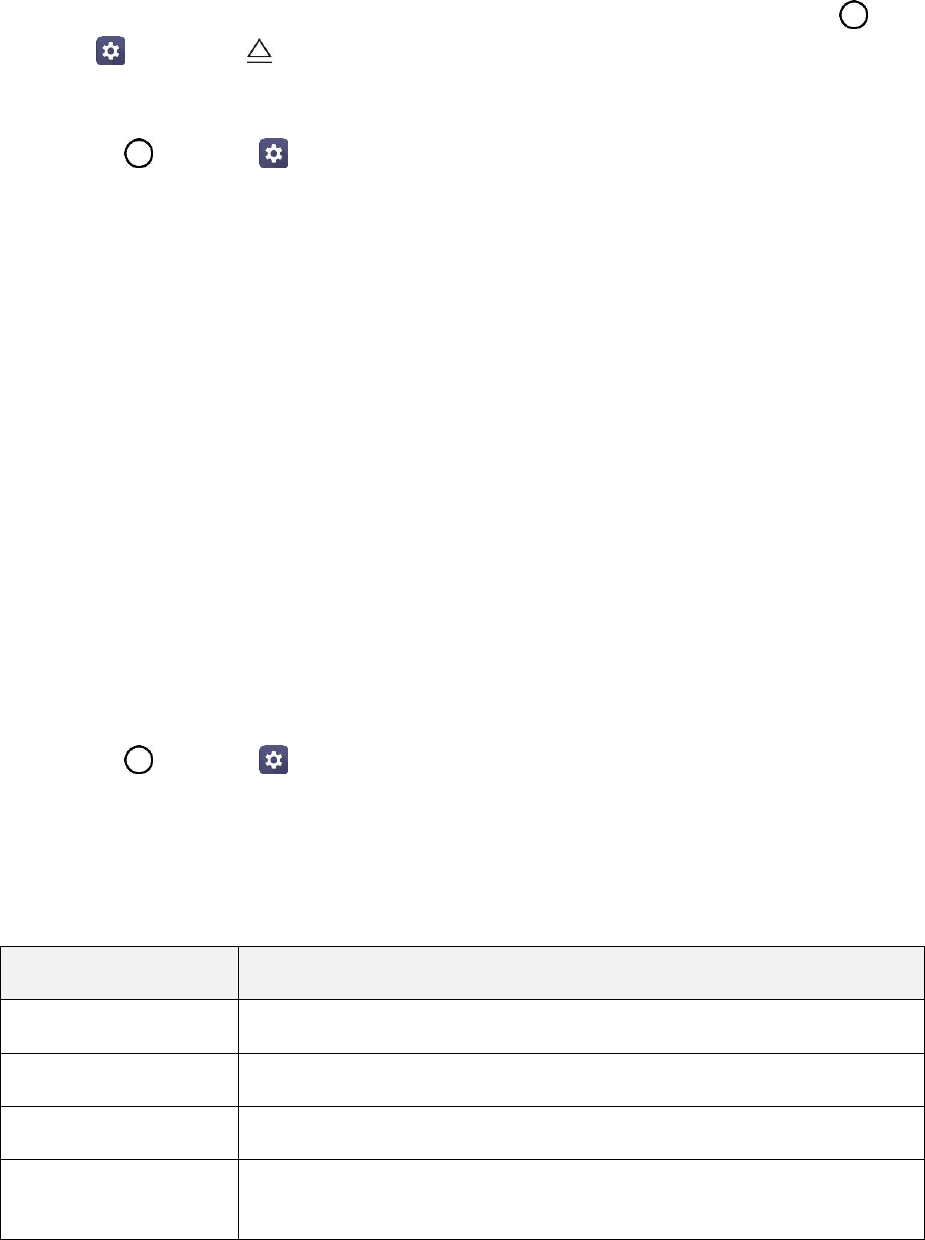
General Settings 162
Tip: Before performing a factory data reset on your phone, you may want to unmount an installed SD
memory card to avoid losing any data you may have stored on it. From the Home screen, tap >
Settings > Storage > to unmount the SD card.
To reset your device:
1. Tap > Settings > General tab.
2. Tap Backup and reset.
The Backup and reset menu opens.
3. Tap Factory data reset.
4. Read the factory data reset information page and tap RESET PHONE.
5. Follow the prompts to perform the reset.
Your phone will power down and reset itself, which may take up to 10 minutes.
6. When the phone restarts, follow the prompts to complete setup. See Complete the Setup Screens
to start over.
Note: Unless you removed all Google Accounts from the phone before performing the Factory data reset,
you will need to sign in to the Google Account that was previously assigned to the phone to complete
setup.
About Phone
The About Phone menu displays information such as the network, battery, hardware, and software.
1. Tap > Settings > General tab > About phone.
2. Tap the desired menu.
About Phone Overview
The following About Phone items may be reviewed or set:
About Phone Item
Description
Phone name
Change the name of your device.
Update center
Check updates for apps provided by LG Electronics.
Network
Check network information such as the signal power, IP address and etc.
Status
Check your phone's status such as your phone number, MEID/IMEI and
etc.

General Settings 163
Battery
Check your battery status, level and usage.
Hardware info
Check your hardware information such as the model number, hardware
version and etc.
Software info
Check your software information such as the Android version, software
version and etc.
Legal info
Review various types of important legal information for LG software, open
source licenses, Google and etc.
Patent information
Check patent information for this model.

164
Getting Help
The following set of topics will cover phone specifications and how to contact Sprint and manage your
wireless service.

For Assistance 165
For Assistance
The following topics address areas of support for your phone, including troubleshooting, account
information, and customer service contact information.
Troubleshooting
Check the questions and answers below for troubleshooting solutions for common phone issues.
Check Here First
Issue: Phone freezes/operation is unstable.
Answer: Turn the phone on again. If you are unable to turn the phone off, reboot your phone. Simply
press and hold the Volume Down and Power keys for about 10 seconds. Data that was being edited
is erased after your phone is powered on again.
Issue: Operation is unstable after a new application was installed.
Answer: The newly installed application may be the cause. Uninstall the application in Safe mode.
See Uninstall an App. To turn the phone on in Safe mode:
Press and hold the Power/Lock key > touch and hold Power off, read the disclaimer for safe
mode, and then tap TURN ON.
• After turning the phone on in Safe mode, "Safe Mode" appears at lower left.
• After restarting in Safe mode, your phone can be powered on as usual.
• Before turning the phone on in Safe mode, it is recommended that you back up important
data.
• By powering the phone on in Safe mode, added widgets may be deleted.
Issue: Cannot use phone, mail, or Internet.
Answer 1: Check whether you are where signal is weak or out of service area.
Answer 2: Power the phone on again.
Answer 3: Is the phone in Airplane mode? To check that Airplane mode is canceled:
1. Tap > Settings > Networks tab.
2. Tap Airplane mode switch to turn the function off.
Answer 4: Is data communication disabled? To check that data communication is enabled:
1. Tap > Settings > Networks tab > Mobile data.
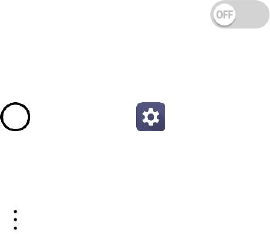
For Assistance 166
2. Tap the Mobile data switch to turn it on.
Answer 5: Is a disabled access point set? To reset to initial settings:
1. Tap > Settings > Networks tab > More.
2. Tap Mobile networks > Access Point Names.
3. Tap > Reset to default.
Issue: Battery level goes down quickly.
Answer: Are you where signal is weak or have been out of service area for a long period? Calling
where signal is weak or being out of service area uses a lot of battery.
Issue: Cannot install applications.
Answer: Applications cannot be installed with only a little free space on the phone or SD card. To
check free space, see Storage. Applications not supported by your phone cannot be installed.
Issue: Cannot unlock screen.
Answer: Power the phone on again. If you are unable to turn the phone off, reboot your phone.
Simply press and hold the Volume Down and Power keys for about 10 seconds. Data that was being
edited is erased after the phone is powered on again.
Sprint Account Information and Help
Find out about account passwords and information about managing your account and finding help.
Sprint Account Passwords
You will need to create passwords to protect access to your personal account information, your voicemail
account, and your data services account. As a Sprint customer, you enjoy unlimited access to all your
information.
Account User Name and Password
If you are the account owner, you will create an account user name and password when you sign on to
sprint.com/mysprint. (Click Register and follow the prompts to get started.) If you are not the account
owner (if someone else receives the bill for your Sprint service), you can get a sub-account password at
sprint.com/mysprint.
Voicemail Passcode
You’ll create your voicemail passcode when you set up your voicemail. See Voicemail Setup for more
information on your voicemail passcode.
Data Services Password
With your Sprint phone, you may elect to set up an optional data services password to control access and
authorize purchases.
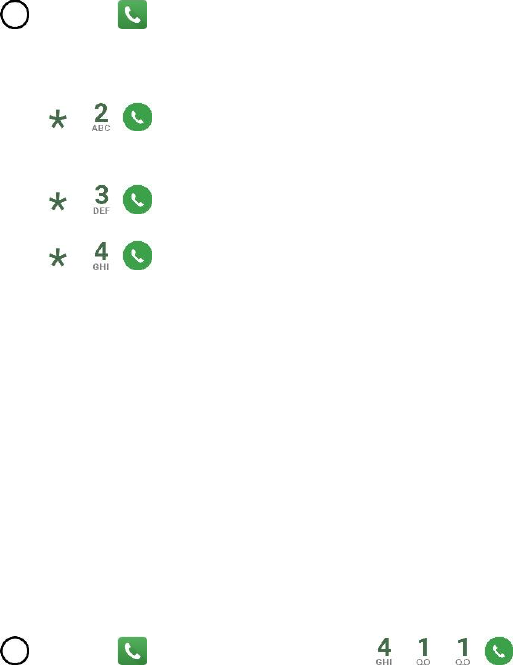
For Assistance 167
For more information, or to change your passwords, sign on to sprint.com/mysprint.
Manage Your Account
Manage your Sprint account from your computer, your Sprint phone, or any other phone.
Online: sprint.com/mysprint
●Access your account information.
●Check your minutes used (depending on your Sprint service plan).
●View and pay your bill.
●Enroll in Sprint online billing and automatic payment.
●Purchase accessories.
●Shop for the latest Sprint phones.
●View available Sprint service plans and options.
●Learn more about data services and other Sprint products.
From Your Sprint Phone
1. Tap > Phone > Dial tab.
2. Do any of the following:
Tap to access a summary of your Sprint service plan or get answers to other
questions.
Tap to access the “Pay My Bill” section of Sprint Zone to make a payment.
Tap to check minute usage and account balance.
Sprint Support Services
Sprint 411 and Sprint Operator Services let you easily access information and calling assistance from
your Sprint phone.
Sprint 411
Sprint 411 gives you access to a variety of services and information, including residential, business, and
government listings; movie listings or showtimes; driving directions, restaurant reservations, and major
local event information. You can get up to three pieces of information per call, and the operator can
automatically connect your call at no additional charge.
There is a per-call charge to use Sprint 411, and you will be billed for airtime.
■Tap > Phone > Dial tab, and then tap .

For Assistance 168
Sprint Operator Services
Sprint Operator Services provides assistance when you place collect calls or when you place calls billed
to a local telephone calling card or third party.
■Tap > Phone > Dial tab, and then tap .
For more information or to see the latest in products and services, visit us online at sprint.com/mysprint.
Anti-Theft Guide
You can set up your device to prevent other people from using it if it’s been reset to factory settings
without your permission. For example, if your device is lost, stolen, or wiped, only someone with your
Google Account or screen lock information can use the device.
All you need to make sure your device is protected is:
●Set a screen lock: If your device is lost or stolen but you have a screen lock set, the device can’t
be erased using the Settings menu unless your screen is unlocked.
●Add your Google Account on your device: If your device is wiped but you have your Google
Account on it, the device can’t finish the setup process until your Google Account information is
entered again.
After your device is protected, you’ll need to either unlock your screen or enter your Google Account
password if you need to do a factory reset. This ensures that you or someone you trust is doing the reset.
Note: Do not forget your Google Account and password you had added to your device prior to performing
a factory reset. If you can’t provide the account information during the setup process, you won’t be able to
use the device at all after performing the factory reset.

For Assistance 169
Copyright Information
© 2017 Sprint. Sprint and the logo are trademarks of Sprint. Other marks are trademarks of their
respective owners.
LG and the LG logo are registered trademarks of LG Corp. LG SP320 is a trademark of LG Corp. Wi-Fi®
and the Wi-Fi logo are registered trademarks of the Wi-Fi Alliance. Bluetooth® is a registered trademark of
Bluetooth SIG, Inc. worldwide. Google is a trademark of Google Inc. microSD™ is a trademark of
SanDisk. Other trademarks and trade names are those of their respective owners. Unless otherwise
specified herein, all accessories referenced herein are sold separately. All features, functionality, and
other product specifications are subject to change. Screen shots are simulated and subject to change.
Note: Open Source Software
To obtain the source code under GPL, LGPL, MPL, and other open source licenses, that is contained in
this product, please visit http://opensource.lge.com. In addition to the source code, all referred license
terms, warranty disclaimers and copyright notices are available for download. LG Electronics will also
provide open source code to you on CD-ROM for a charge covering the cost of performing such
distribution (such as the cost of media, shipping, and handling) upon email request to
opensource@lge.com. This offer is valid for three (3) years from the date on which you purchased the
product.

For Assistance 145
Important Information for the LG-SP320
Safety Information
Important Information
This user guide contains important information on the use and operation of this phone. Please read all the
information carefully for optimal performance and to prevent any damage to or misuse of the phone. Any
changes or modifications not expressly approved in this user guide could void your warranty for this
equipment. Any changes or modifications not expressly approved by the manufacturer could void the
user’s authority to operate the equipment.
Before You Start
WARNING! This product contains chemicals known to the State of California to cause cancer and birth
defects or reproductive harm. Wash hands after handling.
HAC statement
This phone has been tested and rated for use with hearing aids for some of the wireless technologies that
it uses. However, there may be some newer wireless technologies used in this phone that have not been
tested yet for use with hearing aids. It is important to try the different features of this phone thoroughly
and in different locations, using your hearing aid or cochlear implant, to determine if you hear any
interfering noise. Consult your service provider or the manufacturer of this phone for information on
hearing aid compatibility. If you have questions about return or exchange policies, consult your service
provider or phone retailer.
This mobile phone has a Hearing Aid Mode that, when activated, may reduce interference with some
hearing aid models.
FCC RF Exposure Information
WARNING! Read this information before operating the phone.
In August 1996, the Federal Communications Commission (FCC) of the United States, with its action in
Report and Order FCC 96-326, adopted an updated safety standard for human exposure to Radio
Frequency (RF) electromagnetic energy emitted by FCC regulated transmitters. Those guidelines are
consistent with the safety standard previously set by both U.S. and international standards bodies. The
design of this phone complies with the FCC guidelines and these international standards.
Body-worn Operation
This device was tested for typical use with the back of the phone kept 0.39 inches (1.0 cm) from the body.
To comply with FCC RF exposure requirements, a minimum separation distance of 0.39 inches (1.0 cm)
must be maintained between the user’s body and the back of the phone. Any belt-clips, holsters, and
similar accessories containing metallic components may not be used. Avoid the use of accessories that
cannot maintain 0.39 inches (1.0 cm) distance between the user’s body and the back of the phone and
have not been tested for compliance with FCC RF exposure limits.
For Assistance 146
Consumer Information About Radio Frequency Emissions
Your wireless phone, which contains a radio transmitter and receiver, emits radio frequency
energy during use. The following consumer information addresses commonly asked questions
about the health effects of wireless phones.
Are wireless phones safe?
Scientific research on the subject of wireless phones and radio frequency (“RF”) energy has been
conducted worldwide for many years, and continues. In the United States, the Food and Drug
Administration (“FDA”) and the Federal Communications Commission (“FCC”) set policies and
procedures for wireless phones. The FDA issued a website publication on health issues related to cell
phone usage where it states, “The scientific community at large… believes that the weight of scientific
evidence does not show an association between exposure to radiofrequency (RF) from cell phones and
adverse health outcomes. Still the scientific community does recommend conducting additional research
to address gaps in knowledge. That research is being conducted around the world and FDA continues to
monitor developments in this field. You can access the joint FDA/FCC website at http://www.fda.gov
(under “c”in the subject index, select Cell Phones > Research). You can also contact the FDA toll-free at
(888) 463-6332 or (888) INFO-FDA. In June 2000, the FDA entered into a cooperative research and
development agreement through which additional scientific research is being conducted. The FCC issued
its own website publication stating that “there is no scientific evidence that proves that wireless phone
usage can lead to cancer or a variety of other problems, including headaches, dizziness or memory loss.”
This publication is available at http://www.fcc.gov/cgb/ cellular.html or through the FCC at (888) 225-5322
or (888) CALLFCC.
What does “SAR” mean?
In 1996, the FCC, working with the FDA, the U.S. Environmental Protection Agency, and other agencies,
established RF exposure safety guidelines for wireless phones in the United States. Before a wireless
phone model is available for sale to the public, it must be tested by the manufacturer and certified to the
FCC that it does not exceed limits established by the FCC. One of these limits is expressed as a Specific
Absorption Rate, or “SAR.” SAR is a measure of the rate of absorption of RF energy in the body. Tests for
SAR are conducted with the phone transmitting at its highest power level in all tested frequency bands.
Since 1996, the FCC has required that the SAR of handheld wireless phones not exceed 1.6 watts per
kilogram, averaged over one gram of tissue. Although the SAR is determined at the highest power level,
the actual SAR value of a wireless phone while operating can be less than the reported SAR value. This
is because the SAR value may vary from call to call, depending on factors such as proximity to a cell site,
the proximity of the phone to the body while in use, and the use of hands-free devices.
Can I minimize my RF exposure?
If you are concerned about RF, there are several simple steps you can take to minimize your RF
exposure. You can, of course, reduce your talk time. You can place more distance between your body
and the source of the RF, as the exposure level drops off dramatically with distance. The FDA/FCC
For Assistance 147
website states that “hands-free kits can be used with wireless phones for convenience and comfort.
These systems reduce the absorption of RF energy in the head because the phone, which is the source
of the RF emissions, will not be placed against the head. On the other hand, if the phone is mounted
against the waist or other part of the body during use, then that part of the body will absorb more RF
energy. Wireless phones marketed in the U.S. are required to meet safety requirements regardless of
whether they are used against the head or against the body. Either configuration should result in
compliance with the safety limit.” Also, if you use your wireless phone while in a car, you can use a phone
with an antenna on the outside of the vehicle. You should also read and follow your wireless phone
manufacturer’s instructions for the safe operation of your phone.
Do wireless phones pose any special risks to children?
The FDA/FCC website states that “the scientific evidence does not show a danger to users of wireless
communication devices, including children.” The FDA/FCC website further states that “some groups
sponsored by other national governments have advised that children be discouraged from using wireless
phones at all”. For example, the Stewart Report from the United Kingdom [“UK”] made such a
recommendation in December 2000. In this report a group of independent experts noted that no evidence
exists that using a cell phone causes brain tumors or other ill effects. [The UK’s] recommendation to limit
cell phone use by children was strictly precautionary; it was not based on scientific evidence that any
health hazard exists. A copy of the UK’s leaflet is available at http://www.dh.gov.uk (search “mobile”), or
you can write to: NRPB, Chilton, Didcot, Oxon OX11 ORQ, United Kingdom. Copies of the UK’s annual
reports on mobile phones and RF are available online at www.iegmp.org.uk and
http://www.hpa.org.uk/radiation/ (search “mobile”). Parents who wish to reduce their children’s RF
exposure may choose to restrict their children’s wireless phone use.
Where can I get further information about RF emissions?
For further information, see the following additional resources (websites current as of April 2005):
U.S. Food and Drug Administration
FDA Consumer magazine November-December 2000
Telephone: (888) INFO-FDA
http://www.fda.gov (Under “c” in the subject index, select Cell Phones > Research.)
U.S. Federal Communications Commission
445 12th Street, S.W. Washington, D.C.20554
Telephone: (888) 225-5322
http://www.fcc.gov/oet/rfsafety
For Assistance 148
Independent Expert Group on Mobile Phones
http://www.iegmp.org.uk
Royal Society of Canada Expert Panels on Potential Health Risks of Radio Frequency Fields from
Wireless Telecommunication Devices
283 Sparks Street Ottawa, Ontario K1R 7X9
Canada
Telephone: (613) 991-6990
http://www.rsc.ca/index.php?page=Expert_Panels_RF&Lang_id=120
World Health Organization
Avenue Appia 20 1211 Geneva 27 Switzerland
Telephone: 011 41 22 791 21 11
http://www.who.int/mediacentre/factsheets/fs193/en/
International Commission on Non-Ionizing Radiation Protection
c/o Bundesamt fur Strahlenschutz
Ingolstaedter Landstr. 1
85764 Oberschleissheim Germany
Telephone: 011 49 1888 333 2156
http://www.icnirp.de
American National Standards Institute
1819 L Street, N.W., 6th Floor Washington, D.C. 20036
Telephone: (202) 293-8020
http://www.ansi.org
National Council on Radiation Protection and Measurements
7910 Woodmont Avenue, Suite 800
Bethesda, MD 20814-3095
Telephone: (301) 657-2652
http://www.ncrponline.org
Engineering in Medicine and Biology Society, Committee on Man and Radiation (COMAR) of the
Institute of Electrical and Electronics Engineers
http://ewh.ieee.org/soc/embs/comar/
Consumer Information on SAR
(Specific Absorption Rate)
This model phone meets the government’s requirements for exposure to radio waves. Your wireless
phone is a radio transmitter and receiver. It is designed and manufactured not to exceed the emission
limits for exposure to Radio Frequency (RF) energy set by the Federal Communications Commission of
the U.S. Government. These limits are part of comprehensive guidelines and establish permitted levels of
RF energy for the general population. The guidelines are based on standards that were developed by
For Assistance 149
independent scientific organizations through periodic and thorough evaluation of scientific studies. The
standards include a substantial safety margin designed to assure the safety of all persons, regardless of
age and health.
The exposure standard for wireless mobile phones employs a unit of measurement known as the Specific
Absorption Rate, or SAR. The SAR limit set by the FCC is 1.6 W/kg. Tests for SAR are conducted using
standard operating positions specified by the FCC with the phone transmitting at its highest certified
power level in all tested frequency bands. Although SAR is determined at the highest certified power level,
the actual SAR level of the phone while operating can be well below the maximum value. Because the
phone is designed to operate at multiple power levels to use only the power required to reach the network,
in general, the closer you are to a wireless base station antenna, the lower the power output.
Before a phone model is available for sale to the public, it must be tested and certified to the FCC that it
does not exceed the limit established by the government adopted requirement for safe exposure. The
tests are performed in positions and locations (e.g., at the ear and worn on the body) as required by the
FCC for each model.
While there may be differences between SAR levels of various phones and at various positions, they all
meet the government requirement for safe exposure. The FCC has granted an Equipment Authorization
for this model phone with all reported SAR levels evaluated as in compliance with the FCC RF emission
guidelines. SAR information on this model phone is on file with the FCC and can be found under the
Display Grant section of http://www.fcc.gov/oet/fccid after searching on FCC ID ZNFSP320
Additional information on Specific Absorption Rates (SAR) can be found on the Cellular
Telecommunications Industry Association (CTIA) website at http://www.ctia.org/.
* In the United States and Canada, the SAR limit for mobile phones used by the public is 1.6 watts/kg
(W/kg) averaged over one gram of tissue. The standard incorporates a substantial margin of safety to
give additional protection for the public and to account for any variations in measurements.
FCC Hearing-Aid Compatibility (HAC) Regulations for
Wireless Devices
On July 10, 2003, the U.S. Federal Communications Commission (FCC) Report and Order in WT Docket
01-309 modified the exception of wireless phones under the Hearing Aid Compatibility Act of 1988 (HAC
Act) to require digital wireless phones be compatible with hearing-aids. The intent of the HAC Act is to
ensure reasonable access to telecommunications services for persons with hearing disabilities. While
some wireless phones are used near some hearing devices (hearing aids and cochlear implants), users
may detect a buzzing, humming, or whining noise. Some hearing devices are more immune than others
to this interference noise, and phones also vary in the amount of interference they generate. The wireless
telephone industry has developed a rating system for wireless phones, to assist hearing device users to
find phones that may be compatible with their hearing devices. Not all phones have been rated. Phones
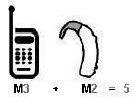
For Assistance 150
that are rated have the rating on their box or a label located on the box. The ratings are not guarantees.
Results will vary depending on the user’s hearing device and hearing loss. If your hearing device happens
to be vulnerable to interference, you may not be able to use a rated phone successfully. Trying out the
phone with your hearing device is the best way to evaluate it for your personal needs.
M-Ratings: Phones rated M3 or M4 meet FCC requirements and are likely to generate less interference
to hearing devices than phones that are not labeled. M4 is the better/higher of the two ratings.
T-Ratings: Phones rated T3 or T4 meet FCC requirements and are likely to generate less interference to
hearing devices than phones that are not labeled. T4 is the better/ higher of the two ratings.
Hearing devices may also be rated. Your hearing device manufacturer or hearing health professional may
help you find this rating. Higher ratings mean that the hearing device is relatively immune to interference
noise. The hearing aid and wireless phone rating values are then added together. A sum of 5 is
considered acceptable for normal use. A sum of 6 is considered for best use.
In the above example, if a hearing aid meets the M2 level rating and the wireless phone meets the M3
level rating, the sum of the two values equal M5. This should provide the hearing aid user with “normal
usage” while using their hearing aid with the particular wireless phone. “Normal usage” in this context is
defined as a signal quality that’s acceptable for normal operation. The M mark is intended to be
synonymous with the U mark. The T mark is intended to be synonymous with the UT mark. The M and T
marks are recommended by the Alliance for Telecommunications Industries Solutions (ATIS). The U and
UT marks are referenced in Section 20.19 of the FCC Rules. The HAC rating and measurement
procedure are described in the American National Standards Institute (ANSI) C63.19 standard. To ensure
that the Hearing Aid Compatibility rating for your phone is maintained, secondary transmitters such as
Bluetooth® and WLAN components must be disabled during a call.
For information about hearing aids and digital wireless phones
Wireless Phones and Hearing Aid Accessibility
http://www.accesswireless.org/
Gallaudet University, RERC
http://tap.gallaudet.edu/Voice/
FCC Hearing Aid Compatibility and Volume Control
http://www.fcc.gov/cgb/dro/hearing.html
The Hearing Aid Compatibility FCC Order
http://hraunfoss.fcc.gov/edocs_public/attachmatch/FCC-03-168A1.pdf
Hearing Loss Association of America [HLAA]
http://hearingloss.org/content/telephones-and-mobiledevices
For Assistance 151
Caution: Avoid potential hearing loss.
Prolonged exposure to loud sounds (including music) is the most common cause of preventable hearing
loss. Some scientific research suggests that using portable audio devices, such as portable music players
and cellular telephones, at high volume settings for long durations may lead to permanent noiseinduced
hearing loss. This includes the use of headphones (including headsets, earbuds and Bluetooth or other
wireless devices).
Exposure to very loud sound has also been associated in some studies with tinnitus (a ringing in the ear),
hypersensitivity to sound and distorted hearing. Individual susceptibility to noise-induced hearing loss and
other potential hearing problems varies. The amount of sound produced by a portable audio device varies
depending on the nature of the sound, the device, the device settings and the headphones. You should
follow some commonsense recommendations when using any portable audio device:
● Set the volume in a quiet environment and select the lowest volume at which you can hear
adequately.
● When using headphones, turn the volume down if you cannot hear the people speaking near you
or if the person sitting next to you can hear what you are listening to.
● Do not turn the volume up to block out noisy surroundings. If you choose to listen to your portable
device in a noisy environment, use noise-cancelling headphones to block out background
environmental noise.
● Limit the amount of time you listen. As the volume increases, less time is required before your
hearing could be affected.
● Avoid using headphones after exposure to extremely loud noises, such as rock concerts, that
might cause temporary hearing loss. Temporary hearing loss might cause unsafe volumes to
sound normal.
● Do not listen at any volume that causes you discomfort. If you experience ringing in your ears,
hear muffled speech or experience any temporary hearing difficulty after listening to your portable
audio device, discontinue use and consult your doctor.
TIA Safety Information
The following is the complete TIA Safety Information for wireless handheld phones.
Exposure to Radio Frequency Signal
Your wireless handheld portable phone is a low power radio transmitter and receiver. When ON, it
receives and sends out Radio Frequency (RF) signals.
In August, 1996, the Federal Communications Commissions (FCC) adopted RF exposure guidelines with
safety levels for handheld wireless phones. Those guidelines are consistent with the safety standards
previously set by both U.S. and international standards bodies:
ANSI C95.1 (1992) *
NCRP Report 86 (1986)
ICNIRP (1996)
For Assistance 152
* American National Standards Institute; National Council on Radiation Protection and Measurements;
International Commission on Non-Ionizing Radiation Protection.
Those standards were based on comprehensive and periodic evaluations of the relevant scientific
literature. For example, over 120 scientists, engineers, and physicians from universities, government
health agencies, and industry reviewed the available body of research to develop the ANSI Standard
(C95.1).
Tips on Efficient Operation
For your phone to operate most efficiently: Don’t touch the antenna unnecessarily when the phone is in
use. Contact with the antenna affects call quality and may cause the phone to operate at a higher power
level than otherwise needed.
Electronic Devices
Most modern electronic equipment is shielded from RF signals. However, certain electronic equipment
may not be shielded against the RF signals from your wireless phone.
Pacemakers
The Health Industry Manufacturers Association recommends that a minimum separation of six (6) inches
be maintained between a handheld wireless phone and a pacemaker to avoid potential interference with
the pacemaker. These recommendations are consistent with the independent research by and
recommendations of Wireless Technology Research.
Persons with pacemakers:
● Should ALWAYS keep the phone more than six (6) inches from their pacemaker when the phone
is turned ON;
● Should not carry the phone in a breast pocket;
● Should use the ear opposite the pacemaker to minimize the potential for interference;
● Should turn the phone OFF immediately if there is any reason to suspect that interference is
taking place.
Hearing Aids
Some digital wireless phones may interfere with some hearing aids. In the event of such interference, you
may want to consult your service provider (or call the customer service line to discuss alternatives).
Other Medical Devices
If you use any other personal medical device, consult the manufacturer of your device to determine if it is
adequately shielded from external RF energy. Your physician may be able to assist you in obtaining this
information.
For Assistance 153
Health Care Facilities
Turn your phone OFF in health care facilities when any regulations posted in these areas instruct you to
do so. Hospitals or health care facilities may use equipment that could be sensitive to external RF energy.
Vehicles
RF signals may affect improperly installed or inadequately shielded electronic systems in motor vehicles.
Check with the manufacturer or its representative regarding your vehicle. You should also consult the
manufacturer of any equipment that has been added to your vehicle.
Posted Facilities
Turn your phone OFF in any facility where posted notices so require.
Aircraft
FCC regulations prohibit using your phone while in the air. Switch OFF your phone before boarding an
aircraft.
Blasting Areas
To avoid interfering with blasting operations, turn your phone OFF when in a “blasting area” or in areas
posted: “Turn off two-way radio”. Obey all signs and instructions.
Potentially Explosive Atmosphere
Turn your phone OFF when in any area with a potentially explosive atmosphere and obey all signs and
instructions. Sparks in such areas could cause an explosion or fire resulting in bodily injury or even death.
Areas with a potentially explosive atmosphere are often, but not always marked clearly. Potential areas
may include: fueling areas (such as gasoline stations); below deck on boats; fuel or chemical transfer or
storage facilities; vehicles using liquefied petroleum gas (such as propane or butane); areas where the air
contains chemicals or particles (such as grain, dust, or metal powders); and any other area where you
would normally be advised to turn off your vehicle engine.
For Vehicles Equipped with an Air Bag
An air bag inflates with great force. DO NOT place objects, including either installed or portable wireless
equipment, in the area over the air bag or in the air bag deployment area. If in-vehicle wireless equipment
is improperly installed and the air bag inflates, serious injury could result.
Part 15.19 statement
This device complies with part 15 of the FCC rules. Operation is subject to the following two conditions: (1)
This device may not cause harmful interference, and (2) This device must accept any interference
received, including interference that may cause undesired operation.
Part 15.21 statement
Changes or modifications that are not expressly approved by the manufacturer for compliance could void
the user’s authority to operate the equipment.
For Assistance 154
Part 15.105 statement
This equipment has been tested and found to comply with the limits for a class B digital device, pursuant
to Part 15 of the FCC rules. These limits are designed to provide reasonable protection against harmful
interference in a residential installation. This equipment generates, uses, and can radiate radio frequency
energy and, if not installed and used in accordance with the instructions, may cause harmful interference
to radio communications. However, there is no guarantee that interference will not occur in a particular
installation. If this equipment does cause harmful interference to radio or television reception, which can
be determined by turning the equipment off and on, the user is encouraged to try to correct the
interference by one or more of the following measures:
● Reorient or relocate the receiving antenna.
● Increase the separation between the equipment and receiver.
● Connect the equipment into an outlet on a circuit different from that to which the receiver is
connected.
● Consult the dealer or an experienced radio/TV technician for help.
Safety Information
Please read and observe the following information for safe and proper use of your phone and to prevent
damage.
CAUTION! Violation of the instructions may cause minor or serious damage to the product.
● Do not disassemble or open crush, bend or deform, puncture or shred.
● Do not modify or remanufacture, attempt to insert foreign objects into the battery, immerse or
expose to water or other liquids, expose to fire, explosion or other hazard. Such conditions may
present the risk of fire or explosion.
● Only use the battery for the system for which it is specified.
● Only use the battery with a charging system that has been LG-approved and qualified with the
system per IEEE-Std-1725. Use of an unqualified and non-LG-approved battery or charger may
present a risk of fire, explosion, leakage, or other hazard.
● Do not short circuit a battery or allow metallic conductive objects to contact battery terminals.
● Replace the battery only with another battery that has been LGapproved and qualified with the
system per this standard, IEEE-Std-1725. Use of an unqualified and non-LG-approved battery
may present a risk of fire, explosion, leakage or other hazard. Only authorized service providers
shall replace battery. (If the battery is non-user replaceable.)
● Promptly dispose of used batteries in accordance with local regulations.
● Battery usage by children should be supervised.
● Avoid dropping the phone or battery. If the phone or battery is dropped, especially on a hard
surface, and the user suspects damage, take it to a service center for inspection.
For Assistance 155
● Improper battery use may result in a fire, explosion or other hazard.
● At least, one of the Authentication methods may be implemented. (e.g. H/W, S/W, Mechanical,
Hologram, etc.)
Charger and Adapter Safety
● The charger and adapter are intended for indoor use only.
● Insert the battery charger vertically into the wall power socket.
● Only use the LG-approved battery charger. Otherwise, you may cause serious damage to your
phone.
● Use the correct adapter for your phone when using the battery charger abroad.
Battery Information and Care
● Always unplug the charger from the wall socket after the phone is fully charged to save
unnecessary power consumption of the charger.
● Please read the manual of specified charger about charging method.
● Do not damage the power cord by bending, twisting, or heating. Do not use the plug if it is loose
as it may cause electric shock or fire.
● Do not place any heavy items on the power cord. Do not allow the power cord to be crimped as it
may cause electric shock or fire.
● Unplug the power cord prior to cleaning your phone, and clean the power plug pin when it’s dirty.
When using the power plug, ensure that it’s firmly connected. If not, it may cause excessive heat
or fire. If you put your phone in a pocket or bag without covering the receptacle of the phone
(power plug pin), metallic articles (such as a coin, paperclip or pen) may short-circuit the phone.
Always cover the receptacle when not in use.
● Recharge the battery after long periods of non-use to maximize battery life. Battery life will vary
due to usage pattern and environmental conditions.
● Please use only an approved charging accessory to charge your LG phone. Improper handling of
the charging port, as well as the use of an incompatible charger, may cause damage to your
phone and void the warranty.
● Charging temperature range is regulated between 0°C/32°F and 45°C/113°F. Do not charge the
battery out of recommended temperature range. Charging out of recommended range might
cause the generating heat or serious damage of battery. And also, it might cause the
deterioration of battery’s characteristics and cycle life.
● Do not use or leave the battery under the blazing sun or in heated car by sunshine. The battery
may generate heat, smoke or flame. And also, it might cause the deterioration of battery’s
characteristics or cycle life.
For Assistance 156
● The battery pack has protection circuit to avoid the danger. Do not use nearby the place where
generates static electricity more than 100V which gives damage to the protection circuit. If the
protection circuit were broken, the battery would generate smoke, rupture or flame.
● If the skin or cloth is smeared with liquid from the battery, wash with fresh water. It may cause the
skin inflammation.
● Please take your phone to an authorized service center immediately if this occurs.
● Do not handle the phone with wet hands while it is being charged. It may cause an electric shock
or seriously damage your phone.
● Do not place or answer calls while charging the phone as it may short-circuit the phone and/or
cause electric shock or fire.
● The charger and adapter are intended for indoor use only.
● Talking on your phone for a long period of time may reduce call quality due to heat generated
during use.
Explosion, Shock, and Fire Hazards
● Do not put your phone in a place subject to excessive dust and keep the minimum required
distance between the power cord and heat sources.
● Unplug the power cord prior to cleaning your phone, and clean the power plug pin when it’s dirty.
● When using the power plug, ensure that it’s firmly connected. If not, it may cause excessive heat
or fire.
● If you put your phone in a pocket or bag without covering the receptacle of the phone (power plug
pin), metallic articles (such as a coin, paperclip or pen) may shortcircuit the phone and may cause
an explosion. Always cover the receptacle when not in use.
● Don’t short-circuit the battery. Metallic articles such as a coin, paperclip or pen in your pocket or
bag or contact with sharp objects including animal bites may shortcircuit the + and – terminals of
the battery (metal strips on the battery) upon moving. Shortcircuit of the terminal may damage the
battery and cause an explosion.
General Notice
● Do not place items containing magnetic components such as a credit card, phone card, bank
book, or subway ticket near your phone. The magnetism of the phone may damage the data
stored in the magnetic strip.
● Talking on your phone for a long period of time may reduce call quality due to heat generated
during use.
● When the phone is not used for a long period time, store it in a safe place with the power cord
unplugged.

For Assistance 157
● Using the phone in proximity to receiving equipment (i.e., TV or radio) may cause interference to
the phone.
● Do not immerse your phone in water, liquid, or expose to high humidity. Immediately, take it to an
LG Authorized Service Center.
● Do not paint your phone.
● The data saved in your phone might be deleted due to careless use, repair of the phone, or
upgrade of the software. Please backup your important phone numbers. (Ringtones, text
messages, voice messages, pictures, and videos could also be deleted.) The manufacturer is not
liable for damage due to the loss of data.
● When you use the phone in public places, set the ringtone to vibration so you don’t disturb others.
● Do not turn your phone on or off when putting it to your ear.
● Use accessories, such as earphones and headsets, with caution. Ensure that cables are tucked
away safely and do not touch the antenna unnecessarily.
FDA Consumer Update
The U.S. Food and Drug Administration’s Center for Devices and Radiological Health
Consumer Update on Mobile Phones:
1. Do wireless phones pose a health hazard?
The available scientific evidence does not show that any health problems are associated with
using wireless phones. There is no proof, however, that wireless phones are absolutely safe.
Wireless phones emit low levels of Radio Frequency (RF) energy in the microwave range while
being used. They also emit very low levels of RF when in standby mode. Whereas high levels of
RF can produce health effects (by heating tissue), exposure to low level RF that does not
produce heating effects causes no known adverse health effects. Many studies of low level RF
exposures have not found any biological effects. Some studies have suggested that some
biological effects may occur, but such findings have not been confirmed by additional research. In
some cases, other researchers have had difficulty in reproducing those studies, or in determining
the reasons for inconsistent results.
2. What is the FDA’s role concerning the safety of wireless phones?
Under the law, the FDA does not review the safety of radiation-emitting consumer products such
as wireless phones before they can be sold, as it does with new drugs or medical devices.
However, the agency has authority to take action if wireless phones are shown to emit Radio
Frequency (RF) energy at a level that is hazardous to the user. In such a case, the FDA could
require the manufacturers of wireless phones to notify users of the health hazard and to repair,
replace, or recall the phones so that the hazard no longer exists.
Although the existing scientific data do not justify FDA regulatory actions, the FDA has urged the
wireless phone industry to take a number of steps, including the following:
For Assistance 158
Support needed research into possible biological effects of RF of the type emitted by wireless
phones;
Design wireless phones in a way that minimizes any RF exposure to the user that is not
necessary for device function; and
Cooperate in providing users of wireless phones with the best possible information on
possible effects of wireless phone use on human health.
The FDA belongs to an interagency working group of the federal agencies that have responsibility
for different aspects of RF safety to ensure coordinated efforts at the federal level. The following
agencies belong to this working group:
National Institute for Occupational Safety and Health
Environmental Protection Agency
Occupational Safety and Health Administration
National Telecommunications and Information Administration
The National Institutes of Health participates in some interagency working group activities, as well.
The FDA shares regulatory responsibilities for wireless phones with the Federal Communications
Commission (FCC). All phones that are sold in the United States must comply with FCC safety
guidelines that limit RF exposure. The FCC relies on the FDA and other health agencies for
safety questions about wireless phones.
The FCC also regulates the base stations that the wireless phone networks rely upon. While
these base stations operate at higher power than do the wireless phones themselves, the RF
exposures that people get from these base stations are typically thousands of times lower than
those they can get from wireless phones. Base stations are thus not the subject of the safety
questions discussed in this document.
3. What kinds of phones are the subject of this update?
The term “wireless phone”refers here to handheld wireless phones with built-in antennas, often
called “cell”, “mobile”, or “PCS”phones. These types of wireless phones can expose the user to
measurable Radio Frequency (RF) energy because of the short distance between the phone and
the user’s head. These RF exposures are limited by FCC safety guidelines that were developed
with the advice of the FDA and other federal health and safety agencies. When the phone is
located at greater distances from the user, the exposure to RF is drastically lower because a
person’s RF exposure decreases rapidly with increasing distance from the source. The so-called
“cordless phones,”which have a base unit connected to the telephone wiring in a house, typically
operate at far lower power levels, and thus produce RF exposures far below the FCC safety limits.
4. What are the results of the research done already?
The research done thus far has produced conflicting results, and many studies have suffered
from flaws in their research methods. Animal experiments investigating the effects of Radio
Frequency (RF) energy exposures characteristic of wireless phones have yielded conflicting
results that often cannot be repeated in other laboratories. A few animal studies, however, have
For Assistance 159
suggested that low levels of RF could accelerate the development of cancer in laboratory animals.
However, many of the studies that showed increased tumor development used animals that had
been genetically engineered or treated with cancercausing chemicals so as to be pre-disposed to
develop cancer in the absence of RF exposure. Other studies exposed the animals to RF for up
to 22 hours per day. These conditions are not similar to the conditions under which people use
wireless phones, so we do not know with certainty what the results of such studies mean for
human health. Three large epidemiology studies have been published since December 2000.
Between them, the studies investigated any possible association between the use of wireless
phones and primary brain cancer, glioma, meningioma, or acoustic neuroma, tumors of the brain
or salivary gland, leukemia, or other cancers. None of the studies demonstrated the existence of
any harmful health effects from wireless phone RF exposures. However, none of the studies can
answer questions about longterm exposures, since the average period of phone use in these
studies was around three years.
5. What research is needed to decide whether RF exposure from wireless phones poses a
health risk?
A combination of laboratory studies and epidemiological studies of people actually using wireless
phones would provide some of the data that are needed. Lifetime animal exposure studies could
be completed in a few years. However, very large numbers of animals would be needed to
provide reliable proof of a cancer promoting effect if one exists. Epidemiological studies can
provide data that is directly applicable to human populations, but ten or more years follow-up may
be needed to provide answers about some health effects, such as cancer. This is because the
interval between the time of exposure to a cancercausing agent and the time tumors develop — if
they do — may be many, many years. The interpretation of epidemiological studies is hampered
by difficulties in measuring actual RF exposure during day-to-day use of wireless phones. Many
factors affect this measurement, such as the angle at which the phone is held, or which model of
phone is used.
6. What is the FDA doing to find out more about the possible health effects of wireless phone
RF?
The FDA is working with the U.S. National Toxicology Program and with groups of investigators
around the world to ensure that high priority animal studies are conducted to address important
questions about the effects of exposure to Radio Frequency (RF) energy. The FDA has been a
leading participant in the World Health Organization International Electro Magnetic Fields (EMF)
Project since its inception in 1996. An influential result of this work has been the development of a
detailed agenda of research needs that has driven the establishment of new research programs
around the world. The project has also helped develop a series of public information documents
on EMF issues. The FDA and the Cellular Telecommunications & Internet Association (CTIA)
have a formal Cooperative Research And Development Agreement (CRADA) to do research on
wireless phone safety. The FDA provides the scientific oversight, obtaining input from experts in
government, industry, and academic organizations. CTIA-funded research is conducted through
contracts with independent investigators. The initial research will include both laboratory studies
and studies of wireless phone users. The CRADA will also include a broad assessment of
additional research needs in the context of the latest research developments around the world.
For Assistance 160
7. How can I find out how much Radio Frequency energy exposure I can get by using my
wireless phone?
All phones sold in the United States must comply with Federal Communications Commission
(FCC) guidelines that limit Radio Frequency (RF) energy exposures. The FCC established these
guidelines in consultation with the FDA and the other federal health and safety agencies. The
FCC limit for RF exposure from wireless phones is set at a Specific Absorption Rate (SAR) of 1.6
watts per kilogram (1.6 W/kg). The FCC limit is consistent with the safety standards developed by
the Institute of Electrical and Electronic Engineering (IEEE) and the National Council on Radiation
Protection and Measurement. The exposure limit takes into consideration the body’s ability to
remove heat from the tissues that absorb energy from the wireless phone and is set well below
levels known to have effects. Manufacturers of wireless phones must report the RF exposure
level for each model of phone to the FCC. The FCC website (http://www.fcc.gov/oet/rfsafety)
gives directions for locating the FCC identification number on your phone so you can find your
phone’s RF exposure level in the online listing.
8. What has the FDA done to measure the Radio Frequency energy coming from wireless
phones?
The Institute of Electrical and Electronic Engineers (IEEE) is developing a technical standard for
measuring the Radio Frequency (RF) energy exposure from wireless phones and other wireless
handsets with the participation and leadership of FDA scientists and engineers. The standard,
“Recommended Practice for Determining the Spatial-Peak Specific Absorption Rate (SAR) in the
Human Body Due to Wireless Communications Devices: Experimental Techniques”, sets forth the
first consistent test methodology for measuring the rate at which RF is deposited in the heads of
wireless phone users. The test method uses a tissue-simulating model of the human head.
Standardized SAR test methodology is expected to greatly improve the consistency of
measurements made at different laboratories on the same phone. SAR is the measurement of the
amount of energy absorbed in tissue, either by the whole body or a small part of the body. It is
measured in watts/kg (or milliwatts/g) of matter. This measurement is used to determine whether
a wireless phone complies with safety guidelines.
9. What steps can I take to reduce my exposure to Radio Frequency energy from my wireless
phone?
If there is a risk from these products — and at this point we do not know that there is — it is
probably very small. But if you are concerned about avoiding even potential risks, you can take a
few simple steps to minimize your exposure to Radio Frequency (RF) energy. Since time is a key
factor in how much exposure a person receives, reducing the amount of time spent using a
wireless phone will reduce RF exposure. If you must conduct extended conversations by wireless
phone every day, you could place more distance between your body and the source of the RF,
since the exposure level drops off dramatically with distance. For example, you could use a
headset and carry the wireless phone away from your body or use a wireless phone connected to
a remote antenna. Again, the scientific data does not demonstrate that wireless phones are
harmful. But if you are concerned about the RF exposure from these products, you can use
measures like those described above to reduce your RF exposure from wireless phone use.
For Assistance 161
10. What about children using wireless phones?
The scientific evidence does not show a danger to users of wireless phones, including children
and teenagers. If you want to take steps to lower exposure to Radio Frequency (RF) energy, the
measures described above would apply to children and teenagers using wireless phones.
Reducing the time of wireless phone use and increasing the distance between the user and the
RF source will reduce RF exposure. Some groups sponsored by other national governments
have advised that children be discouraged from using wireless phones at all. For example, the
government in the United Kingdom distributed leaflets containing such a recommendation in
December 2000. They noted that no evidence exists that using a wireless phone causes brain
tumors or other ill effects. Their recommendation to limit wireless phone use by children was
strictly precautionary; it was not based on scientific evidence that any health hazard exists.
11. What about wireless phone interference with medical equipment?
Radio Frequency (RF) energy from wireless phones can interact with some electronic devices.
For this reason, the FDA helped develop a detailed test method to measure Electro Magnetic
Interference (EMI) of implanted cardiac pacemakers and defibrillators from wireless telephones.
This test method is now part of a standard sponsored by the Association for the Advancement of
Medical Instrumentation (AAMI). The final draft, a joint effort by the FDA, medical device
manufacturers, and many other groups, was completed in late 2000. This standard will allow
manufacturers to ensure that cardiac pacemakers and defibrillators are safe from wireless phone
EMI. The FDA has tested hearing aids for interference from handheld wireless phones and
helped develop a voluntary standard sponsored by the Institute of Electrical and Electronic
Engineers (IEEE). This standard specifies test methods and performance requirements for
hearing aids and wireless phones so that no interference occurs when a person uses a
“compatible” phone and a “compatible” hearing aid at the same time. This standard was approved
by the IEEE in 2000. The FDA continues to monitor the use of wireless phones for possible
interactions with other medical devices. Should harmful interference be found to occur, the FDA
will conduct testing to assess the interference and work to resolve the problem.
12. Where can I find additional information?
For additional information, please refer to the following resources:
FDA web page on wireless phones
(http://www.fda.gov/cellphones/)
Federal Communications Commission (FCC) RF Safety Program
(http://www.fcc.gov/oet/rfsafety)
International Commission on Non-lonizing Radiation Protection
(http://www.icnirp.de)
World Health Organization (WHO) International EMF Project
(http://www.who.int/emf)
National Radiological Protection Board (UK)
(http://www.hpa.org.uk/radiation/)
For Assistance 162
Driving
Check the laws and regulations on the use of wireless phones in the areas where you drive and always
obey them. Also, if using your phone while driving, please observe the following:
● Give full attention to driving -- driving safely is your first responsibility;
● Use hands-free operation, if available;
● Pull off the road and park before making or answering a call if driving conditions or the law require
it.
10 Driver Safety Tips
Your wireless phone gives you the powerful ability to communicate by voice almost anywhere, anytime.
An important responsibility accompanies the benefits of wireless phones, one that every user must uphold.
When operating a car, driving is your first responsibility.
When using your wireless phone behind the wheel of a car, practice good common sense and remember
the following tips:
1. Get to know your wireless phone and its features such as speed dial and redial. Carefully read
your instruction manual and learn to take advantage of valuable features most phones offer,
including automatic redial and memory. Also, work to memorize the phone keypad so you can
use the speed dial function without taking your attention off the road.
2. When available, use a hands-free device. A number of hands-free wireless phone accessories
are readily available today. Whether you choose an installed mounted device for your wireless
phone or a speaker phone accessory, take advantage of these devices if available to you.
3. Make sure you place your wireless phone within easy reach and where you can reach it without
removing your eyes from the road. If you get an incoming call at an inconvenient time, if possible,
let your voicemail answer it for you.
4. Suspend conversations during hazardous driving conditions or situations. Let the person you are
speaking with know you are driving; if necessary, suspend the call in heavy traffic or hazardous
weather conditions. Rain, sleet, snow, and ice can be hazardous, but so is heavy traffic. As a
driver, your first responsibility is to pay attention to the road.
5. Don’t take notes or look up phone numbers while driving. If you are reading an address book or
business card, or writing a “to-do” list while driving a car, you are not watching where you are
going. It is common sense. Do not get caught in a dangerous situation because you are reading
or writing and not paying attention to the road or nearby vehicles.
6. Dial sensibly and assess the traffic; if possible, place calls when you are not moving or before
pulling into traffic. Try to plan your calls before you begin your trip or attempt to coincide your
calls with times you may be stopped at a stop sign, red light, or otherwise stationary. But if you
need to dial while driving, follow this simple tip -- dial only a few numbers, check the road and
your mirrors, then continue.
7. Do not engage in stressful or emotional conversations that may be distracting. Stressful or
emotional conversations and driving do not mix; they are distracting and even dangerous when
For Assistance 163
you are behind the wheel of a car. Make people you are talking with aware you are driving and if
necessary, suspend conversations which have the potential to divert your attention from the road.
8. Use your wireless phone to call for help. Your wireless phone is one of the greatest tools you can
own to protect yourself and your family in dangerous situations -- with your phone at your side,
help is only three numbers away. Dial 911 or other local emergency number in the case of fire,
traffic accident, road hazard, or medical emergency. Remember, it’s a free call on your wireless
phone!
9. Use your wireless phone to help others in emergencies. Your wireless phone provides you a
perfect opportunity to be a “Good Samaritan” in your community. If you see an auto accident,
crime in progress or other serious emergency where lives are in danger, call 911 or other local
emergency number, as you would want others to do for you.
10. Call roadside assistance or a special wireless nonemergency assistance number when necessary.
Certain situations you encounter while driving may require attention, but are not urgent enough to
merit a call for emergency services. But you can still use your wireless phone to lend a hand. If
you see a broken-down vehicle posing no serious hazard, a broken traffic signal, a minor traffic
accident where no one appears injured or a vehicle you know to be stolen, call roadside
assistance or other special nonemergency wireless number.
The above tips are meant as general guidelines. Before deciding to use your mobile device while
operating a vehicle, it is recommended that you consult your applicable jurisdiction’s local laws or other
regulations regarding such use. Such laws or other regulations may prohibit or otherwise restrict the
manner in which a driver may use his or her phone while operating a vehicle.
Anti-Theft Guide
You can set up your device to prevent other people from using it if it’s been reset to factory settings
without your permission. For example, if your device is lost, stolen, or wiped, only someone with your
Google account or screen lock information can use the device.
All you need to make sure your device is protected is:
● Set a screen lock: If your device is lost or stolen but you have a screen lock set, the device can’t
be erased using the Settings menu unless your screen is unlocked.
● Add your Google account on your device: If your device is wiped but you have your Google
account on it, the device can’t finish the setup process until your Google account information is
entered again.
After your device is protected, you’ll need to either unlock your screen or enter your Google account
password if you need to do a factory reset. This ensures that you or someone you trust is doing the reset.
Note: Do not forget your Google account and password you had added to your device prior to performing
a factory reset. If you can’t provide the account information during the setup process, you won’t be able to
use the device at all after performing the factory reset.
For Assistance 164
Open Source Software Notice Information
To obtain the source code under GPL, LGPL, MPL, and other open source licenses, that is contained in
this product, please visit http://opensource. lge.com. In addition to the source code, all referred license
terms, warranty disclaimers and copyright notices are available for download.
LG Electronics will also provide open source code to you on CD-ROM for a charge covering the cost of
performing such distribution (such as the cost of media, shipping, and handling) upon email request to
opensource@lge.com. This offer is valid for three (3) years from the date on which you purchased the
product.
Trademarks
● Copyright © 2016 LG Electronics, Inc. All rights reserved. LG and the LG Logo are registered
trademarks of LG Corp. All other trademarks are the property of their respective owners.
● Google is a trademark of Google Inc.
● Bluetooth® is a registered trademark of Bluetooth SIG, Inc. worldwide.
● Wi-Fi® and the Wi-Fi logo are registered trademarks of the Wi-Fi Alliance.
● All other trademarks and copyrights are the property of their respective owners.
Warranty
Your device has been designed to provide you with reliable, worry-free service. If for any reason you have
a problem with your equipment, please refer to the manufacturer’s warranty in this section.
Limited Warranty Statement
ARBITRATION NOTICE: THIS LIMITED WARRANTY CONTAINS AN ARBITRATION PROVISION THAT
REQUIRES YOU AND LG TO RESOLVE DISPUTES BY BINDING ARBITRATION INSTEAD OF IN
COURT, UNLESS YOU CHOOSE TO OPT OUT. IN ARBITRATION, CLASS ACTIONS AND JURY
TRIALS ARE NOT PERMITTED. PLEASE SEE THE SECTION TITLED “PROCEDURE FOR
RESOLVING DISPUTES” BELOW.
Warranty Laws
The following laws govern warranties that arise in retail sales of consumer goods:
● The California Song-Beverly Consumer Warranty Act [CC §§1790 et seq],
● The California Uniform Commercial Code, Division Two [Com C §§2101 et seq], and
● The federal Magnuson-Moss Warranty Federal Trade Commission Improvement Act [15 USC
§§2301 et seq; 16 CFR Parts 701– 703]. A typical Magnuson-Moss Act warranty is a written
promise that the product is free of defects or a written promise to refund, repair, or replace
defective goods. [See 15 USC §2301(6).] Remedies include damages for failing to honor a written
warranty or service contract or for violating disclosure provisions. [See 15 USC §2310(d).] Except
for some labeling and disclosure requirements, the federal Act does not preempt state law. [See
15 USC §2311.]
For Assistance 165
1. WHAT THIS WARRANTY COVERS:
LG offers you a limited warranty that the enclosed subscriber unit and its enclosed accessories
will be free from defects in material and workmanship, according to the following terms and
conditions:
(1) The limited warranty for the product extends for TWELVE (12) MONTHS beginning on the
date of purchase of the product with valid proof of purchase, or absent valid proof of purchase,
FIFTEEN (15) MONTHS from date of manufacture as determined by the unit’s manufacture date
code.
(2) The limited warranty extends only to the original purchaser of the product and is not
assignable or transferable to any subsequent purchaser/end user.
(3) This warranty is good only to the original purchaser of the product during the warranty period
as long as it is in the U.S., including Alaska, Hawaii, U.S. Territories and Canada.
(4) The external housing and cosmetic parts shall be free of defects at the time of shipment and,
therefore, shall not be covered under these limited warranty terms.
(5) Upon request from LG, the consumer must provide information to reasonably prove the date
of purchase.
(6) The customer shall bear the cost of shipping the product to the Customer Service Department
of LG. LG shall bear the cost of shipping the product back to the consumer after the completion of
service under this limited warranty.
2. WHAT THIS WARRANTY DOES NOT COVER:
(1) Defects or damages resulting from use of the product in other than its normal and customary
manner.
(2) Defects or damages from abnormal use, abnormal conditions, improper storage, exposure to
moisture or dampness, unauthorized modifications, unauthorized connections, unauthorized
repair, misuse, neglect, abuse, accident, alteration, improper installation, or other acts which are
not the fault of LG, including damage caused by shipping, blown fuses, spills of food or liquid.
(3) Breakage or damage to antennas unless caused directly by defects in material or
workmanship.
(4) That the Customer Service Department at LG was not notified by consumer of the alleged
defect or malfunction of the product during the applicable limited warranty period.
(5) Products which have had the serial number removed or made illegible.
(6) This limited warranty is in lieu of all other warranties, express or implied either in fact or by
operations of law, statutory or otherwise, including, but not limited to any implied warranty of
marketability or fitness for a particular use.
(7) Damage resulting from use of non LG approved accessories.
(8) All plastic surfaces and all other externally exposed parts that are scratched or damaged due
to normal customer use.
For Assistance 166
(9) Products operated outside published maximum ratings.
(10) Products used or obtained in a rental program.
(11) Consumables (such as fuses).
3. WHAT LG WILL DO:
LG will, at its sole option, either repair, replace or refund the purchase price of any unit that is
covered under this limited warranty. LG may choose at its option to use functionally equivalent re-
conditioned, refurbished or new units or parts or any units. In addition, LG will not re-install or
back-up any data, applications or software that you have added to your phone. It is therefore
recommended that you back-up any such data or information prior to sending the unit to LG to
avoid the permanent loss of such information.
4. STATE LAW RIGHTS:
No other express warranty is applicable to this product. THE DURATION OF ANY IMPLIED
WARRANTIES, INCLUDING THE IMPLIED WARRANTY OF MARKETABILITY OR
MERCHANTABILITY OR FITNESS FOR A PARTICULAR PURPOSE, IS LIMITED TO THE
DURATION OF THE EXPRESS WARRANTY HEREIN. LG SHALL NOT BE LIABLE FOR THE
LOSS OF THE USE OF THE PRODUCT, INCONVENIENCE, LOSS OR ANY OTHER
DAMAGES, DIRECT OR CONSEQUENTIAL, ARISING OUT OF THE USE OF, OR INABILITY
TO USE, THIS PRODUCT OR FOR ANY BREACH OF ANY EXPRESS OR IMPLIED
WARRANTY, INCLUDING THE IMPLIED WARRANTY OF MARKETABILITY OR
MERCHANTABILITY OR FITNESS FOR A PARTICULAR PURPOSE APPLICABLE TO THIS
PRODUCT. Some states do not allow the exclusive limitation of incidental or consequential
damages or limitations on how long an implied warranty lasts; so these limitations or exclusions
may not apply to you. This warranty gives you specific legal rights and you may also have other
rights which vary from state to state.
5. HOW TO GET WARRANTY SERVICE:
To obtain warranty service, please call or fax to the following telephone numbers from anywhere
in the continental United States:
Tel. 1-800-793-8896 or Fax. 1-800-448-4026
Or visit http://www.lg.com/us/support. Correspondence may also be mailed to:
LG Electronics Service- Mobile Handsets, P.O. Box 240007, Huntsville, AL 35824
DO NOT RETURN YOUR PRODUCT TO THE ABOVE ADDRESS. Please call or write for the
location of the LG authorized service center nearest you and for the procedures for obtaining
warranty claims.
PROCEDURE FOR RESOLVING DISPUTES:
ALL DISPUTES BETWEEN YOU AND LG ARISING OUT OF OR RELATING IN ANY WAY TO THIS
LIMITED WARRANTY OR THE PRODUCT SHALL BE RESOLVED EXCLUSIVELY THROUGH
BINDING ARBITRATION, AND NOT IN A COURT OF GENERAL JURISDICTION. BINDING

For Assistance 167
ARBITRATION MEANS THAT YOU AND LG ARE EACH WAIVING THE RIGHT TO A JURY TRIAL AND
TO BRING OR PARTICIPATE IN A CLASS ACTION.
Definitions. For the purposes of this section, references to “LG” mean LG Electronics MobileComm U.S.A.,
Inc., its parents, subsidiaries and affiliates, and each of their officers, directors, employees, agents,
beneficiaries, predecessors in interest, successors, assigns and suppliers; references to “dispute” or
“claim” shall include any dispute, claim or controversy of any kind whatsoever (whether based in contract,
tort, statute, regulation, ordinance, fraud, misrepresentation or any other legal or equitable theory) arising
out of or relating in any way to the sale, condition or performance of the product or this Limited Warranty.
Agreement to Binding Arbitration and Class Action Waiver. You and LG agree to resolve any claims
between us only by binding arbitration on an individual basis, unless you opt out as provided below. Any
dispute between you and LG shall not be combined or consolidated with a dispute involving any other
person’s or entity’s product or claim. More specifically, without limitation of the foregoing, any dispute
between you and LG shall not under any circumstances proceed as part of a class or representative
action. Instead of arbitration, either party may bring an individual action in small claims court, but that
small claims court action may not be brought on a class or representative basis.
Arbitration Rules and Procedures. To begin arbitration of a claim, either you or LG must make a written
demand for arbitration. The arbitration will be administered by the American Arbitration Association (AAA)
and will be conducted before a single arbitrator under the AAA’s Consumer Arbitration Rules that are in
effect at the time the arbitration is initiated (referred to as the “AAA Rules”) and under the procedures set
forth in this section. The AAA Rules are available online at www.adr.org/consumer. Send a copy of your
written demand for arbitration, as well as a copy of this provision, to the AAA in the manner described in
the AAA Rules. You must also send a copy of your written demand to LG at LG Electronics, USA, Inc.
Attn: Legal Department-Arbitration 1000 Sylvan Avenue Englewood Cliffs, NJ 07632. If there is a conflict
between the AAA Rules and the rules set forth in this section, the rules set forth in this section will govern.
This arbitration provision is governed by the Federal Arbitration Act. Judgment may be entered on the
arbitrator’s award in any court of competent jurisdiction. All issues are for the arbitrator to decide, except
that issues relating to the scope and enforceability of the arbitration provision and to the arbitrability of the
dispute are for the court to decide. The arbitrator is bound by the terms of this provision.
Governing Law: The law of the state of your residence shall govern this Limited Warranty and any
disputes between us except to the extent that such law is preempted by or inconsistent with applicable
federal law.
Fees/Costs. You do not need to pay any fee to begin an arbitration. Upon receipt of your written demand
for arbitration, LG will promptly pay all arbitration filing fees to the AAA unless you seek more than
$25,000 in damages, in which case the payment of these fees will be governed by the AAA Rules. Except
as otherwise provided for herein, LG will pay all AAA filing, administration and arbitrator fees for any
arbitration initiated in accordance with the AAA Rules and this arbitration provision. If you prevail in the
arbitration, LG will pay your reasonable attorneys’ fees and expenses to the extent required by applicable
law. If the arbitrator finds either the substance of your claim or the relief sought in the demand is frivolous
or brought for an improper purpose (as measured by the standards set forth in Federal Rule of Civil
Procedure 11(b)), then the payment of all arbitration fees will be governed by the AAA Rules. In such a
situation, you agree to reimburse LG for all monies previously disbursed by it that are otherwise your
obligation to pay under the AAA Rules. Except as otherwise provided for, LG waives any rights it may
have to seek attorneys’ fees and expenses from you if LG prevails in the arbitration.

For Assistance 168
Hearings and Location. If your claim is for $25,000 or less, you may choose to have the arbitration
conducted solely on the basis of (1) documents submitted to the arbitrator, (2) through a telephonic
hearing, or (3) by an in-person hearing as established by the AAA Rules. If your claim exceeds $25,000,
the right to a hearing will be determined by the AAA Rules. Any in-person arbitration hearings will be held
at a location within the federal judicial district in which you reside unless we both agree to another
location or we agree to a telephonic arbitration.
Opt Out. You may opt out of this dispute resolution procedure. If you opt out, neither you nor LG can
require the other to participate in an arbitration proceeding. To opt out, you must send notice to LG no
later than 30 calendar days from the date of the first consumer purchaser’s purchase of the product by
either: (i) sending an e-mail to optout@lge.com, with the subject line: “Arbitration Opt Out” or (ii) calling 1-
800-980-2973. You must include in the opt out e-mail or provide by telephone: (a) your name and
address; (b) the date on which the product was purchased; (c) the product model name or model number;
and (d) the IMEI or MEID or Serial Number, as applicable (the IMEI or MEID or Serial Number can be
found (i) on the product box; (ii) on a label on the back of the product beneath the battery, if the battery is
removable; or (iii) from the settings menu via the following path: Settings > General > About phone >
Status). You may only opt out of the dispute resolution procedure in the manner described above (that is,
by e-mail or telephone); no other form of notice will be effective to opt out of this dispute resolution
procedure. Opting out of this dispute resolution procedure will not affect the coverage of the Limited
Warranty in any way, and you will continue to enjoy the full benefits of the Limited Warranty. If you keep
this product and do not opt out, then you accept all terms and conditions of the arbitration provision
described above.

Index 170
Index
4G LTE, 83
About Phone, 178
About the User Guide, 2
Access Help, 2
Access Instructions on the Phone, 2
Access Your Voicemail Internationally, 92
Accessibility, 171
Accounts & Sync, 170
Activate Sprint Worldwide Service on Your
Account, 88
Activate Your Phone, 16
Add a Bookmark, 84
Add a VPN Connection, 151
Add an Event to the Calendar, 125
Add Another Google (Gmail) Account, 76
Add Contacts, 63
Add Email Account, 77
Add Exchange ActiveSync Accounts, 78
Add Folders to the Home Screen, 46
Add Widgets to the Home Screen, 46
Additional Clock Features, 131
Airplane Mode, 26, 145
Always-on Display, 165
Answer Phone Calls, 50
Anti-Theft Guide, 184
App Scaling, 165
Applications, 20
Apps, 156, 176
Archive Gmail Threads, 74
Auto-Rotate Screen, 166
Back Up Contacts, 67
Back Up Your Downloaded Music Files, 138
Backup & Reset, 176
Basic Settings, 144
Basics, 18
Battery & Power Saving, 175
Bluetooth, 97
Bluetooth Settings, 145
Bold Text, 164
Brightness, 165
Browser Settings, 85
Calculator, 130
Calendar, 125
Call Emergency Numbers, 49
Call Forwarding, 59
Call from Call Logs, 52
Call Settings, 146
Call Settings Menu, 59
Call Using the Phone Dialer, 48
Call Waiting, 58
Caller ID Blocking, 58
Camera Overview, 105
Camera Settings, 124
Capture Screenshots, 20
Capture+, 132
Change the Wallpaper, 45
Charge the Battery, 9
Chrome Browser, 84
Clock, 130
Cloud, 170
Comfort View, 165
Complete the Setup Screens, 17
Conference Calling, 58
Configure Visual Voicemail Settings, 55
Connect to a Paired Bluetooth Device, 98
Connect to or Disconnect From a VPN, 152
Contact Sprint for Assistance with International
Service, 93
Contacts Screen Layout, 65
Content Sharing, 102
Copyright Information, 185
Create a Google Account, 31
Create an Exchange Account, 32
Create and Send Email, 79
Create and Send Gmail, 73
Customize the Home Screen, 45
Data Connection Status and Indicators, 84
Data Services General Information (4G LTE and
3G Networks), 83
Date & time, 175
Delete Contacts, 66
Delete Email Account, 80
Delete Gmail Threads, 75
Disconnect Wi-Fi, 96
Display Size, 165
Do Not Disturb, 156
Duo, 87
Edit Contacts, 66
Edit Pictures, 118
Edit Videos, 120
Index 171
Email, 77
Enable Global Roaming Mode, 89
Enable the Bluetooth Feature, 97
Enter Text, 26
Facebook, 86
Factory Data Reset, 177
Factory Reset Protection, 33
Feature Highlights, 3
File Manager, 133
Find and Install an App, 34
Fingerprint Recognition, 22
Fingerprints & Security, 173
Font Size, 164
Font Type, 164
Format microSD Card, 14
FullVision, 4
Get Help with Google Play, 36
Get Support from Sprint Zone, 3
Gmail, 72
Gmail Settings, 76
Google Account, 31
Google Maps, 127
Google Play Store, 34
Google Search, 128
Google Services, 173
HD Audio Recorder, 134
Home Screen, 18, 159
Home Screen Basics, 41
Home Touch Buttons, 164
Hotspot, 100
Import Contacts, 67
In-Call Screen Layout and Operations, 50
Insert microSD Card, 12
International Data Roaming, 92
Language & Keyboard, 169
Launch Applications, 20
Launch the Quick Help, 2
LG Health, 141, 142
LG Mobile Switch, 133
Location, 170
Lock and Unlock Your Screen, 36
Lock Screen, 156, 161
Make and Receive Worldwide Calls, 90
Manage Message Conversations, 70
Manage Your Account, 183
Manage Your Email Inbox, 80
Managing Fingerprints, 24
Memory, 175
Messenger, 68
microSD Card, 12
Microsoft Exchange Email Features, 81
Mobile Data Settings, 145
More, 148, 156
More Settings, 166
Multi-tasking Feature, 25
Multi-Window, 25
Music, 136
Music Player, 136
Mute Gmail Threads, 75
Nano SIM Card, 10
NASCAR MOBILE, 140
Navigation Apps, 127
New Messages Notification, 70
Notification Panel, 44
Open Email Messages, 79
Open Gmail Messages, 73
Open New Browser Tabs, 85
Optional Calling Services, 57
Overview Screen, 25
Pair Bluetooth Devices, 98
Parts and Functions, 7
Phone Keyboard, 28
Phone Number, 25
Phone Settings Menu, 19
Place a Call from Contacts, 52
Place and Answer Calls, 48
Playing Content, 102
Portrait and Landscape Screen Orientation, 19
Precautions for Fingerprint Recognition, 23
Preinstalled Apps, 21
Prepare Your Phone for VPN Connection, 151
QuickMemo+, 133
QWERTY Keyboard, 27
Receive Information via Bluetooth, 99
Record Videos, 110
Registering Fingerprints, 23
Report Spam Gmail, 75
Request a Refund for a Paid App, 35
Review Visual Voicemail, 54
Ringtone, 154
Ringtone ID, 155
Roaming Settings, 149
Save and Resume a Draft Message, 69
Scout, 127
Screen Timeout, 166
Search Gmail Messages, 75
Select a Carrier, 90
Send a Multimedia Message (MMS), 68
Index 172
Send a Picture or Video by Multimedia Message,
122
Send a Text Message, 68
Send Information Using Bluetooth, 99
Send Pictures or Videos by Email, 121
Send Pictures or Videos Using Bluetooth, 122
Sending or Receiving Files, 102
Set Alarms, 130
Set Camera Functions, 124
Set the Communications Method for Global Use,
90
Set Up Email Account, 77
Set Up Secure Credential Storage, 151
Set Up Your Voicemail Access Number for
International Use, 91
Share & Connect Settings, 146
Share Contacts, 67
Share Pictures and Videos, 121
Share Pictures or Videos via Additional Apps or
Social Media, 123
Share Videos on YouTube, 123
Shortcut Keys, 173
Sign into Your Google Account, 33
Smart Cleaning, 175
Smart Settings, 174
Sound Profile, 154
Sound with Vibration, 155
Sprint Account Information and Help, 182
Sprint Account Passwords, 182
Sprint International Voicemail Service, 91
Sprint Music Plus, 137
Sprint Support Services, 183
Sprint Zone, 139
Status Bar, 42
Status Bar and Notification Panel, 42
Storage, 175
Studio Mode, 134
Switch between Gmail Accounts, 76
Switch Cameras, 124
Sync Calendars, 126
Synchronize an Microsoft Exchange Calendar,
126
System Updates, 176
Take Pictures, 106
Take Pictures and Record Videos, 106
Take Specialty Shots, 114
Take Various Shots, 110
Tap & Pay, 176
Tethering, 100
Tethering Settings, 148
Text and MMS Options, 71
Theme, 163
Tips for Editing Text, 29
Transfer Files Between Your Phone and a
Computer, 101
Troubleshooting, 181
Turn Wi-Fi On and Connect to a Wireless
Network, 95
Turn Your Phone On and Off, 15
Twitter, 86
Uninstall an App, 35
Unlocking the Screen with a Fingerprint, 24
Unmount and Remove the microSD Card, 13
Update an App, 35
Update Your Phone, 38
Update Your Phone Software, 38
Update Your PRL, 40
Update Your Profile, 40
Use Gmail Labels, 74
Use Google Search, 128
Use Google Voice Search, 129
Use the Browser, 84
Use the Touchscreen, 15
Using Nearby Devices, 103
Vibrate Type, 155
Vibration Strength, 155
View Browser History, 85
View Calendar Events, 126
View Contacts, 64
View Pictures and Videos Using Gallery, 116
Virtual Private Networks (VPN), 151
Visual Voicemail Options, 55
Visual Voicemail Setup, 53
Voicemail, 52
Voicemail Setup, 52
Volume, 154
Water and Dust Resistant Properties, 5
Wide-Angle Cameras, 3
Wi-Fi, 95
Wi-Fi Calling, 57, 145
Wi-Fi Direct, 96
Wi-Fi Settings, 95, 145
Your Phone’s SIM Card for International GSM
Roaming, 88
YouTube, 139
Zoom In or Out, 110
